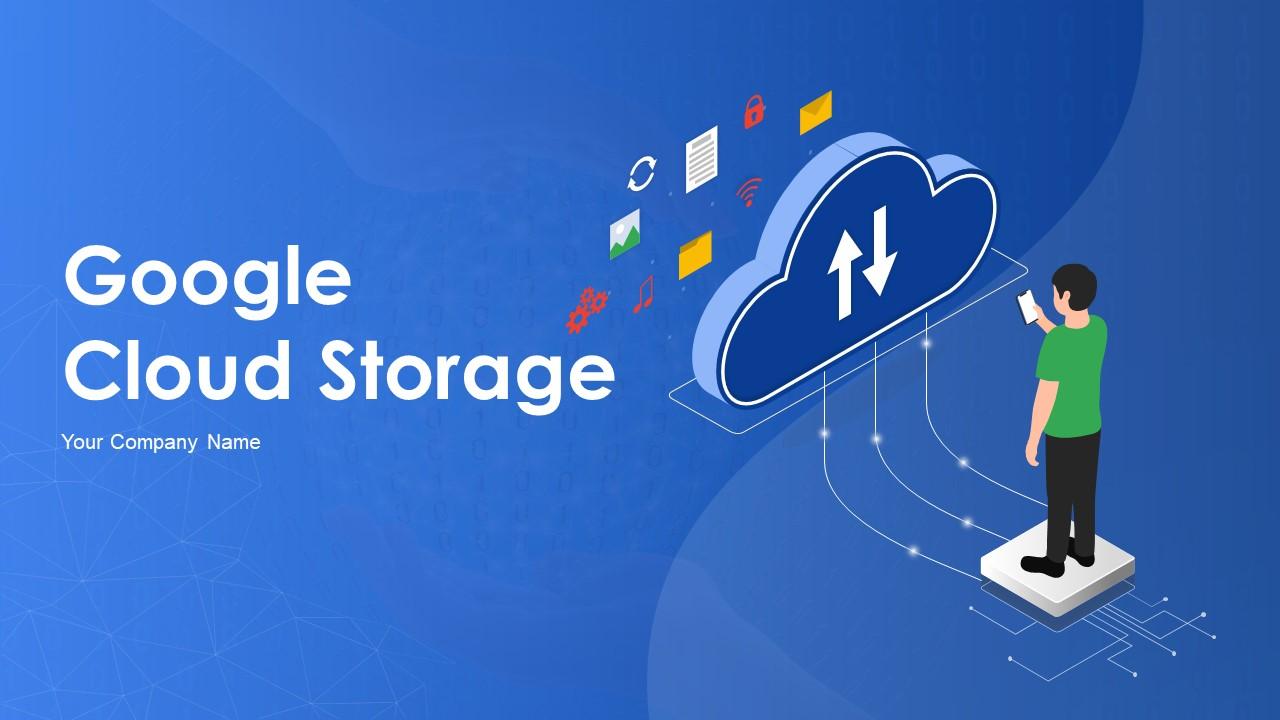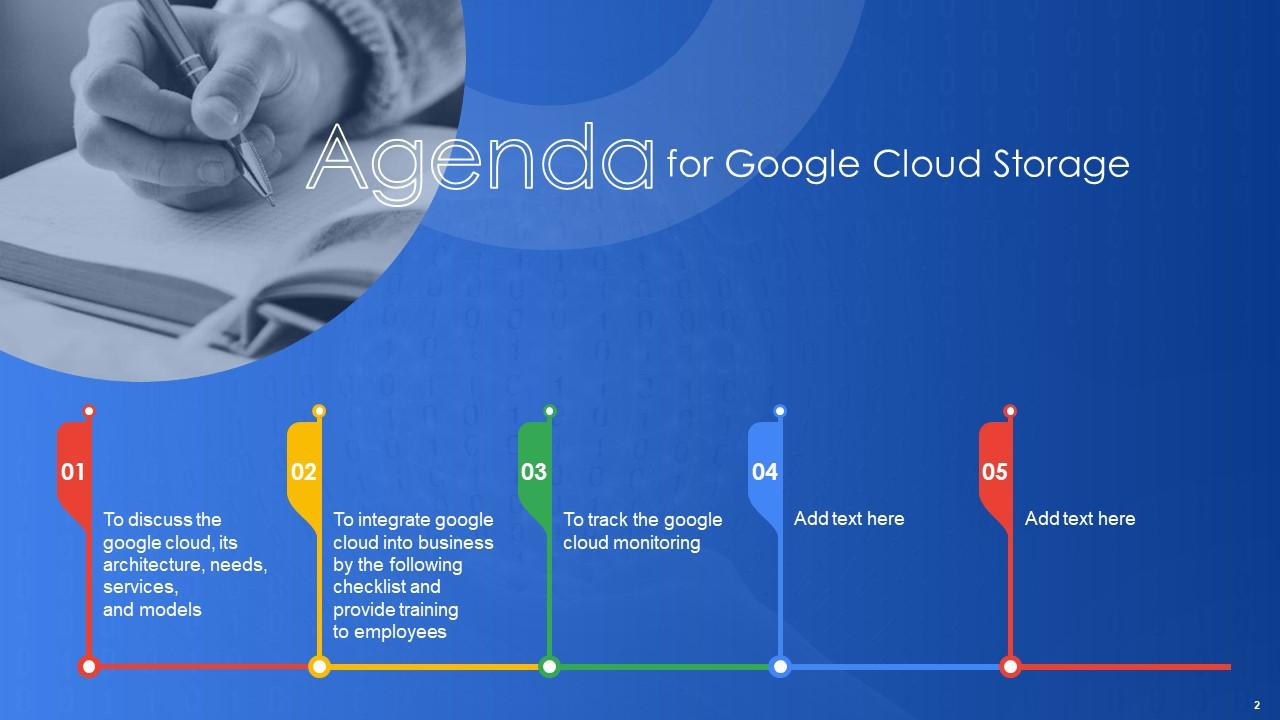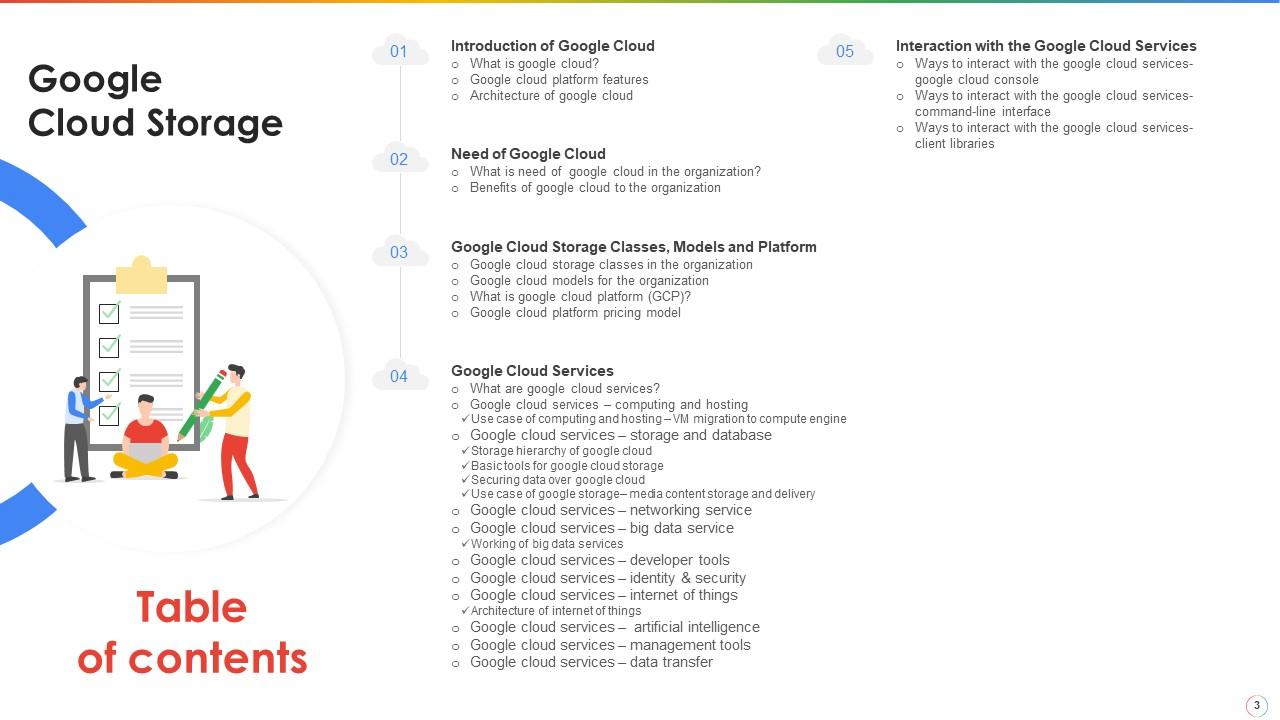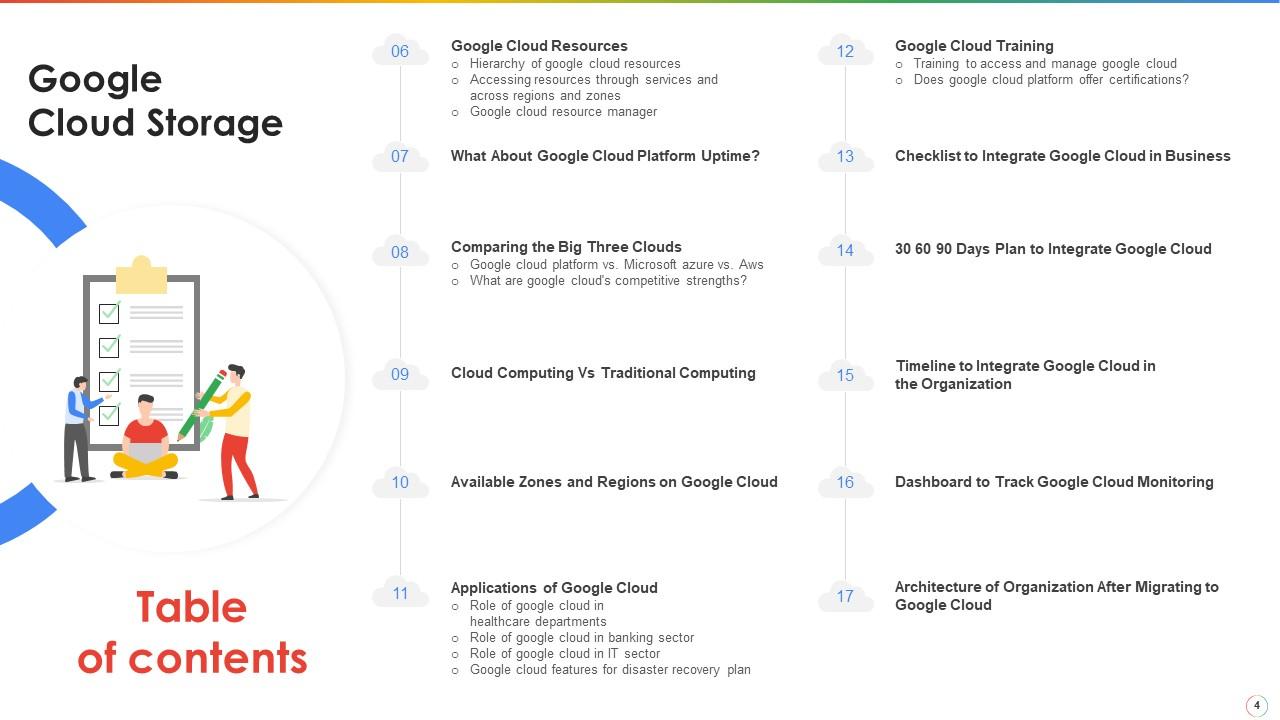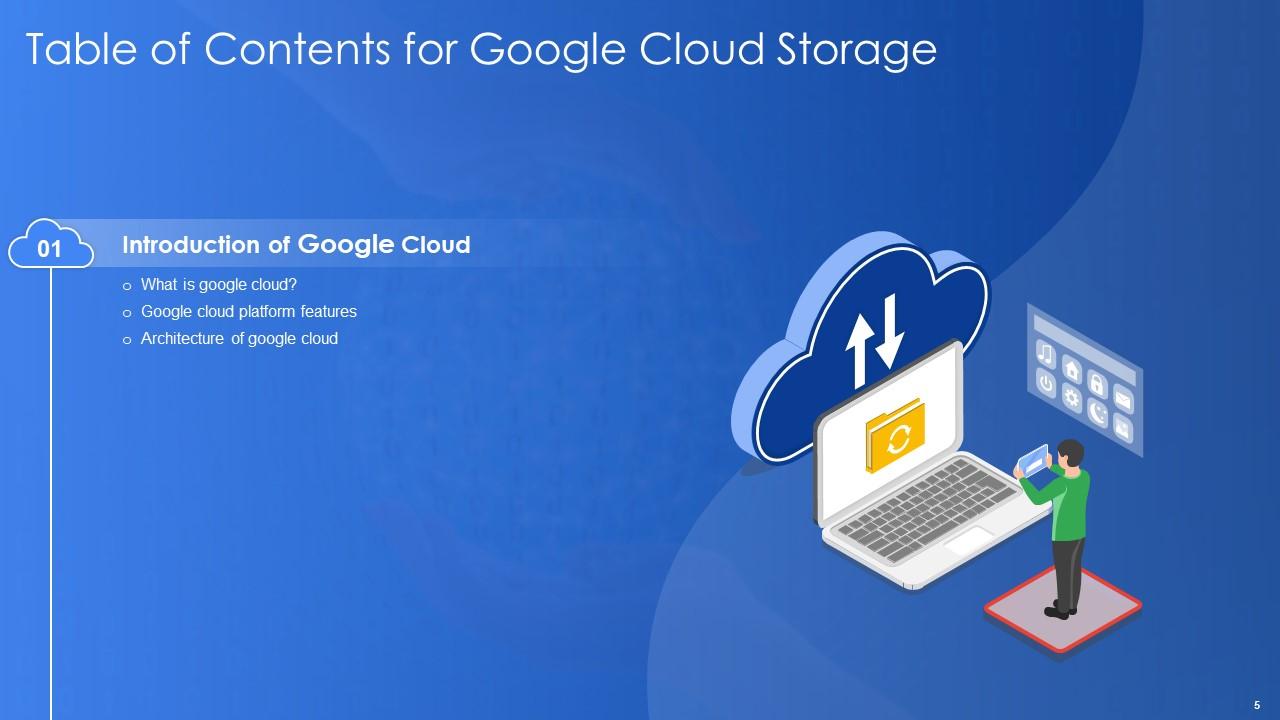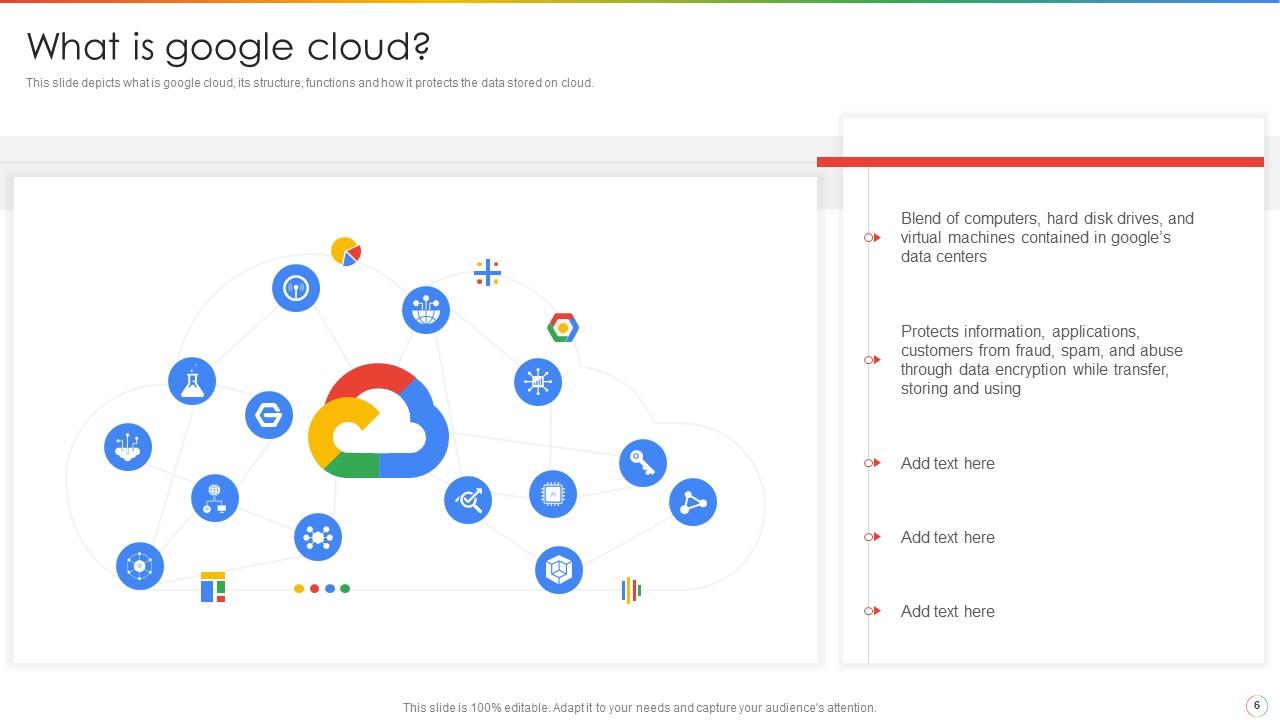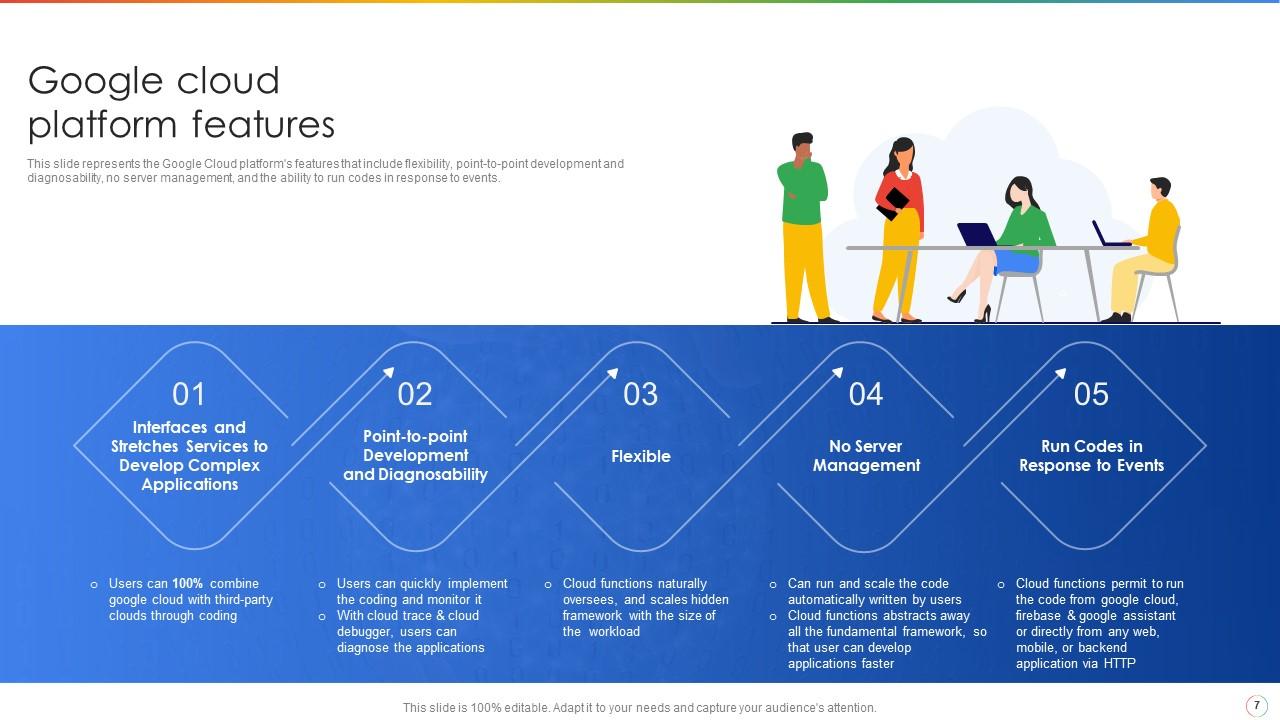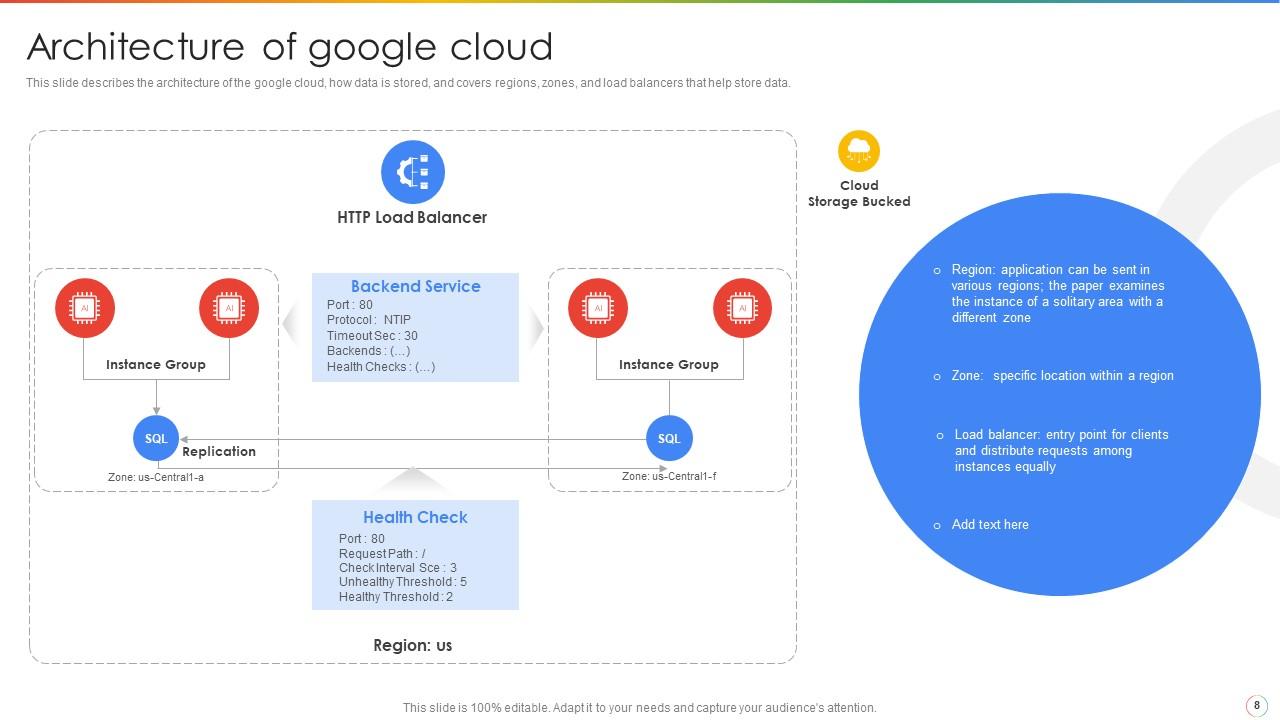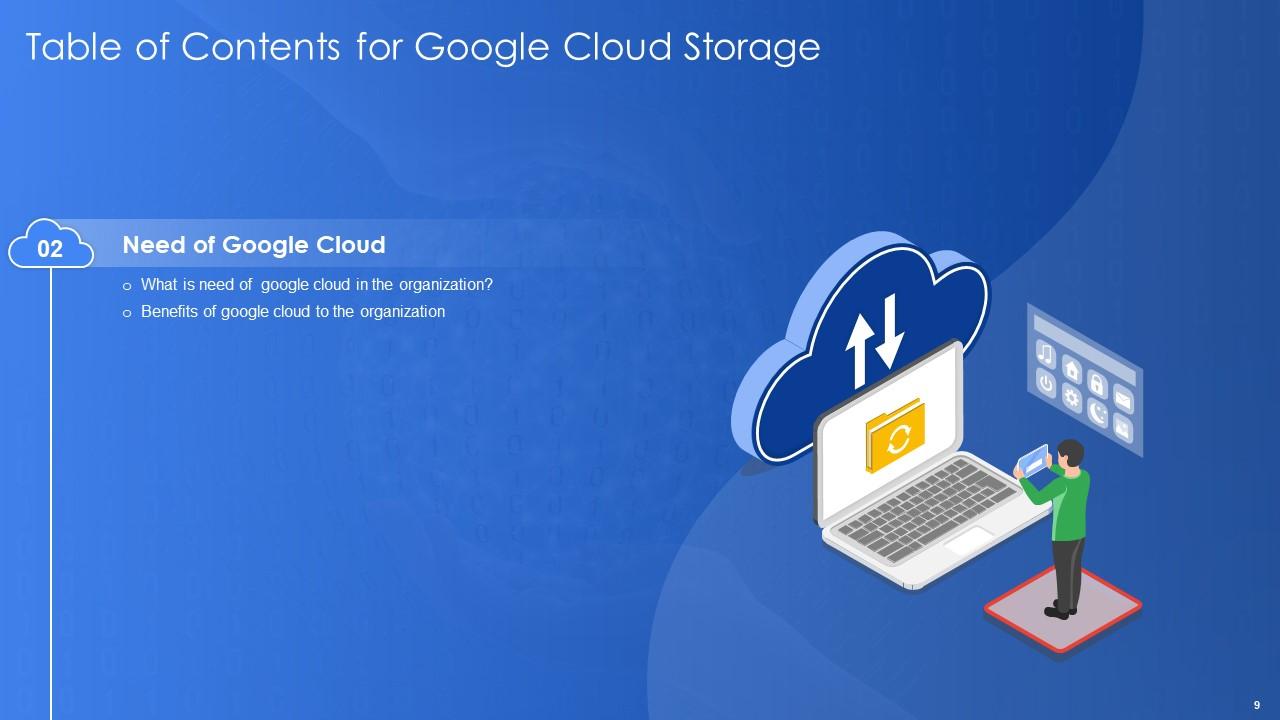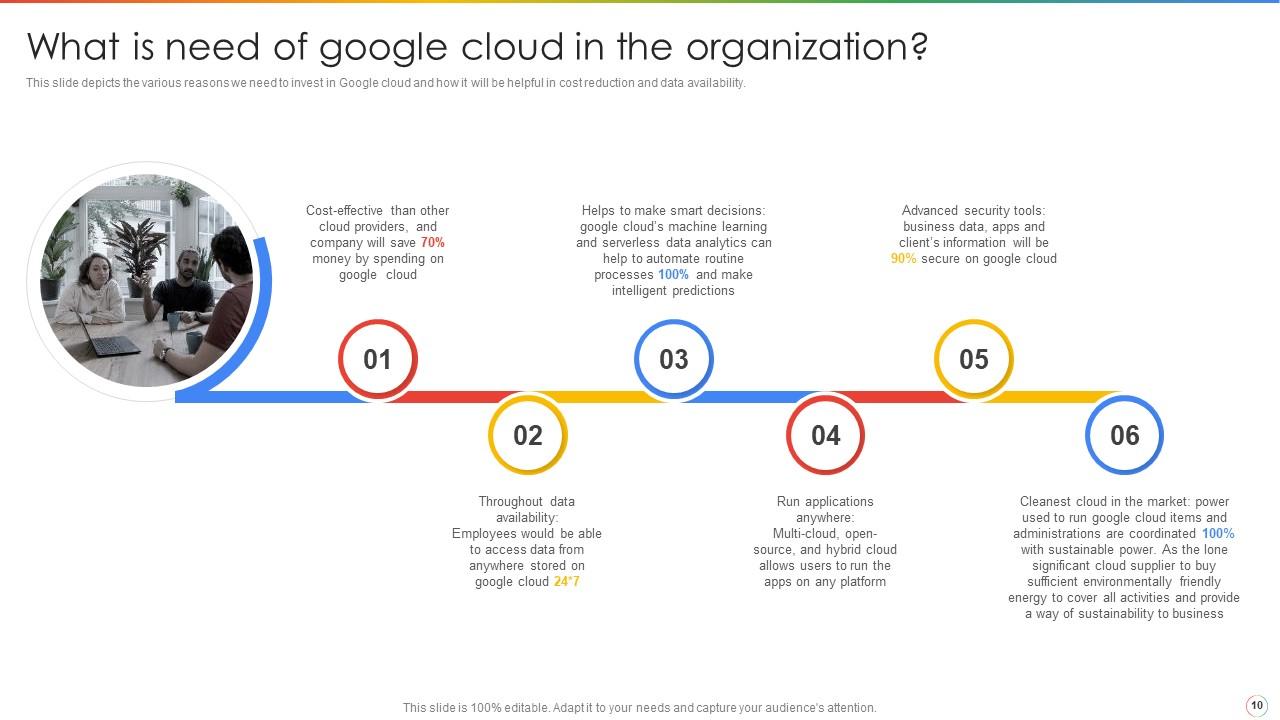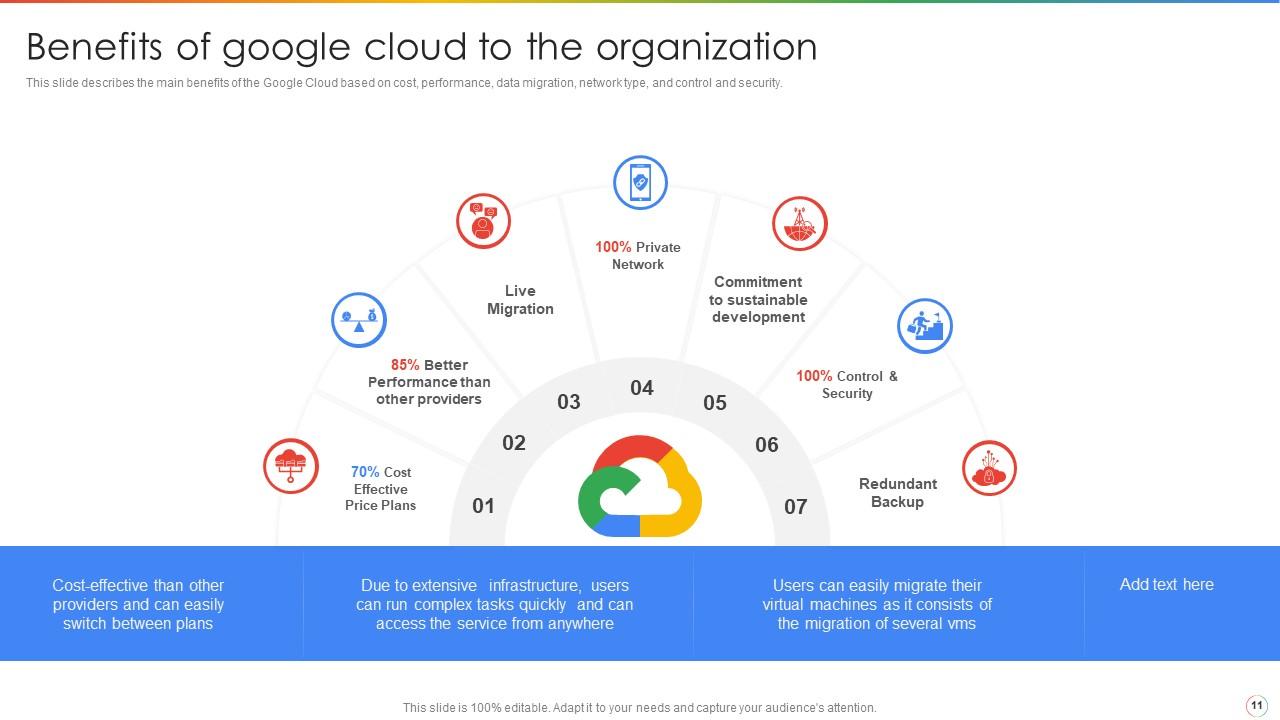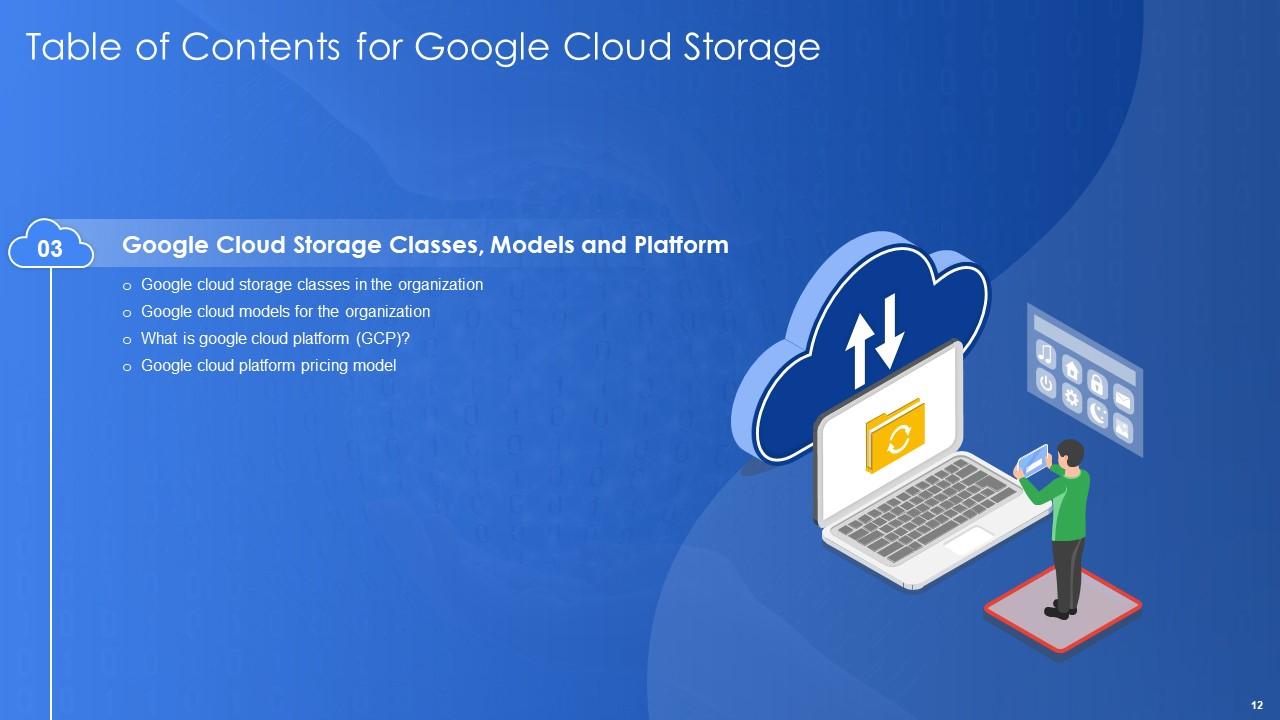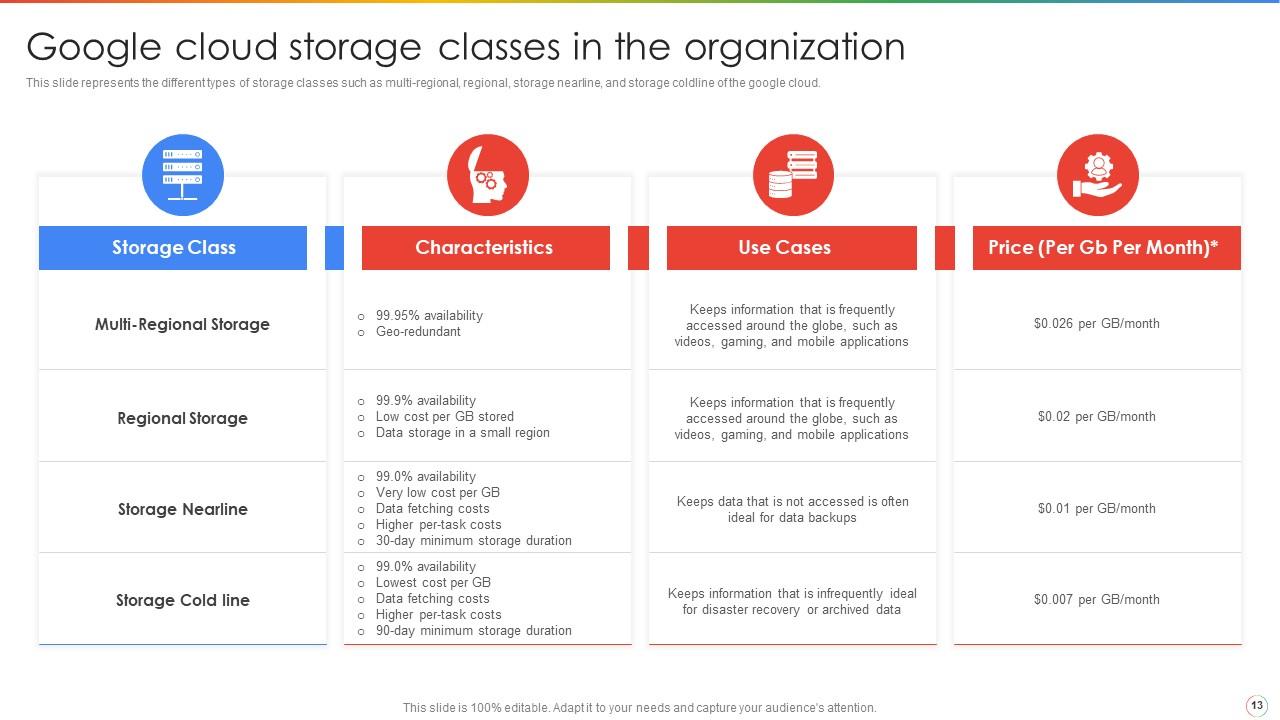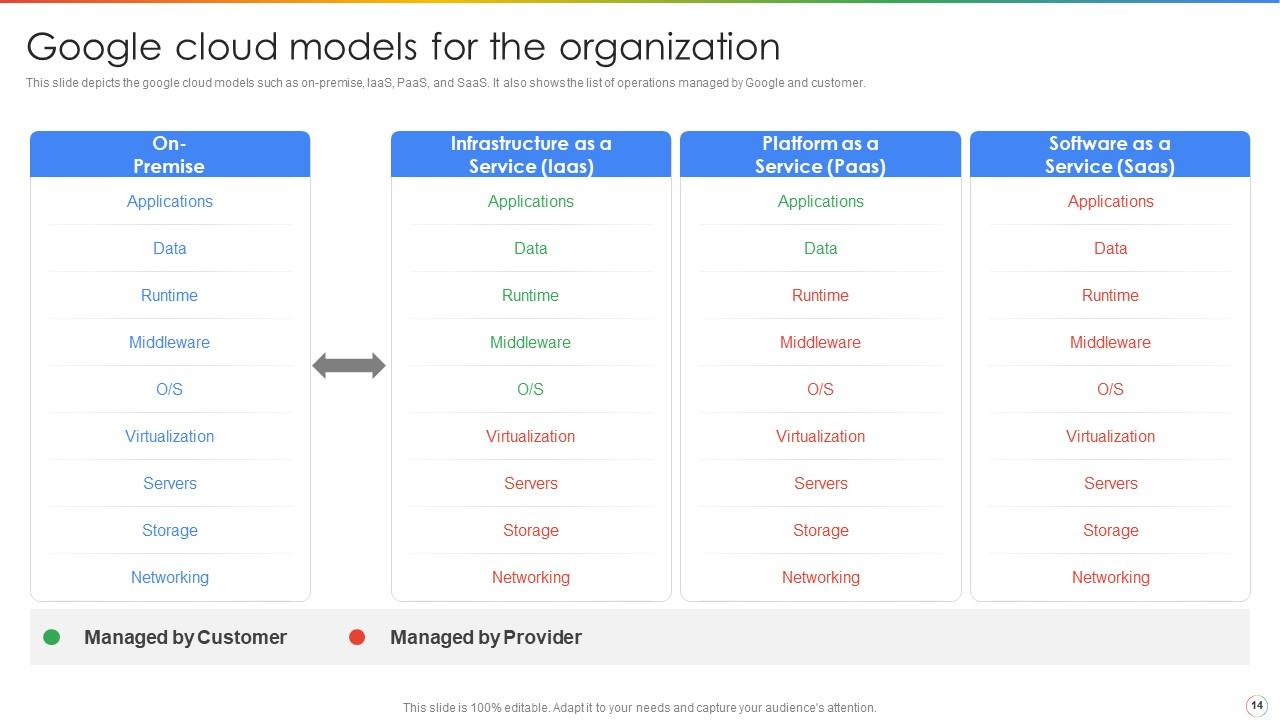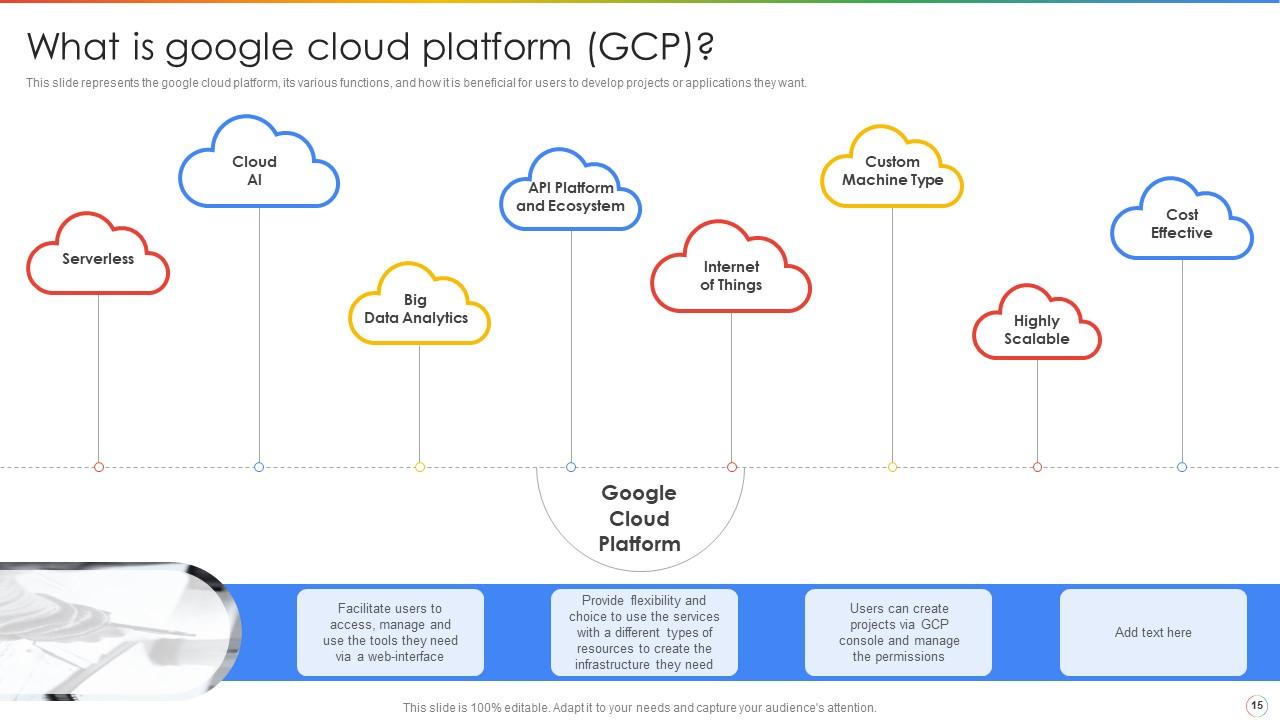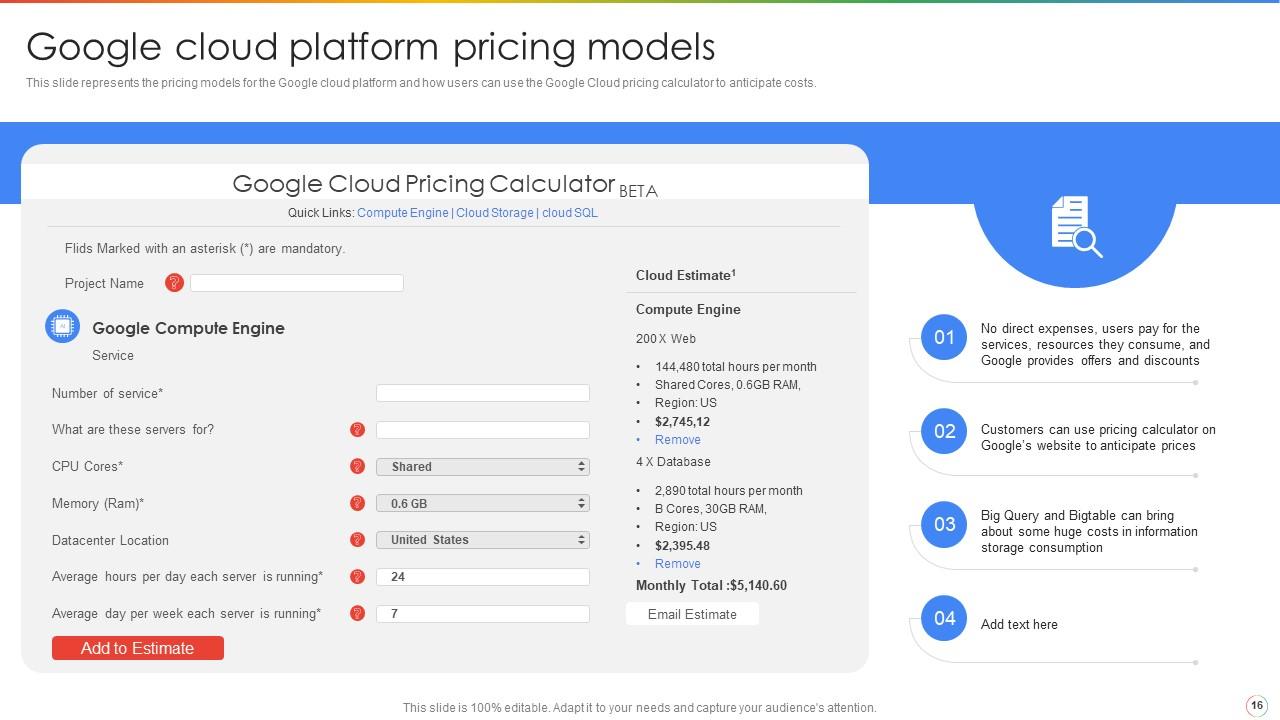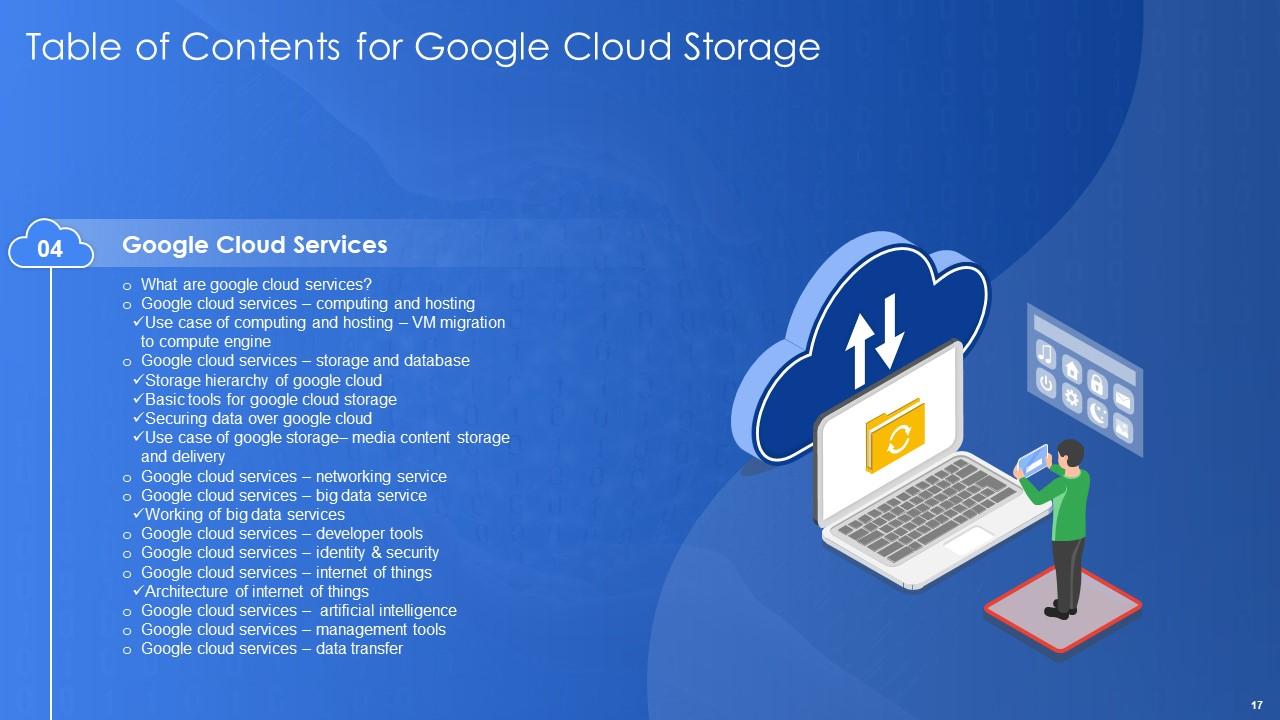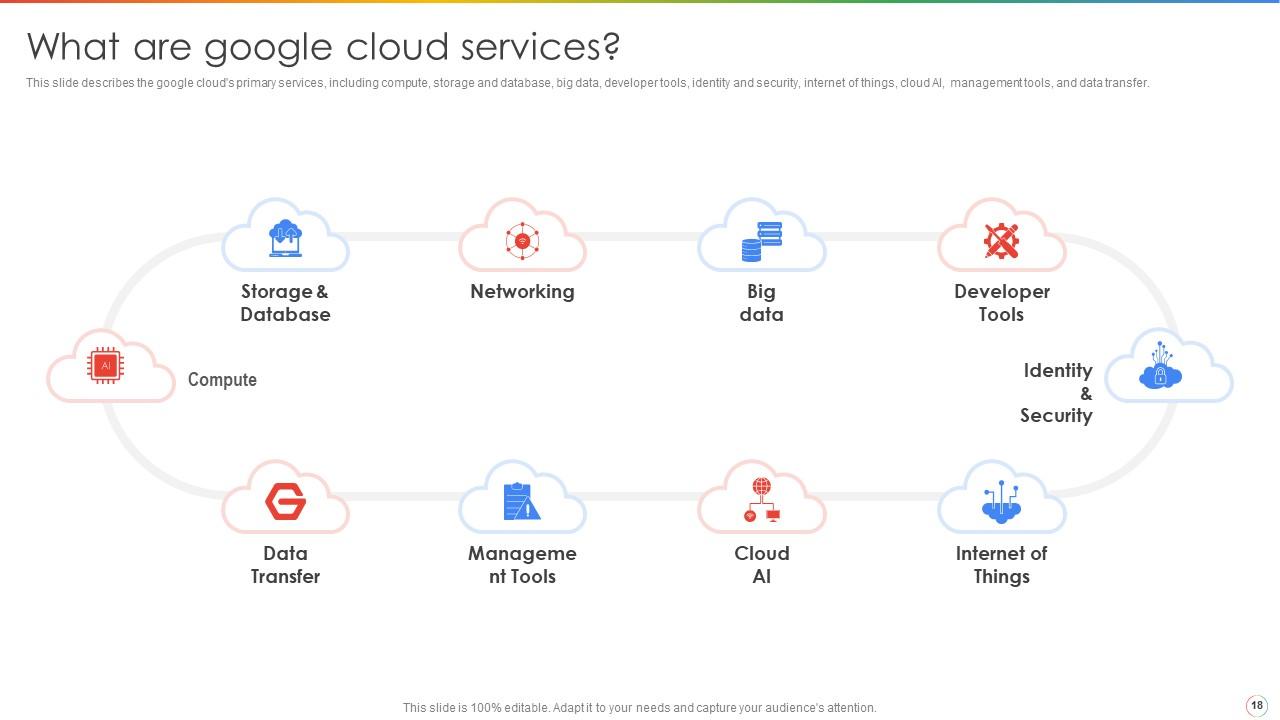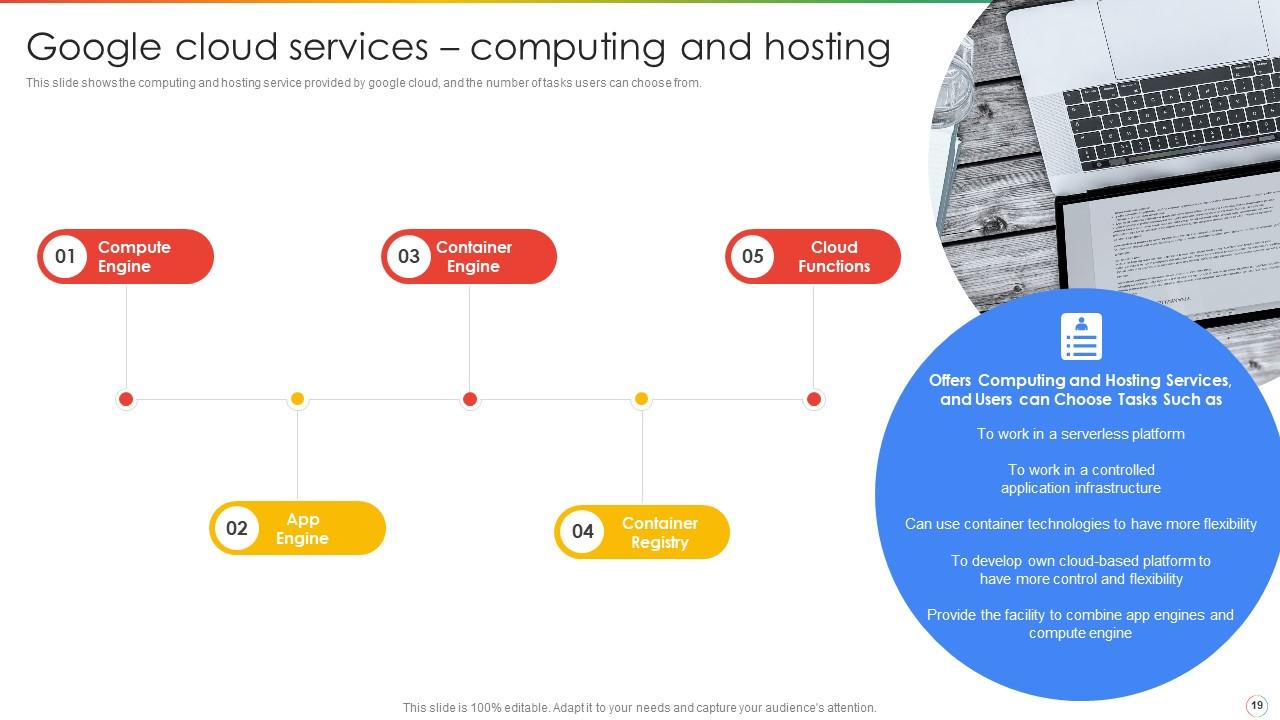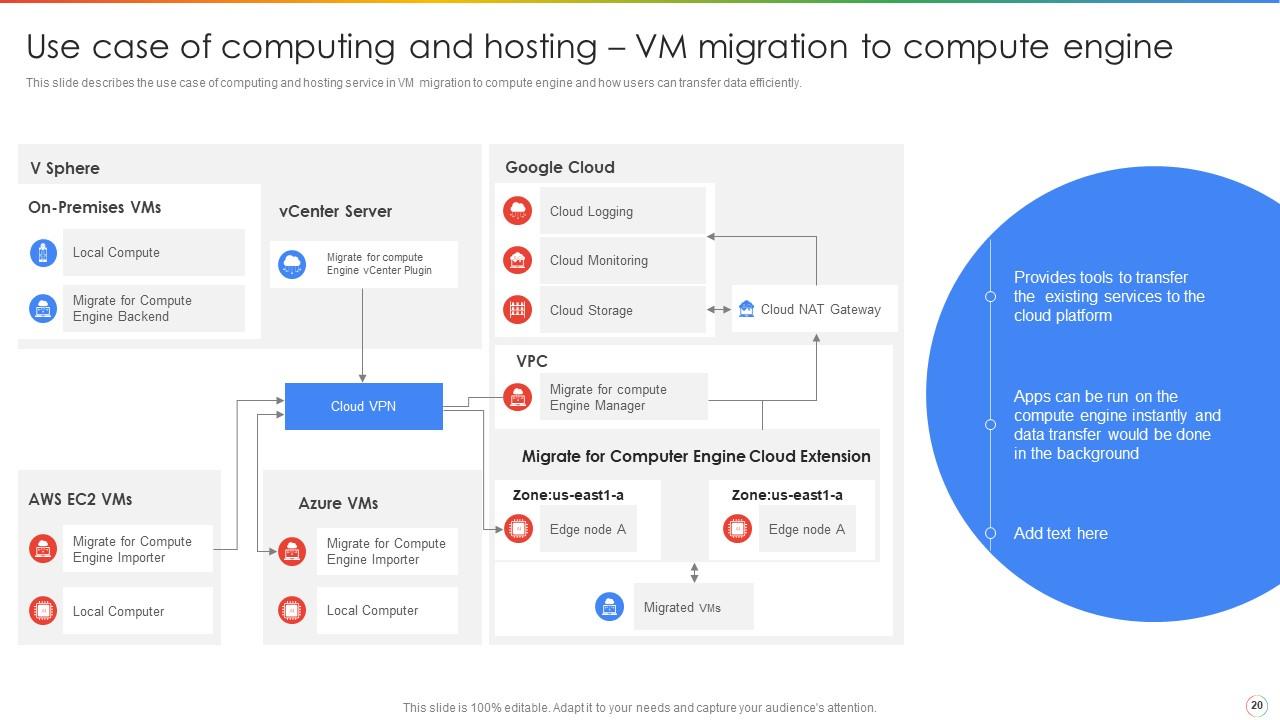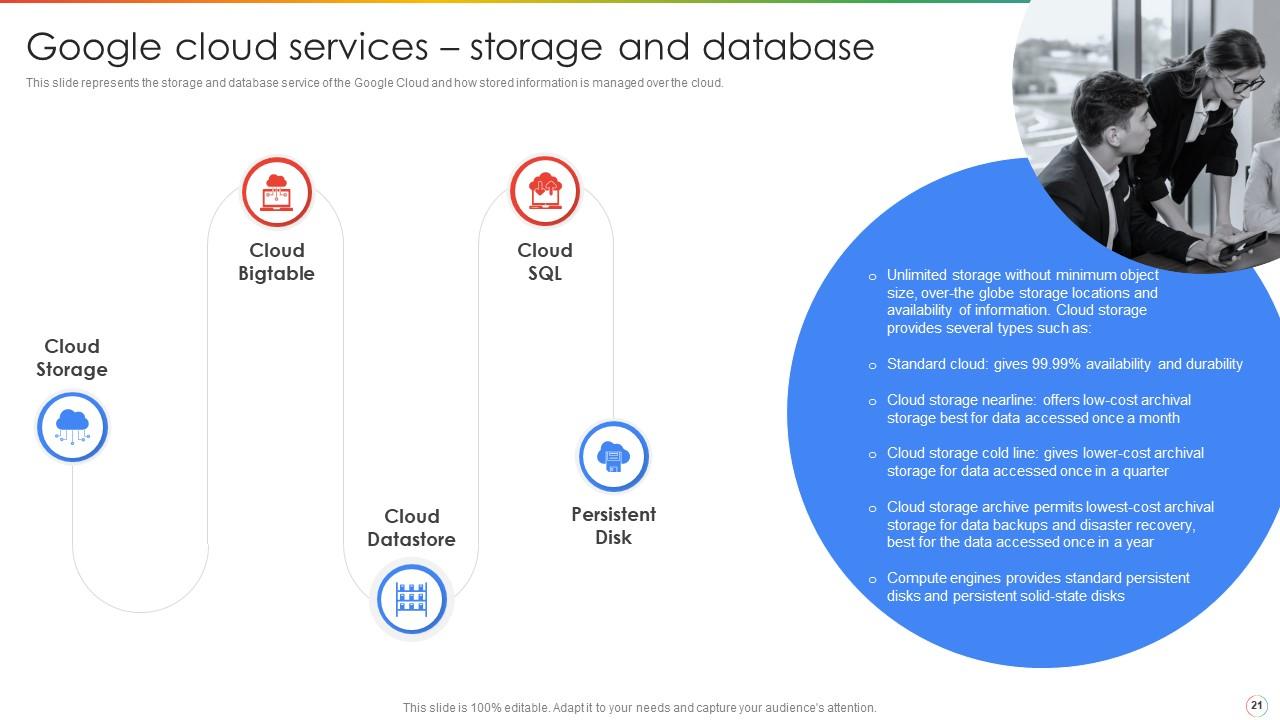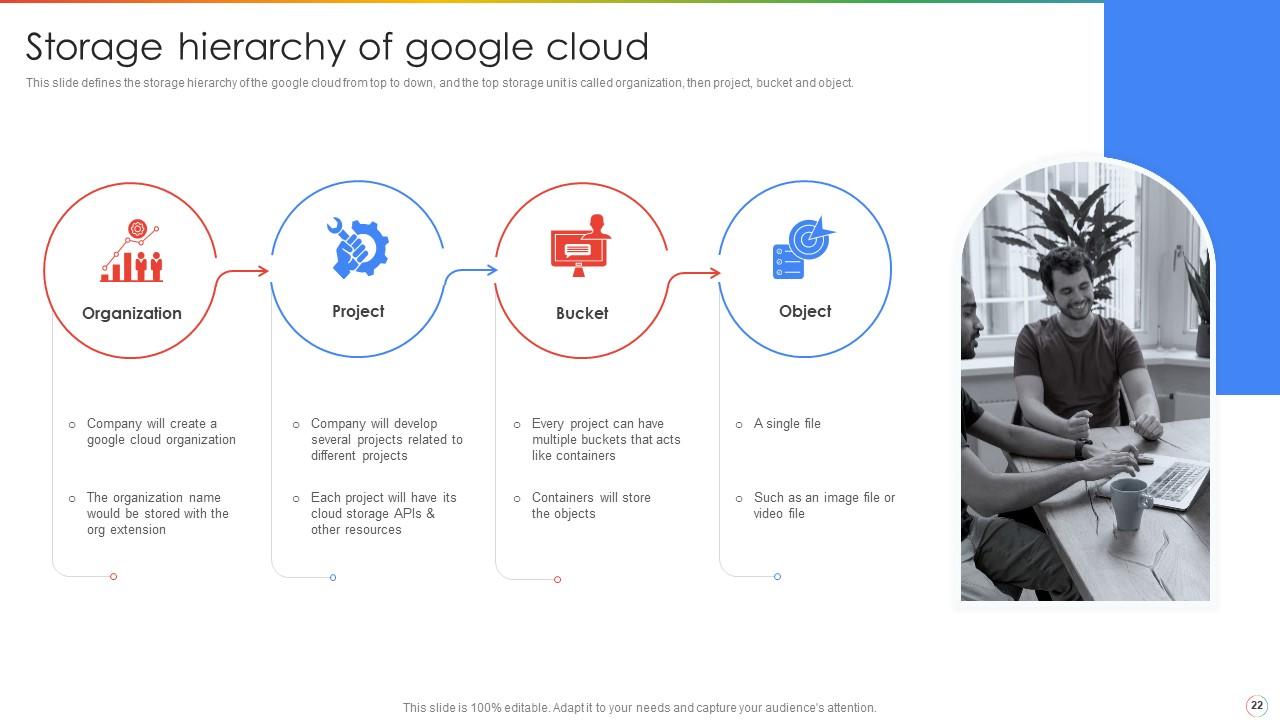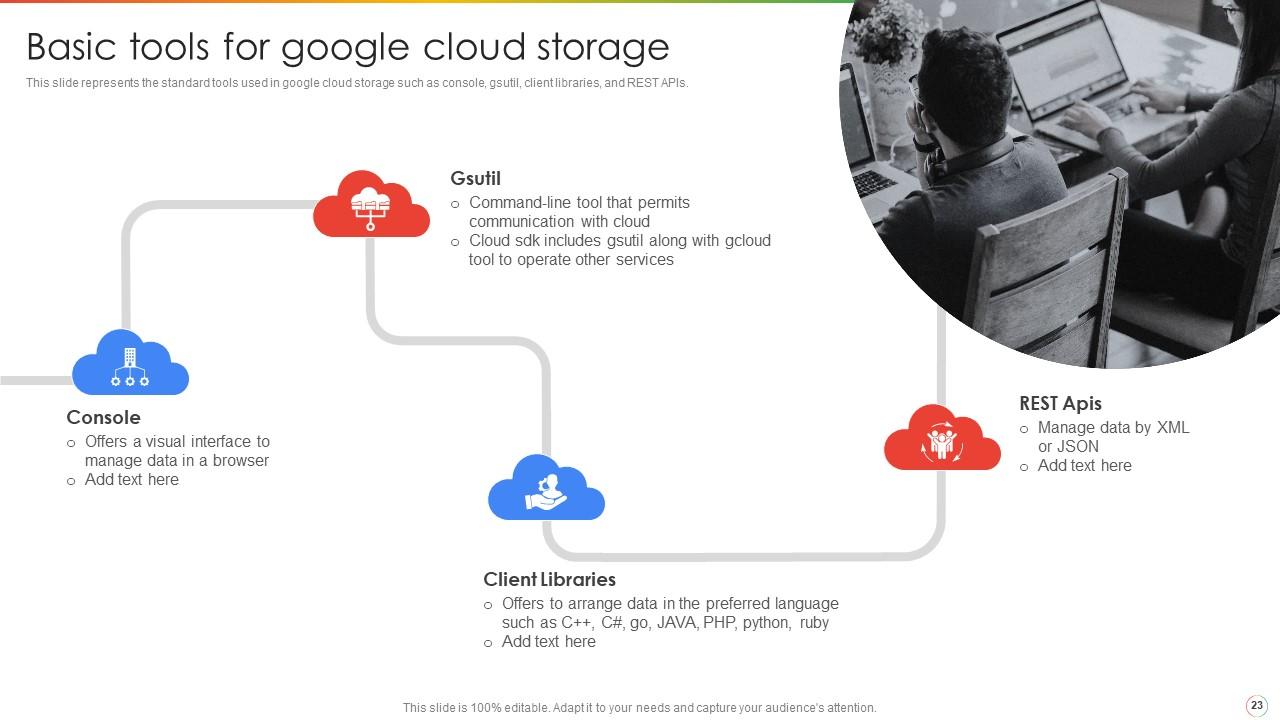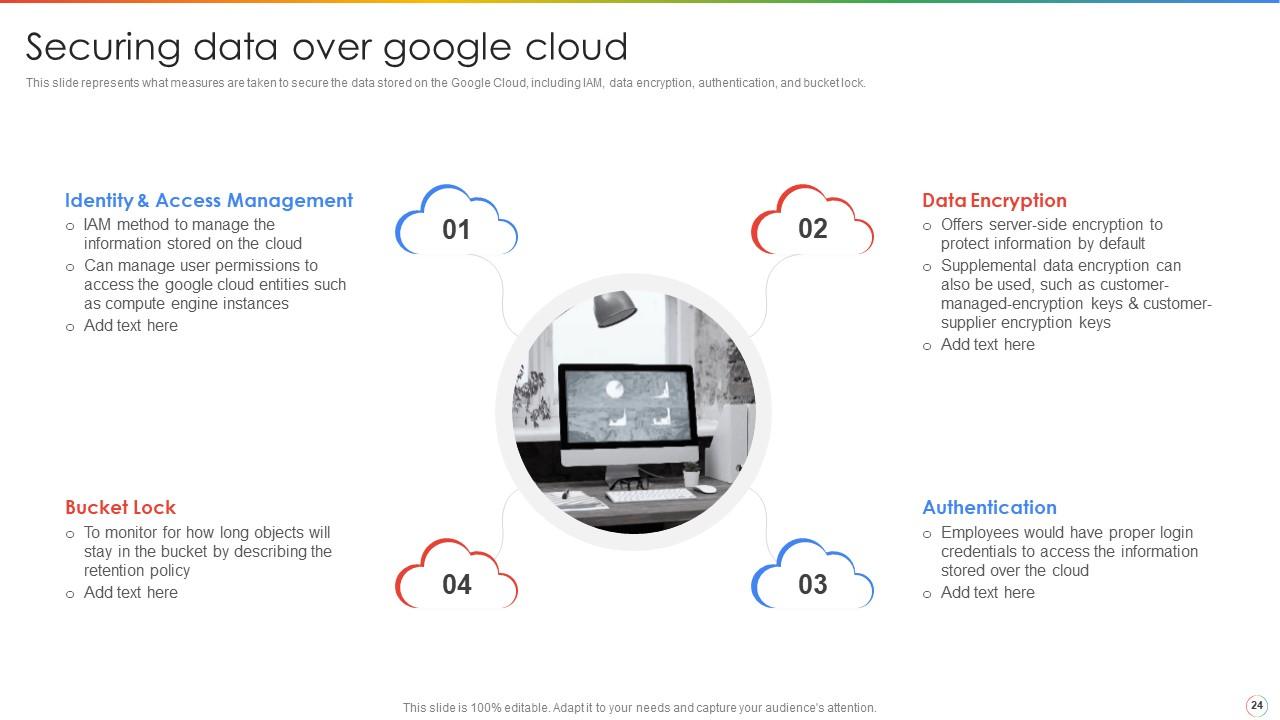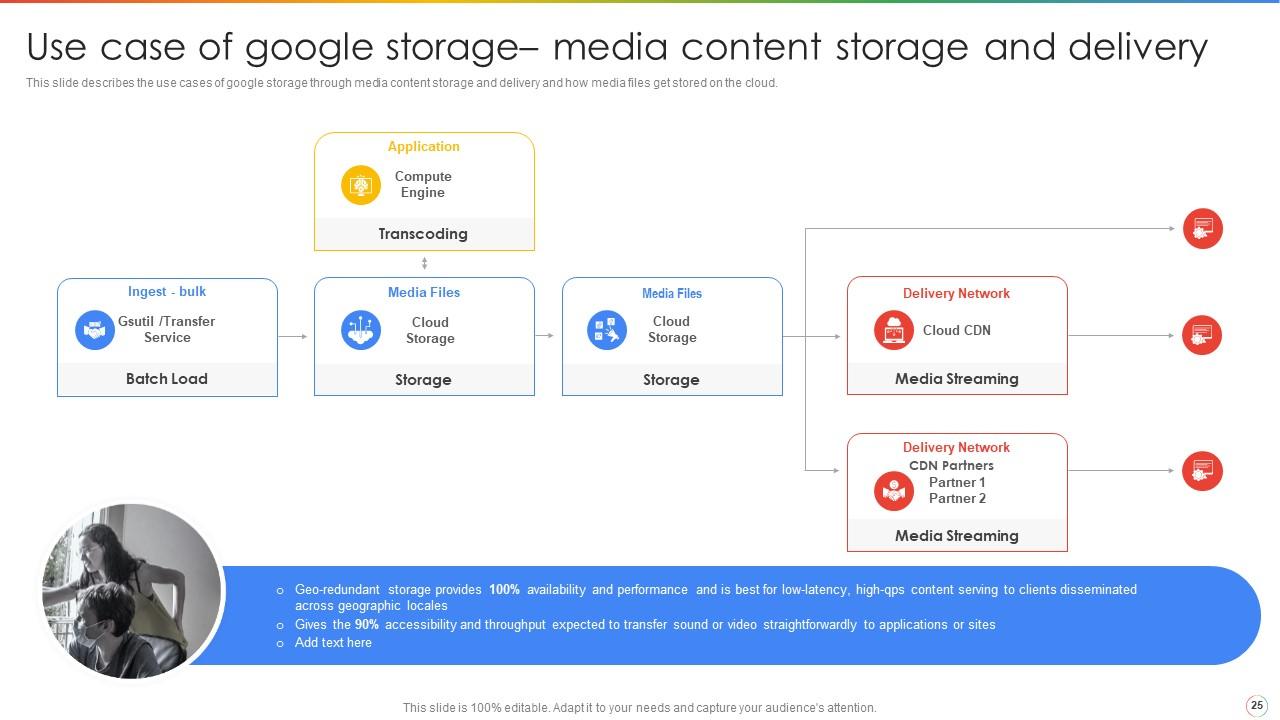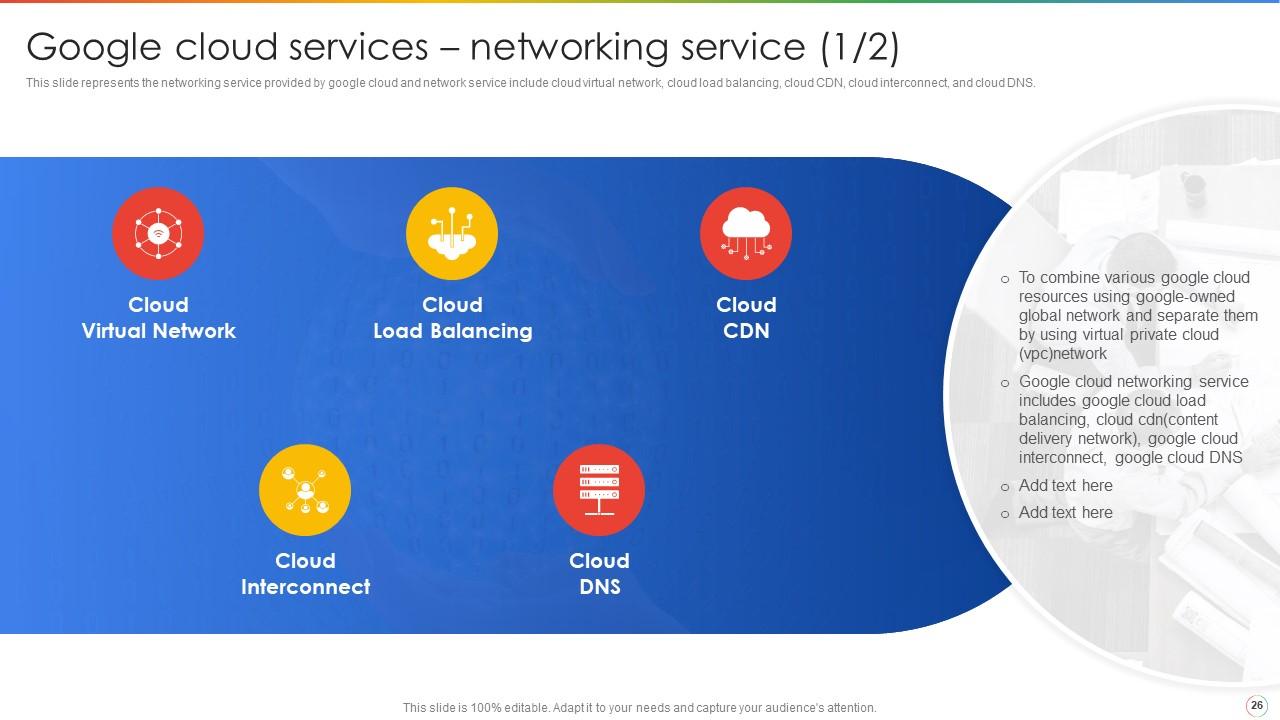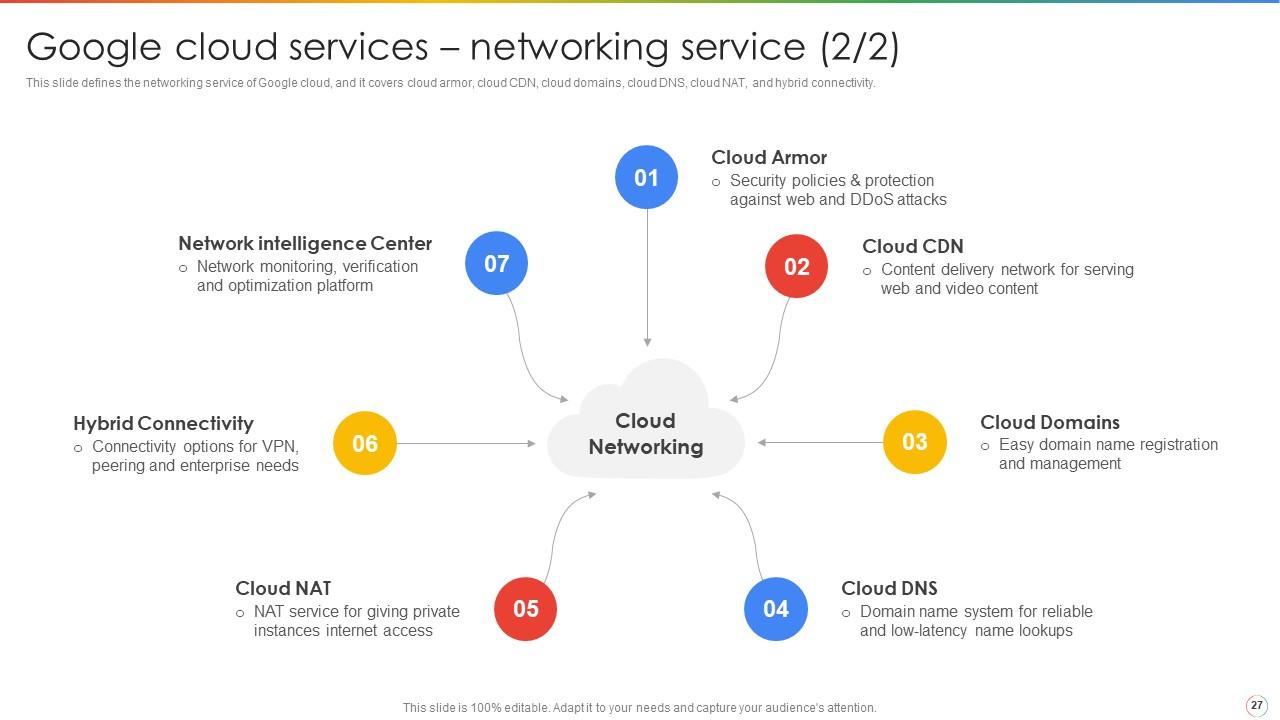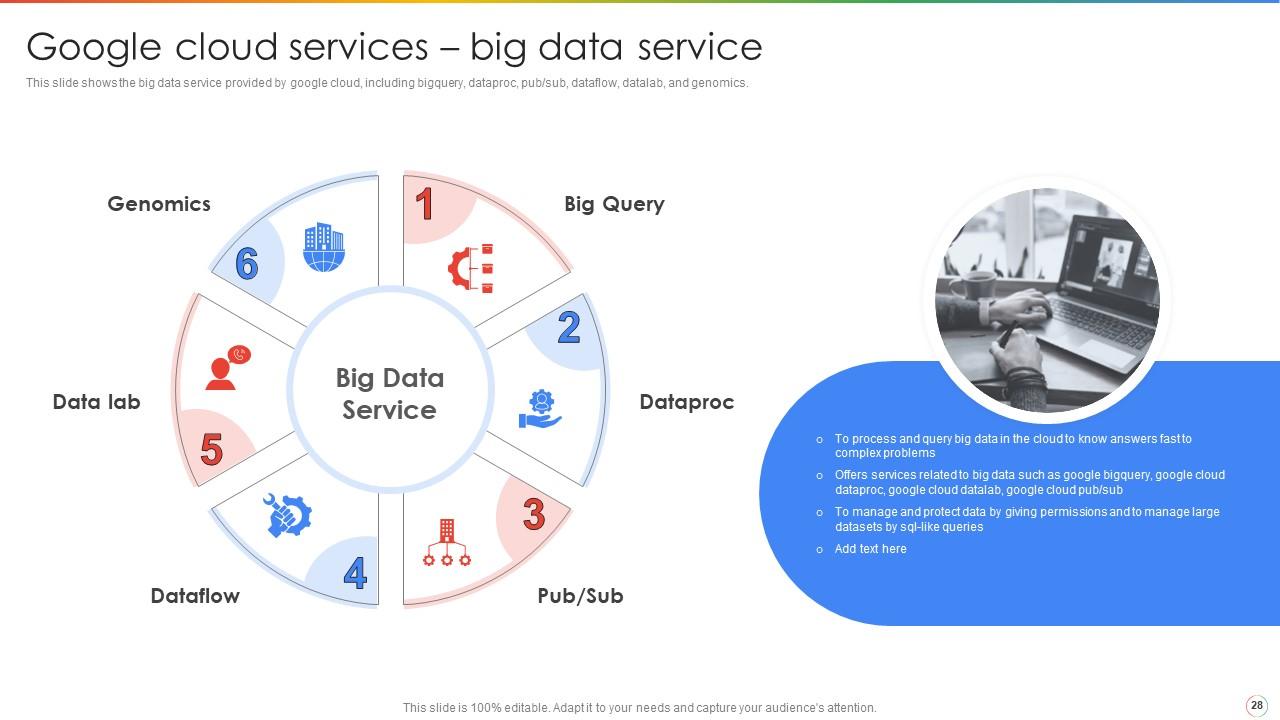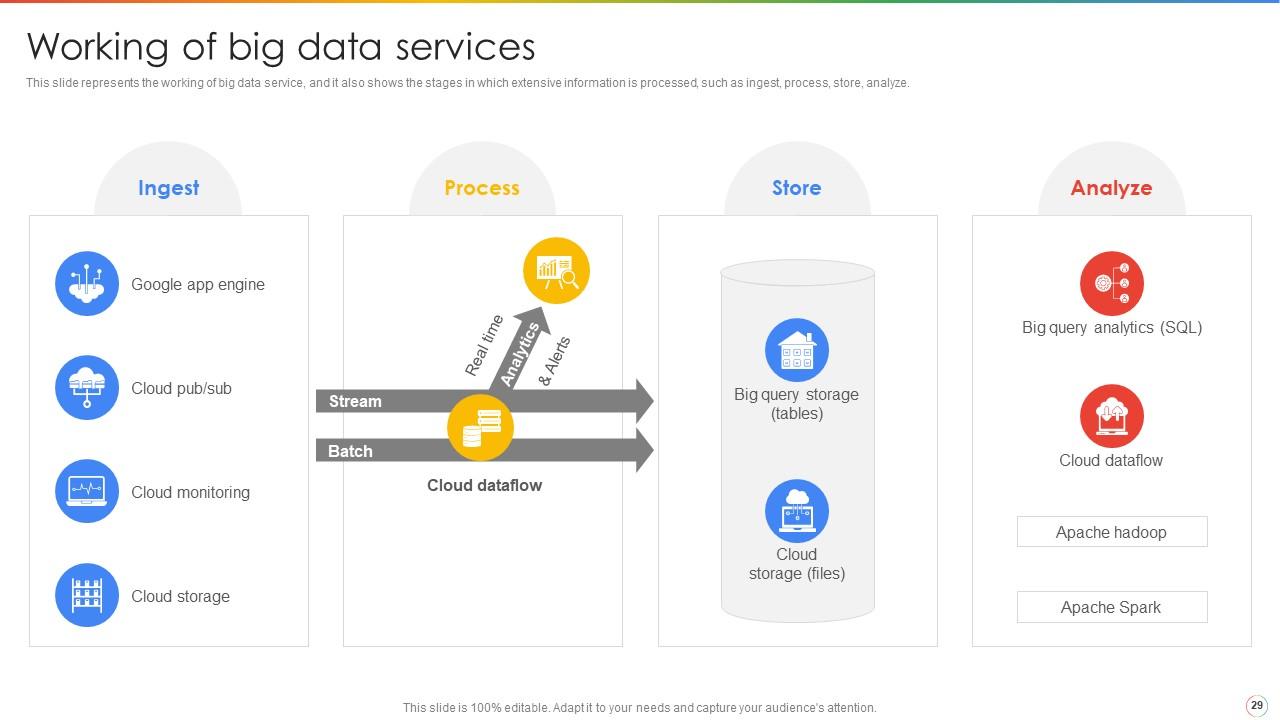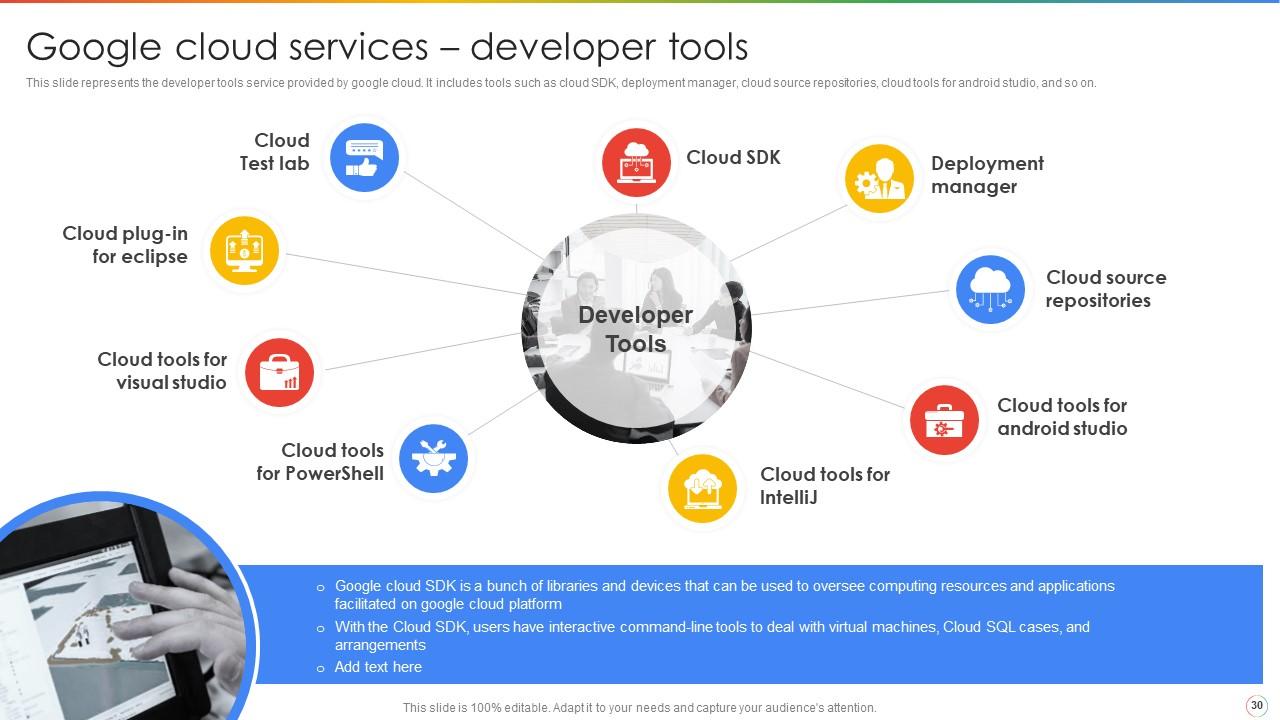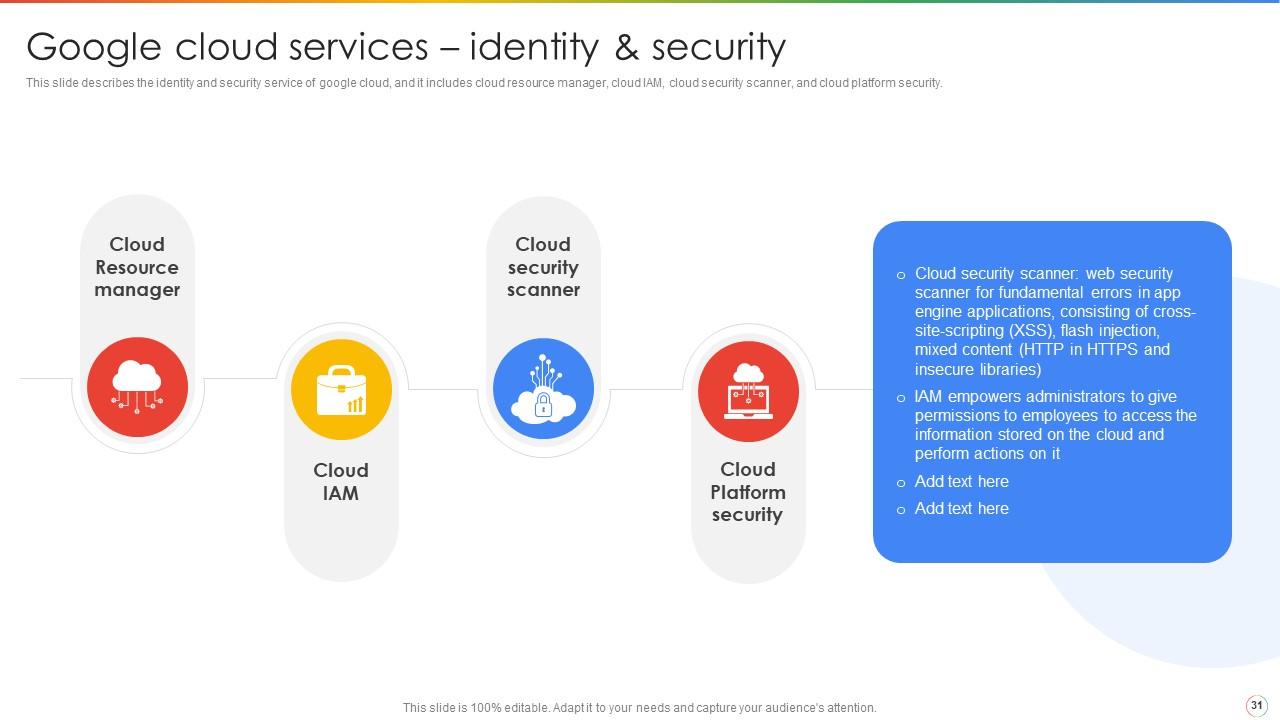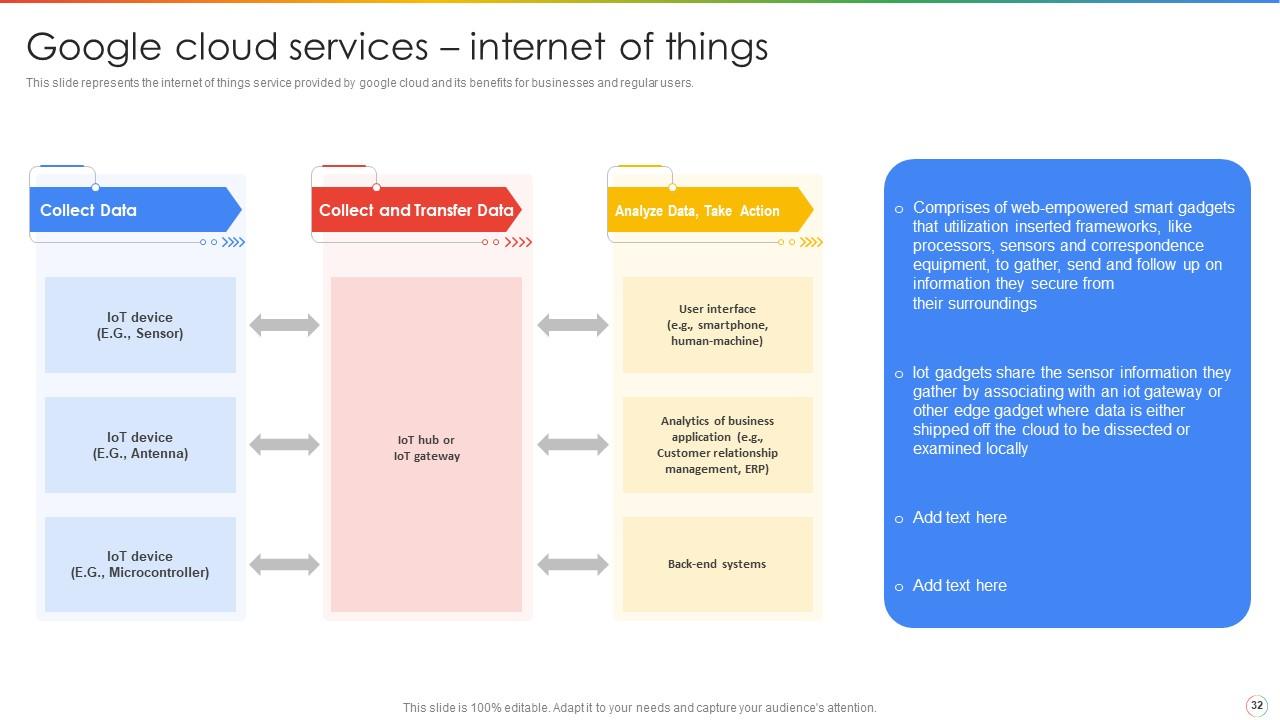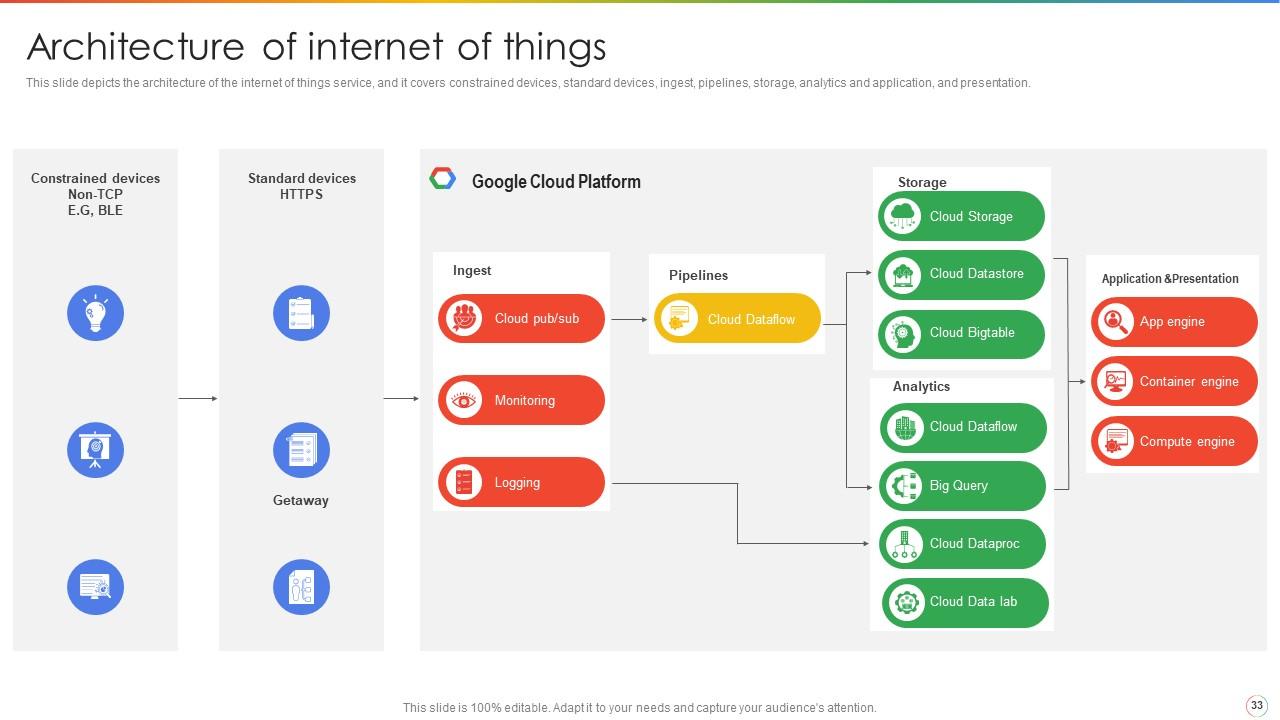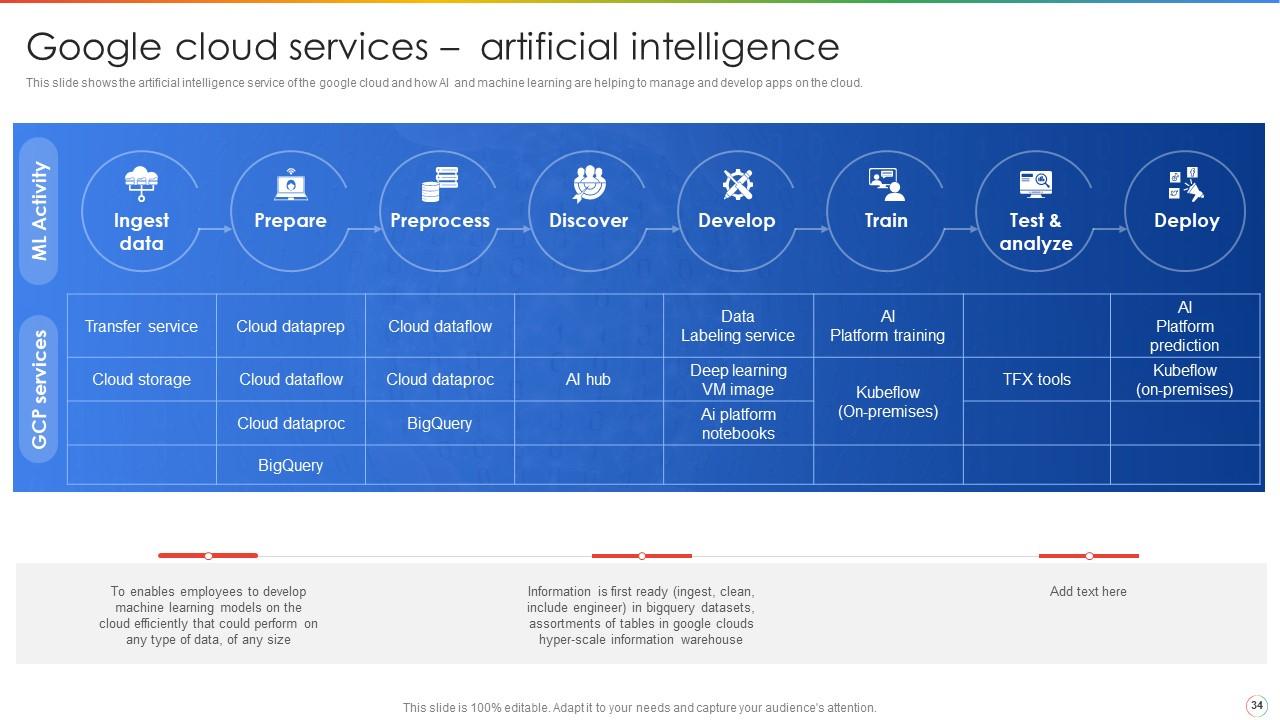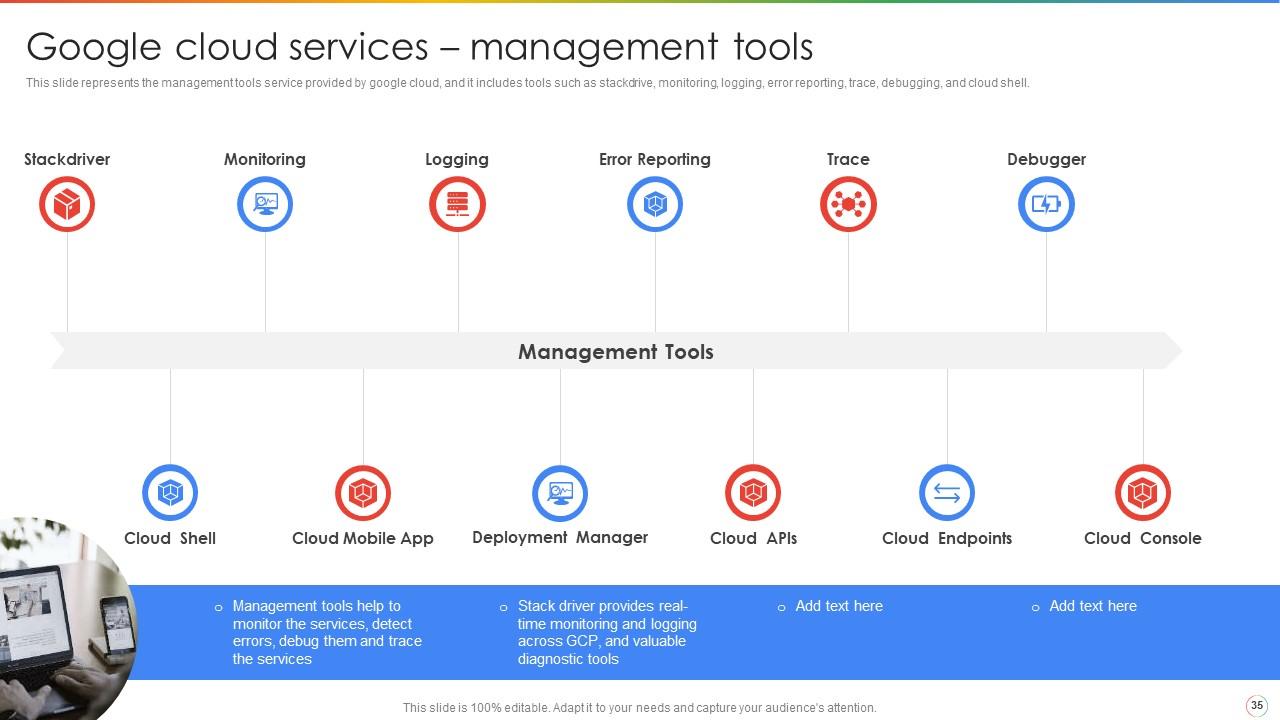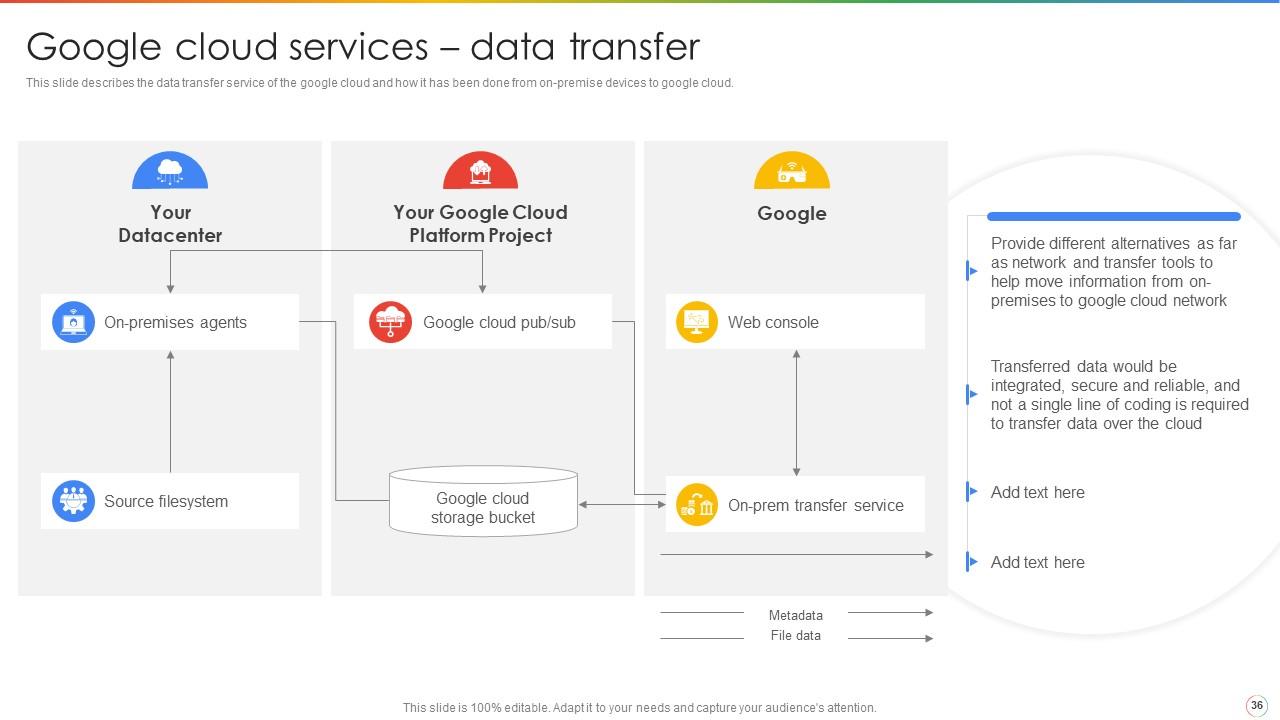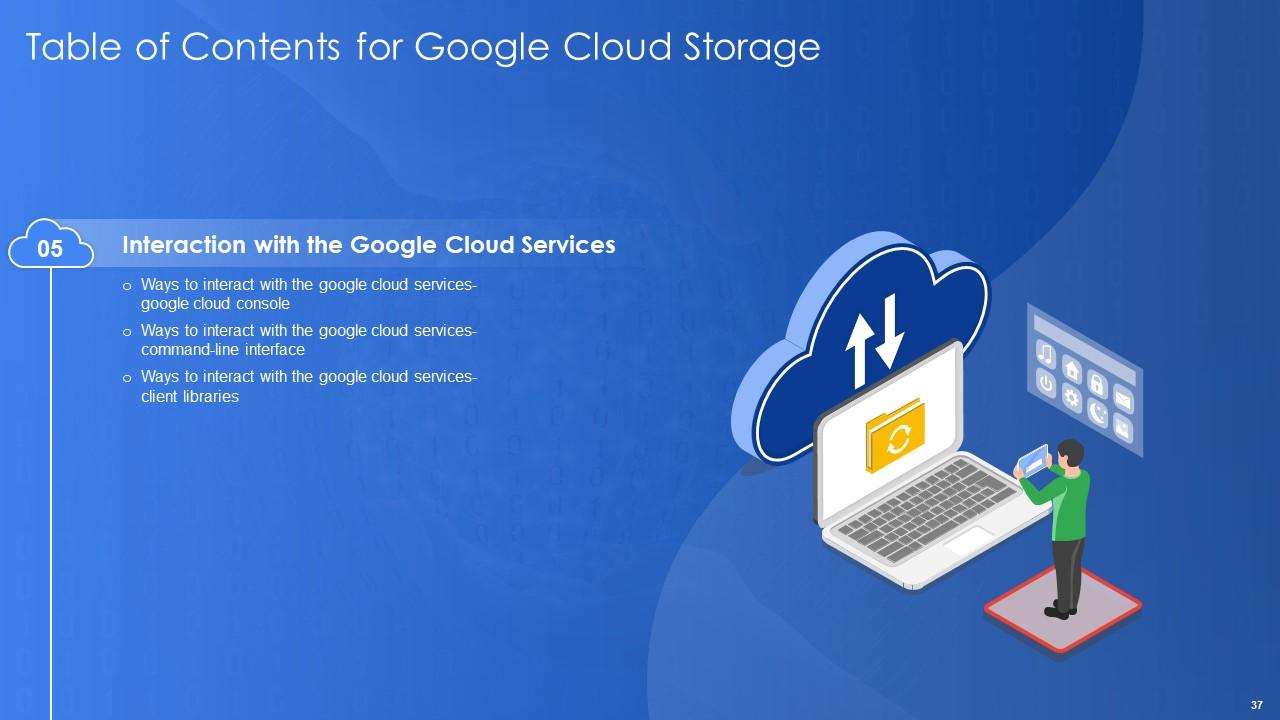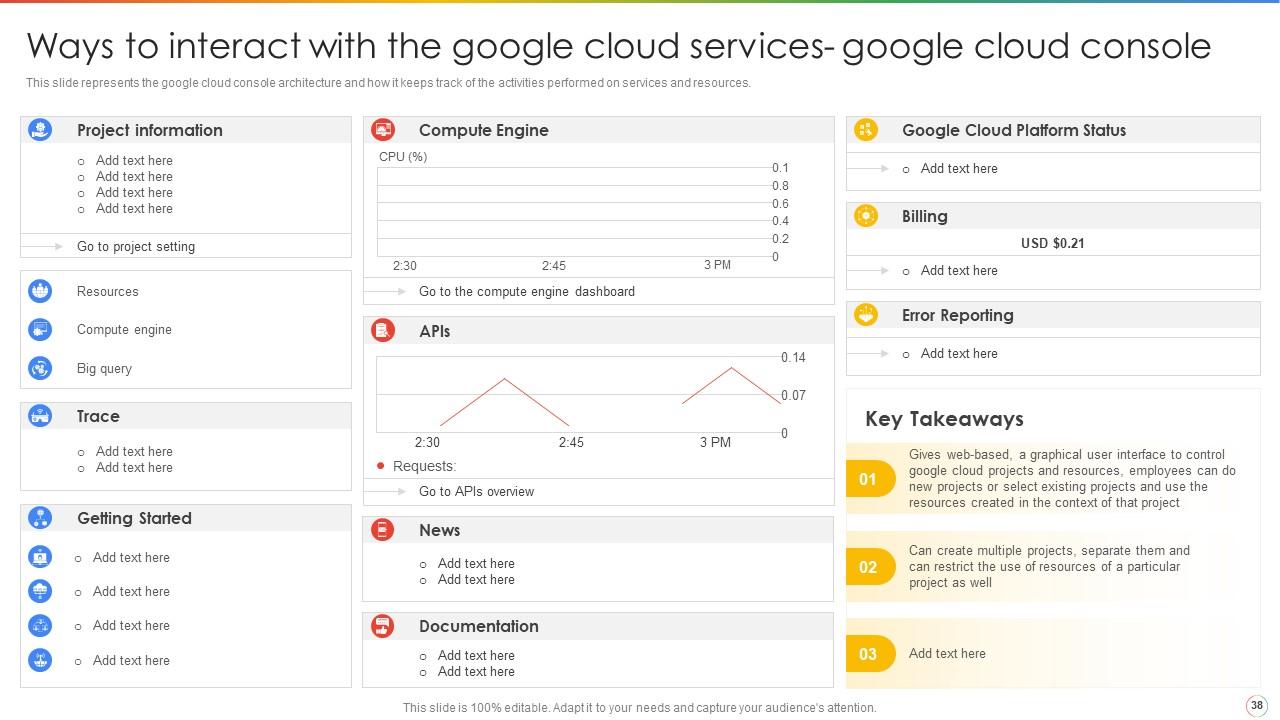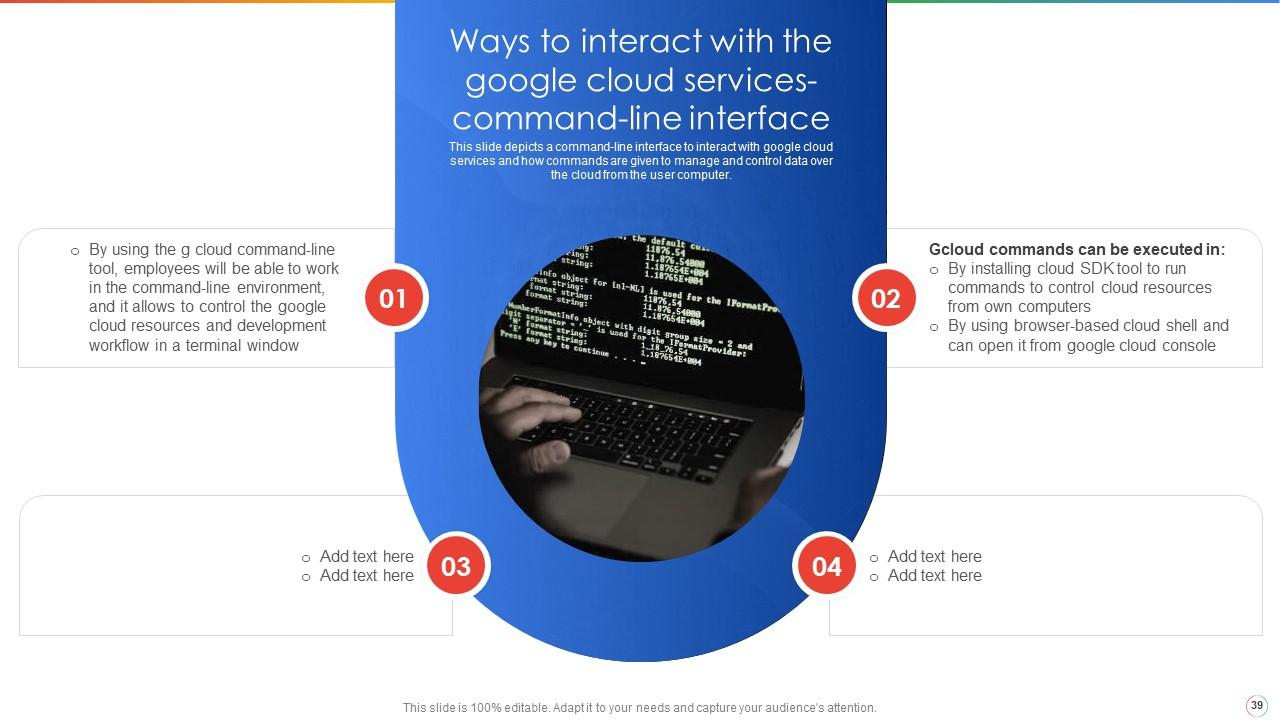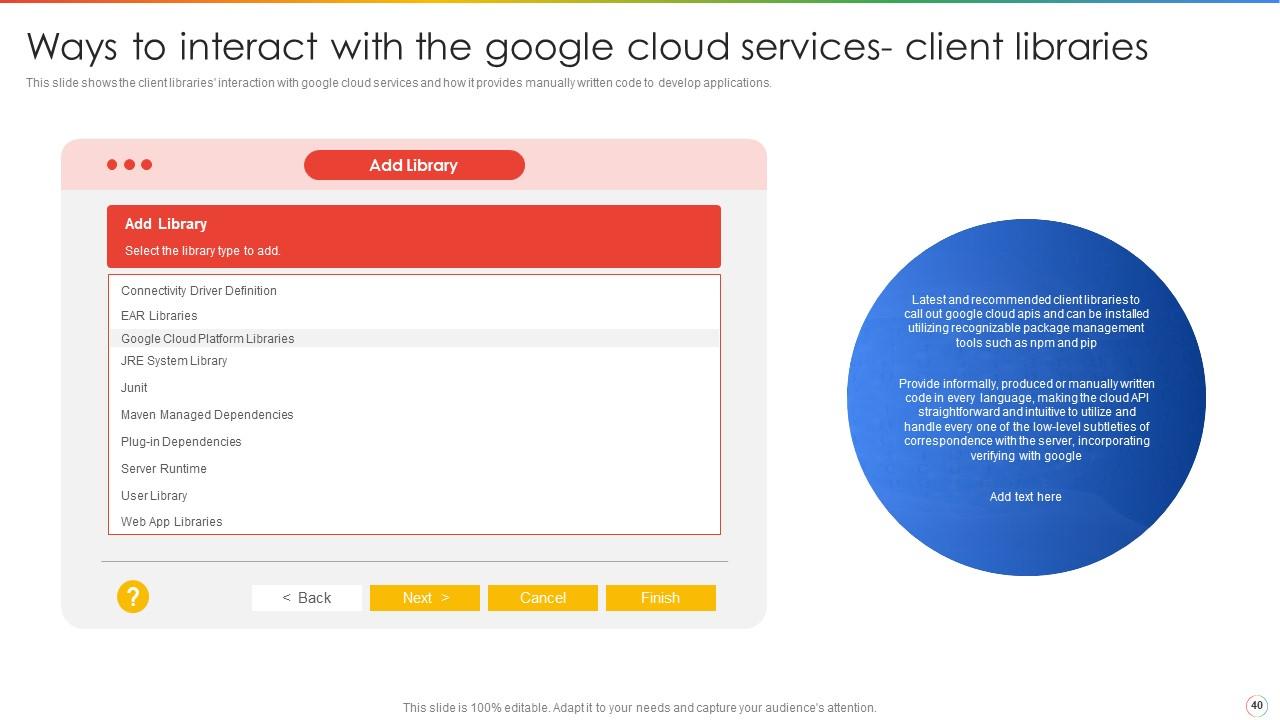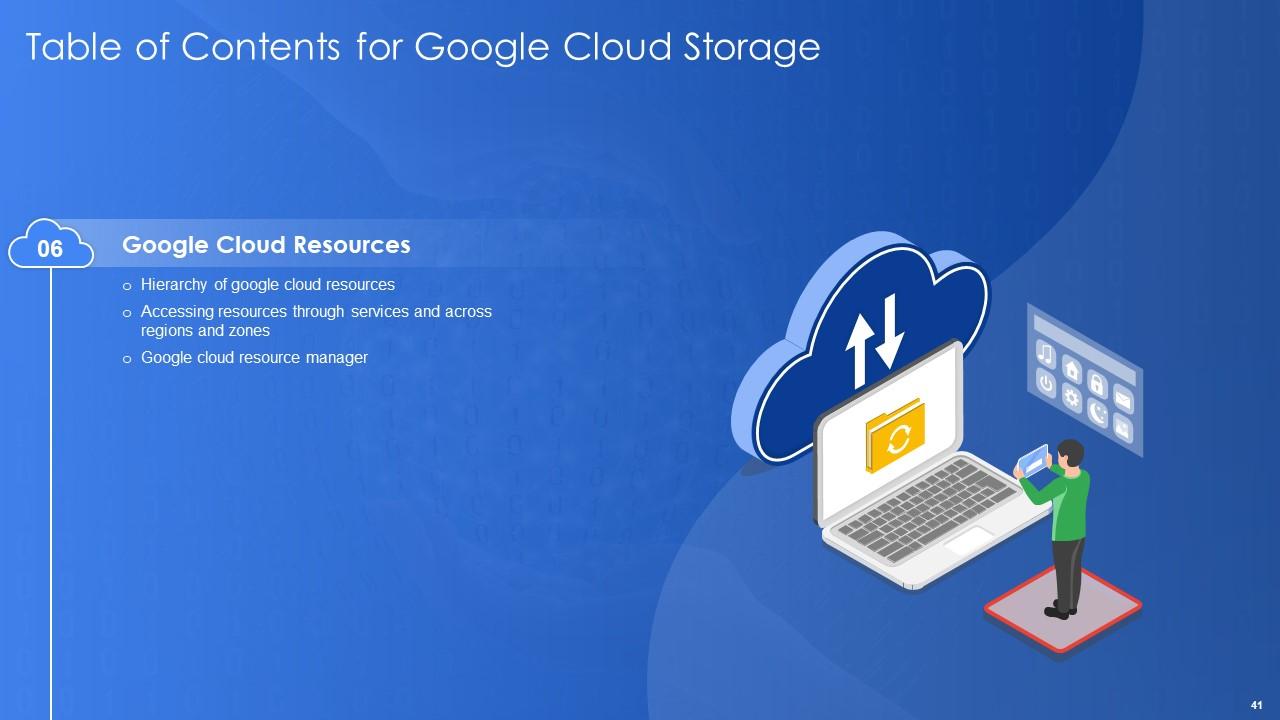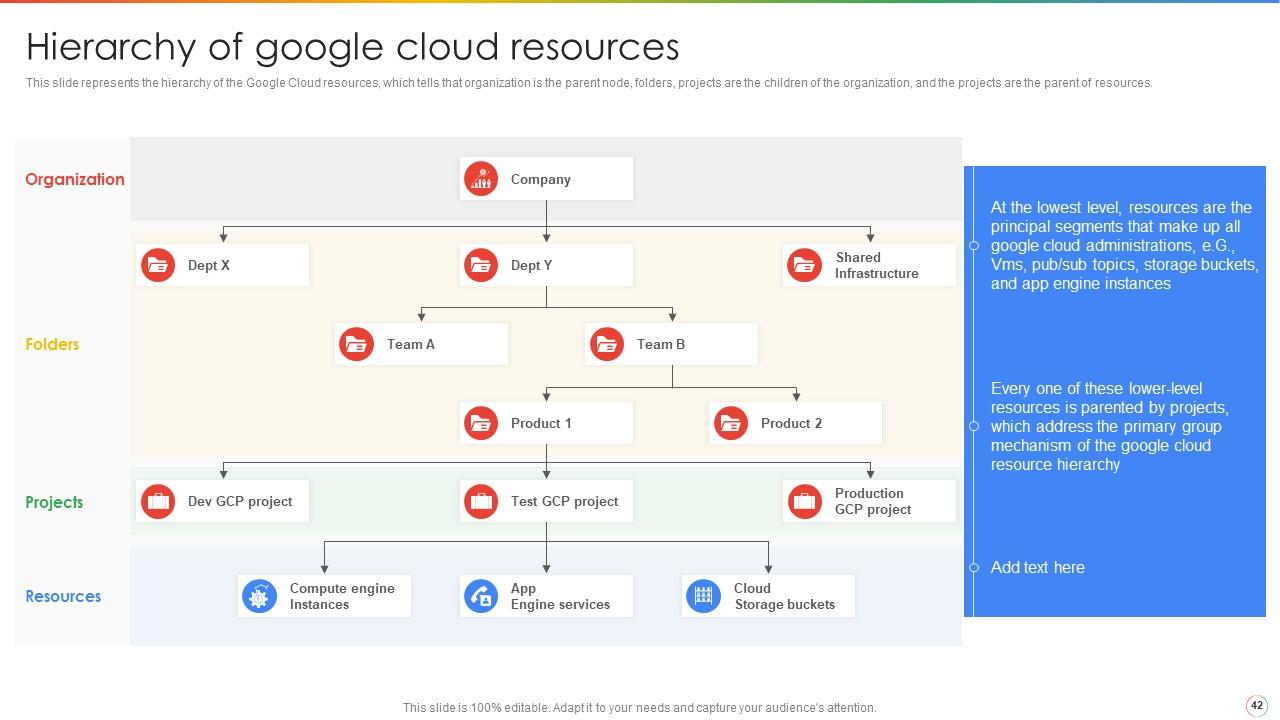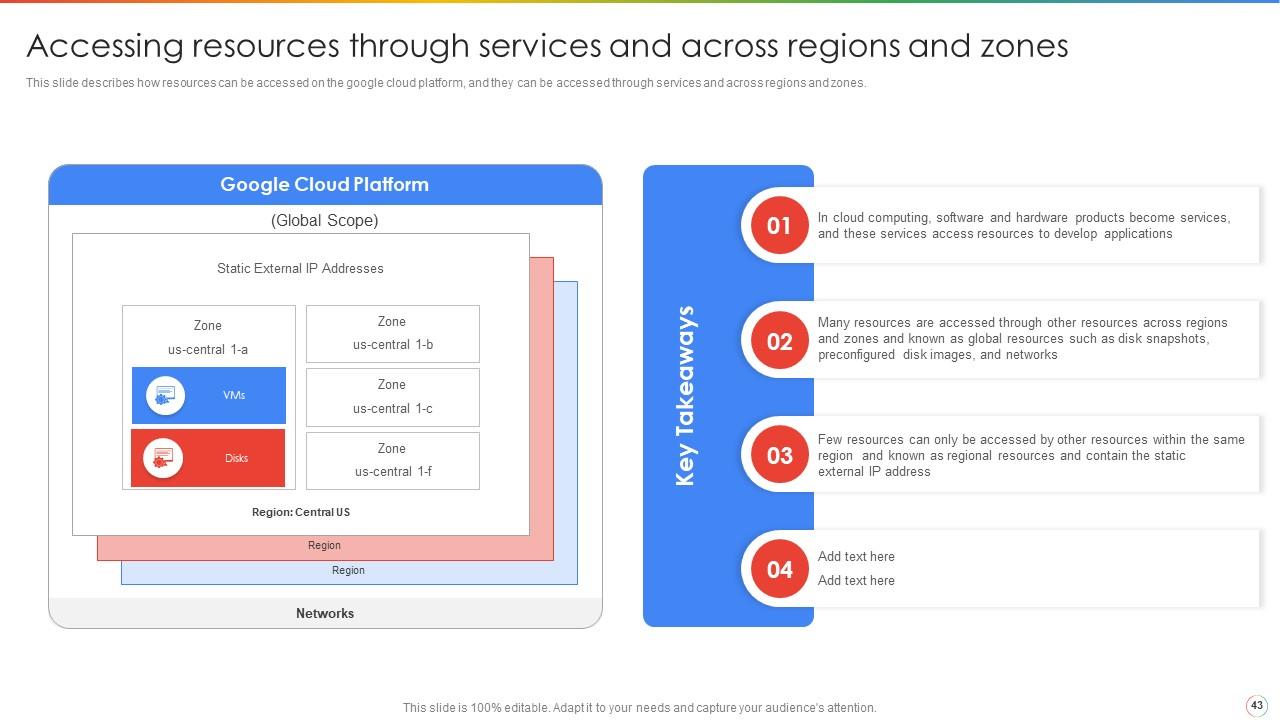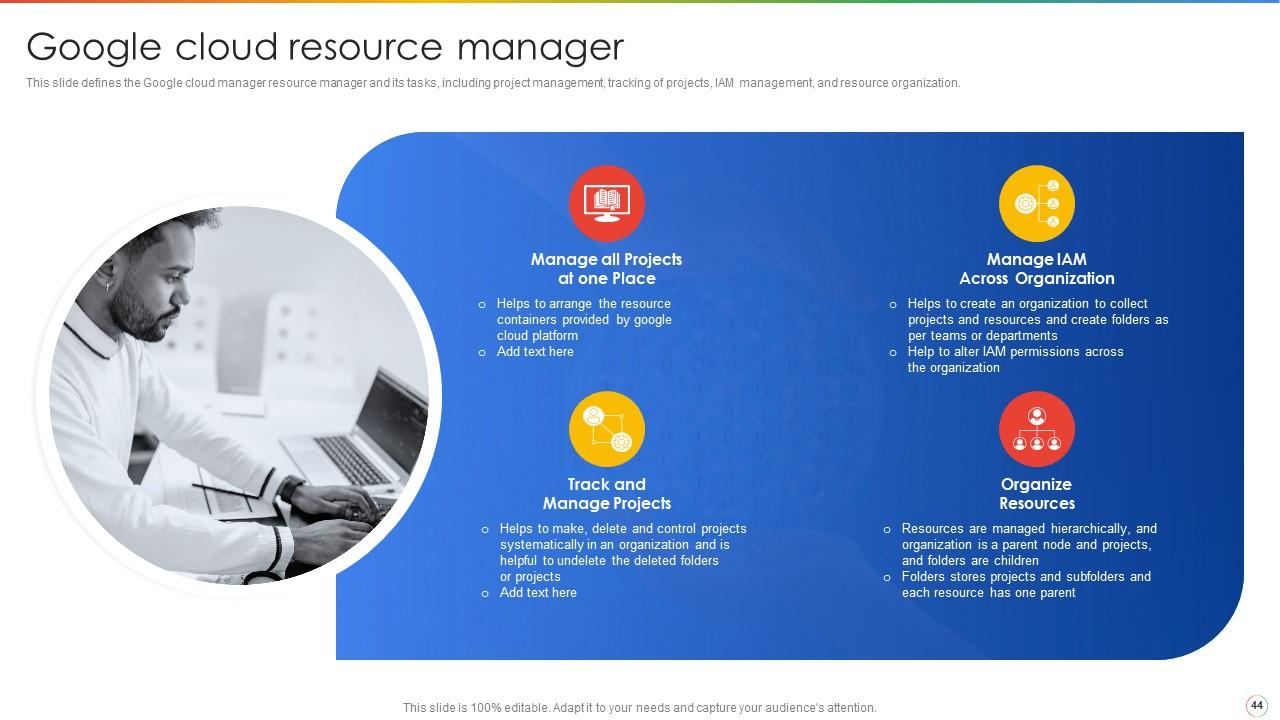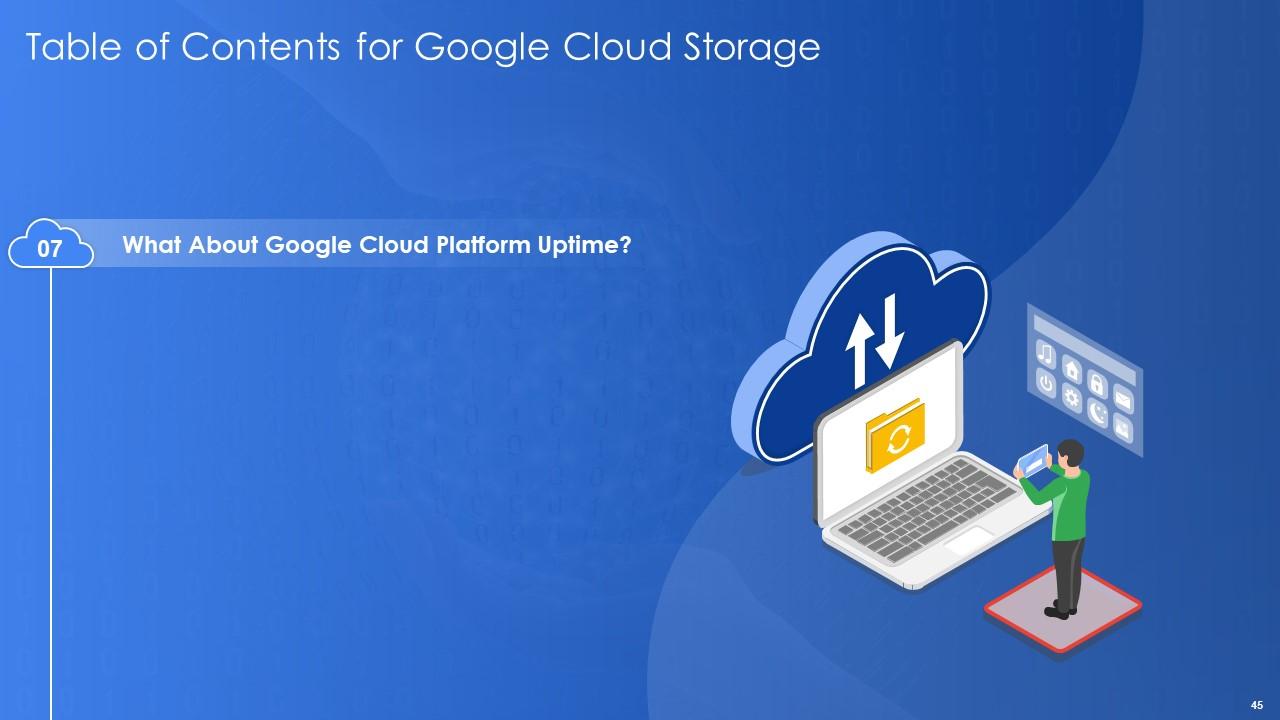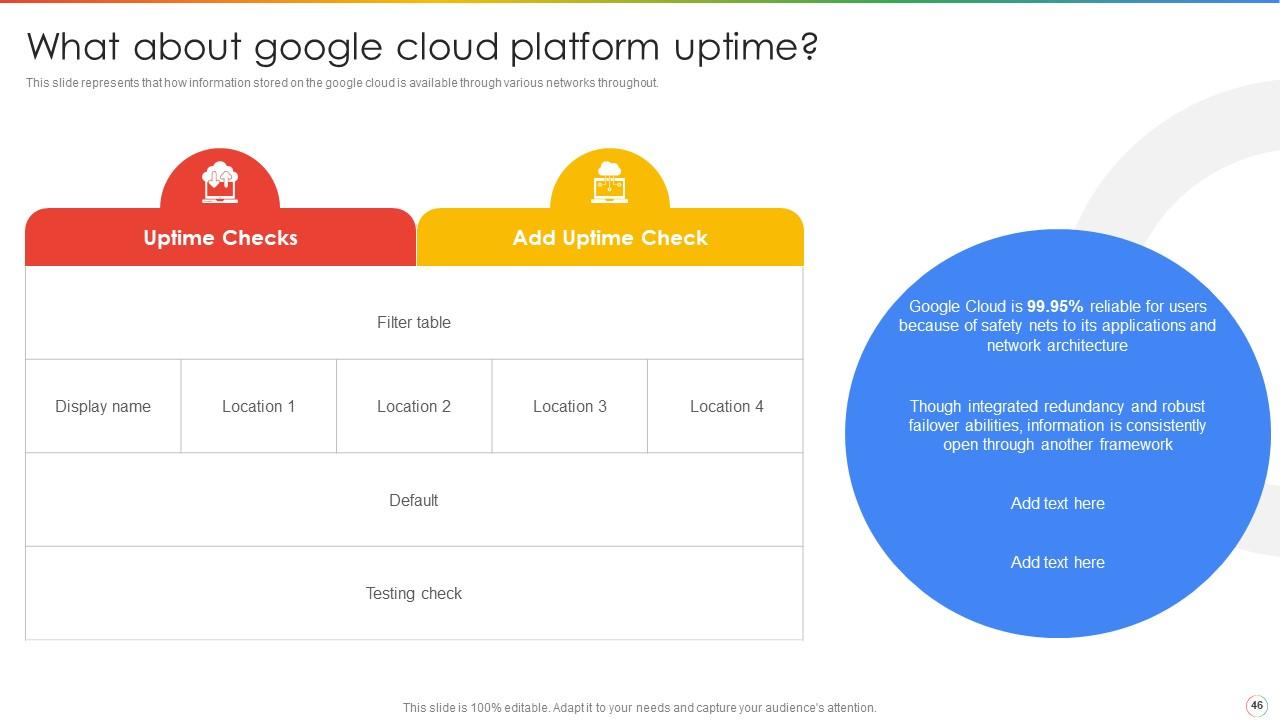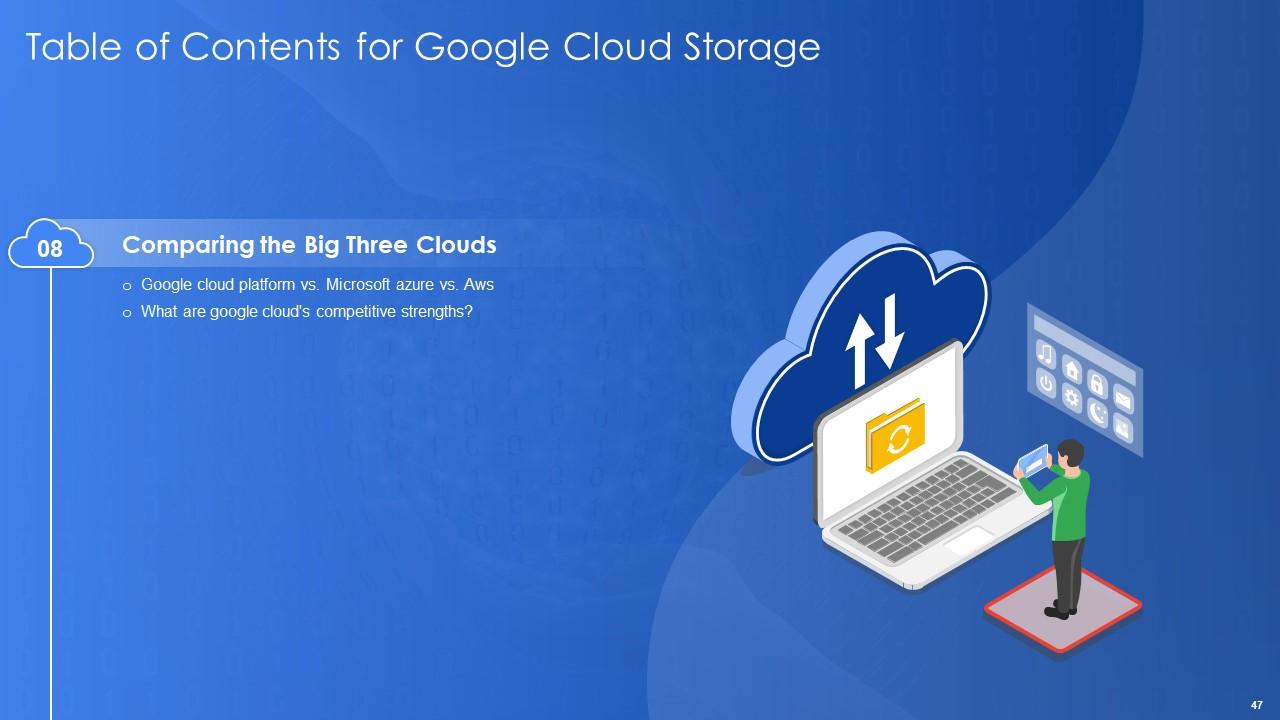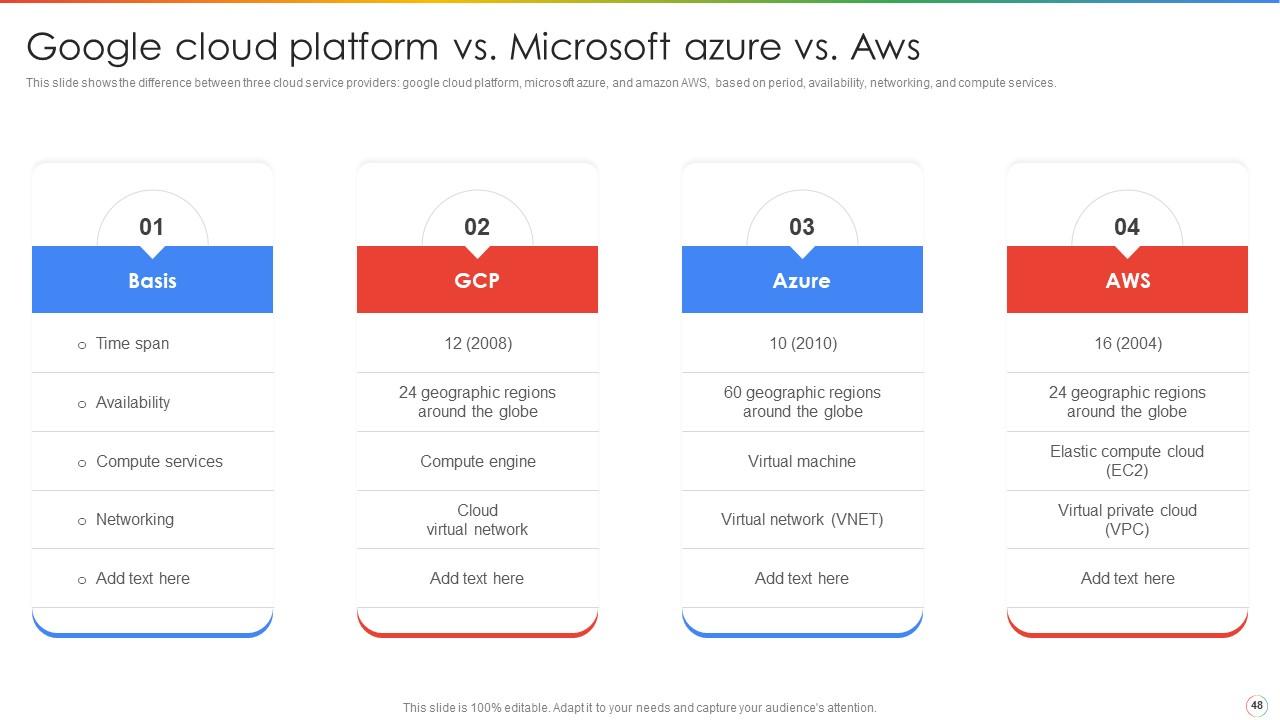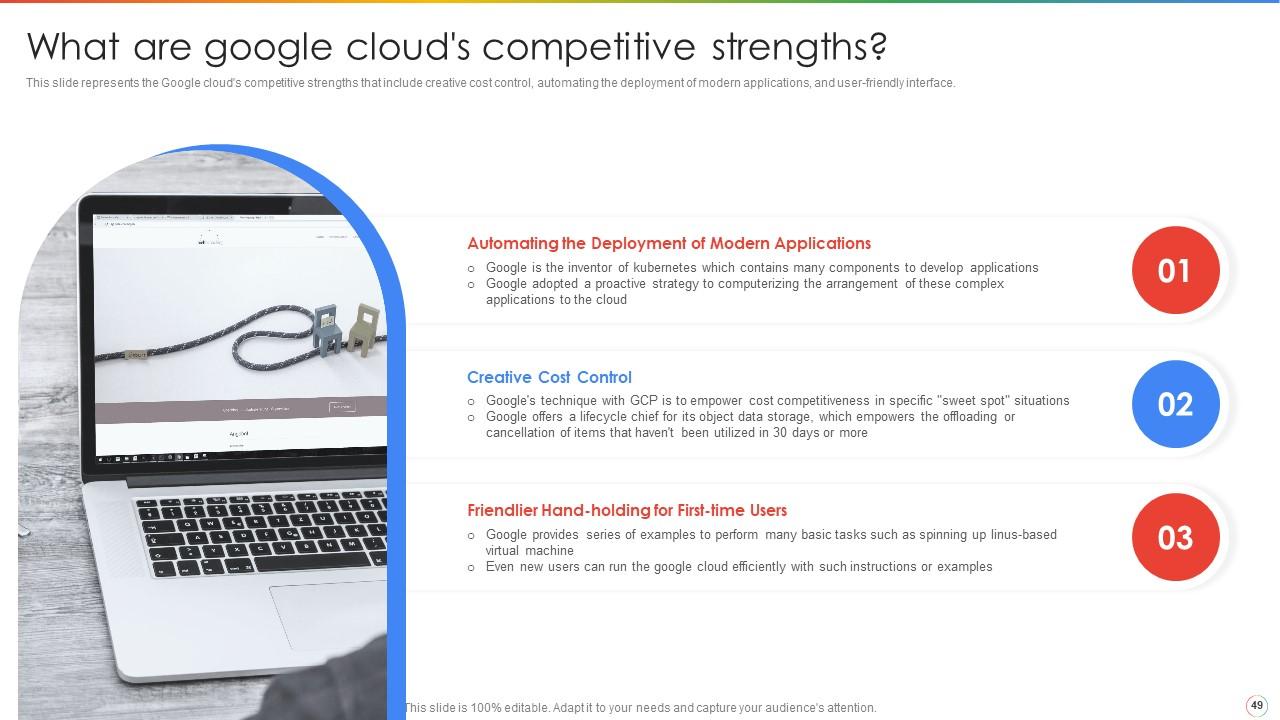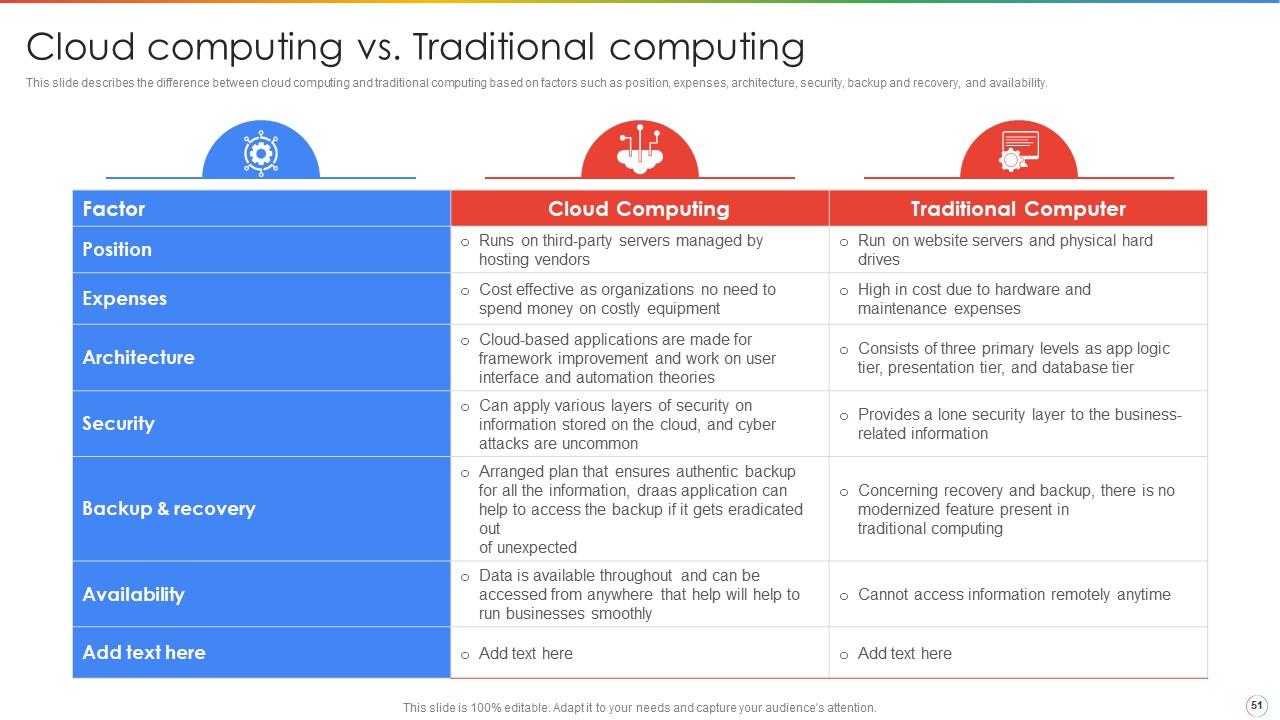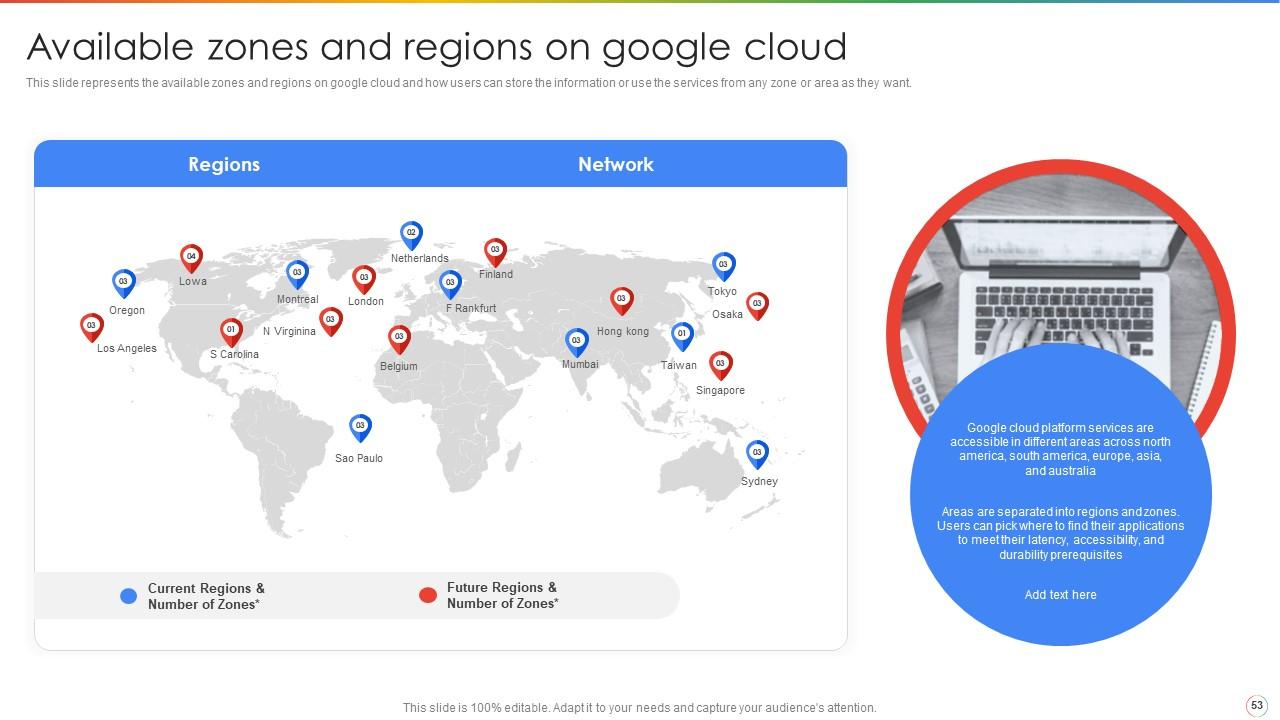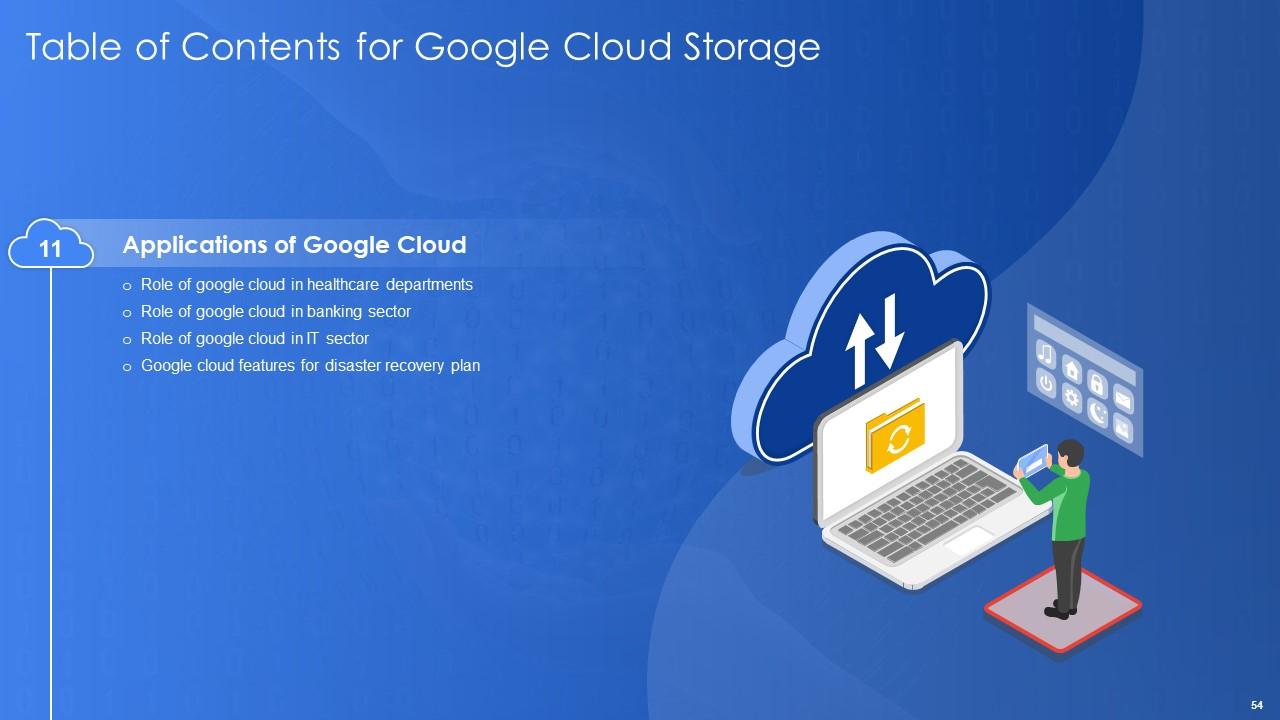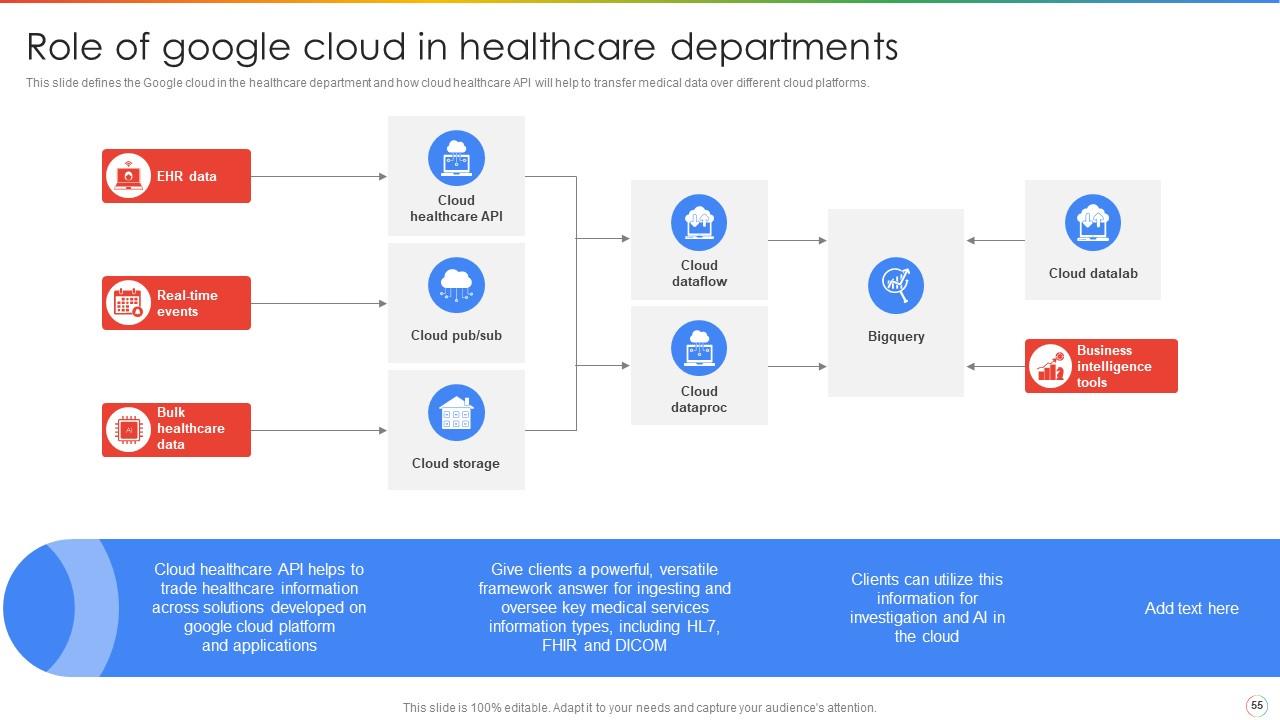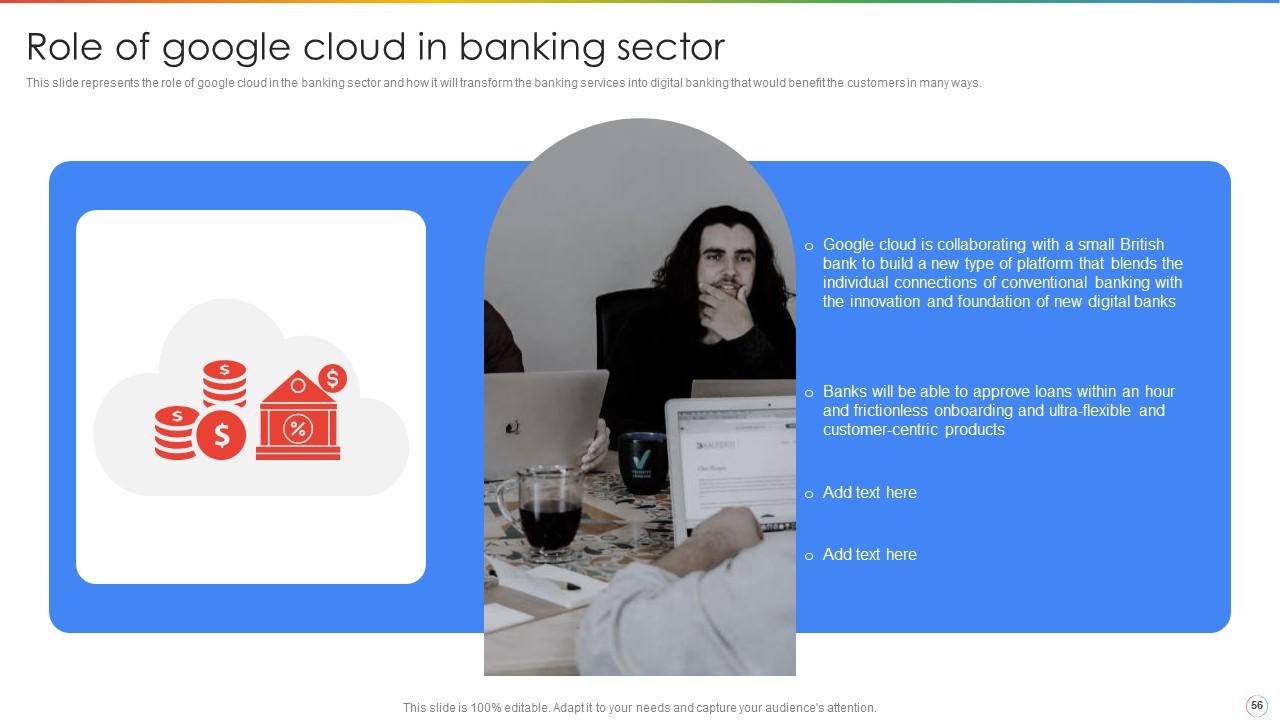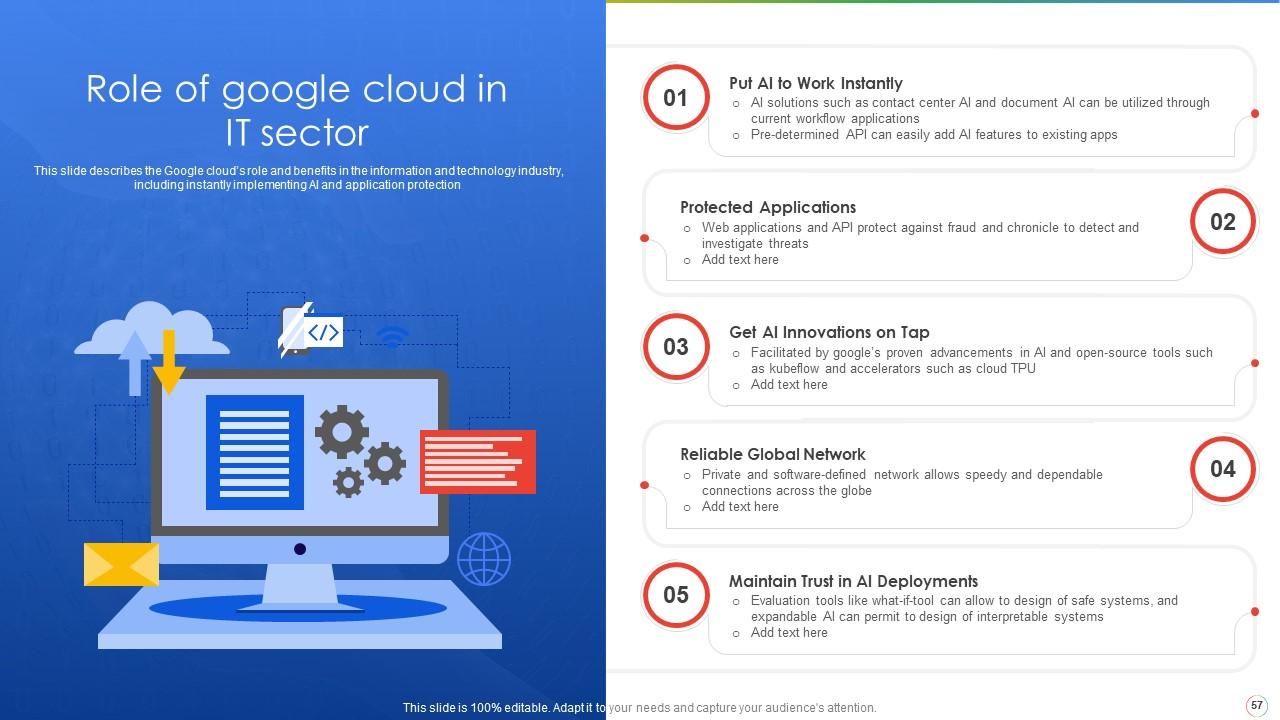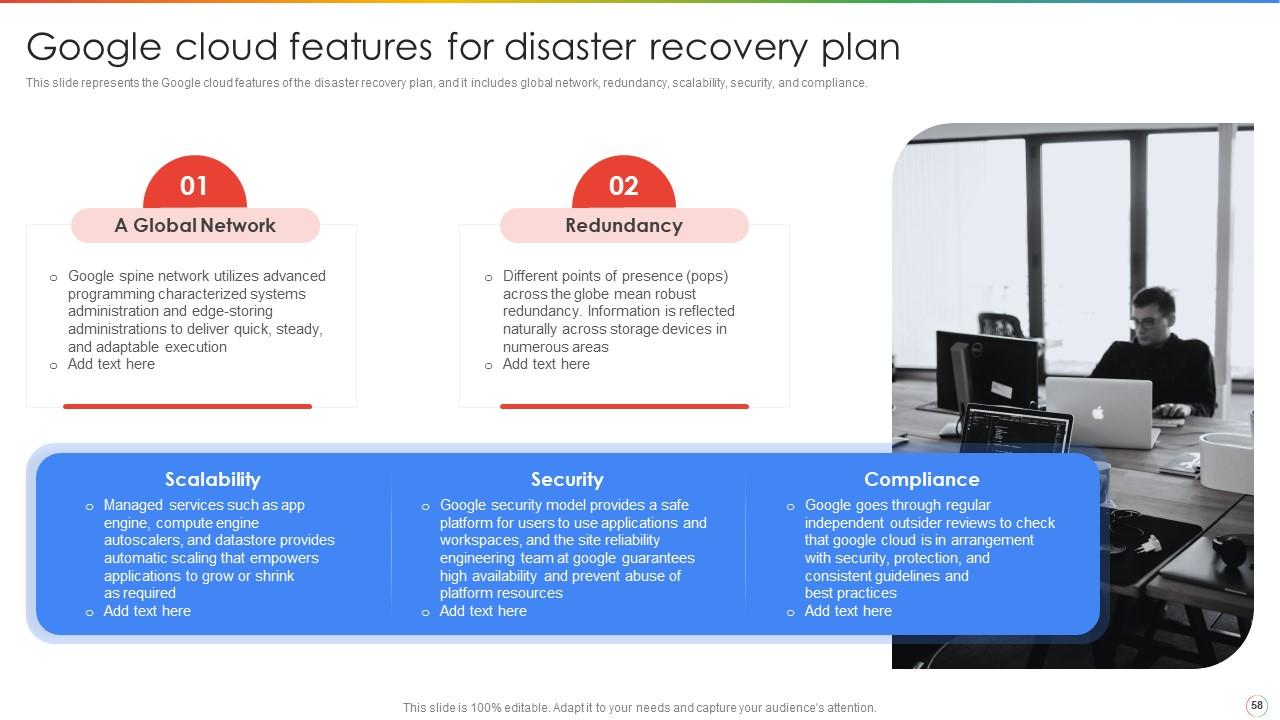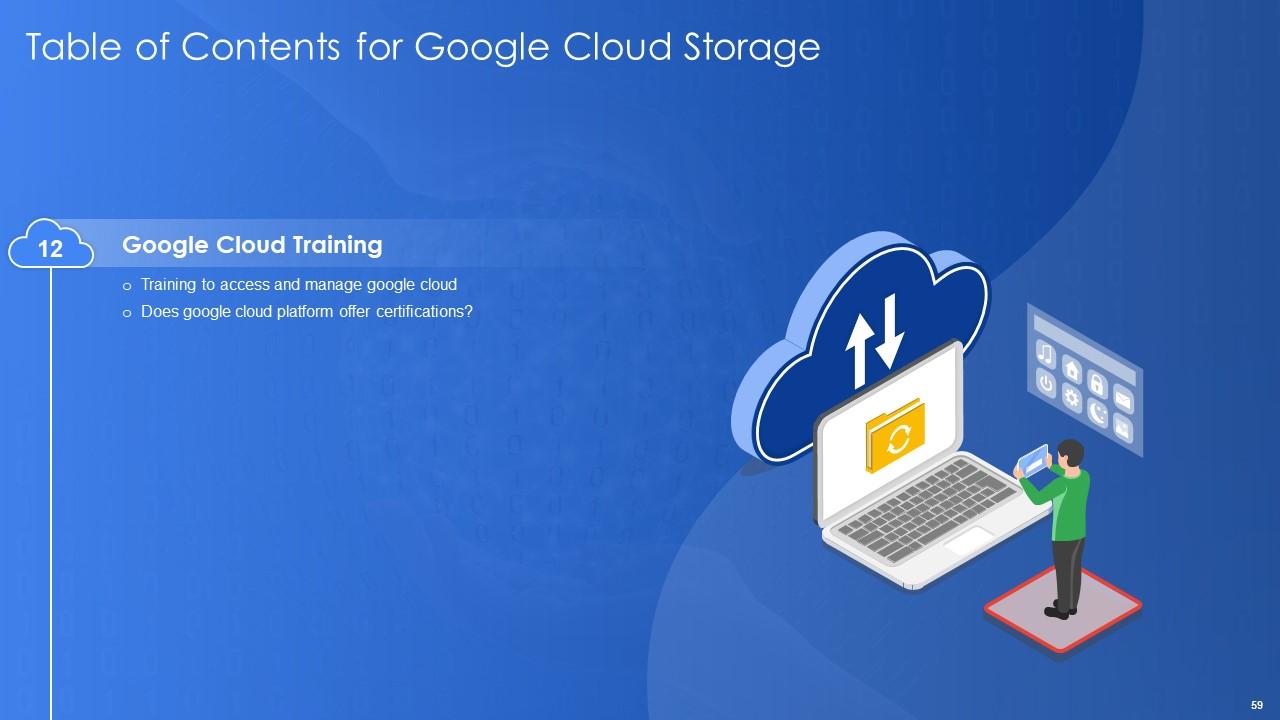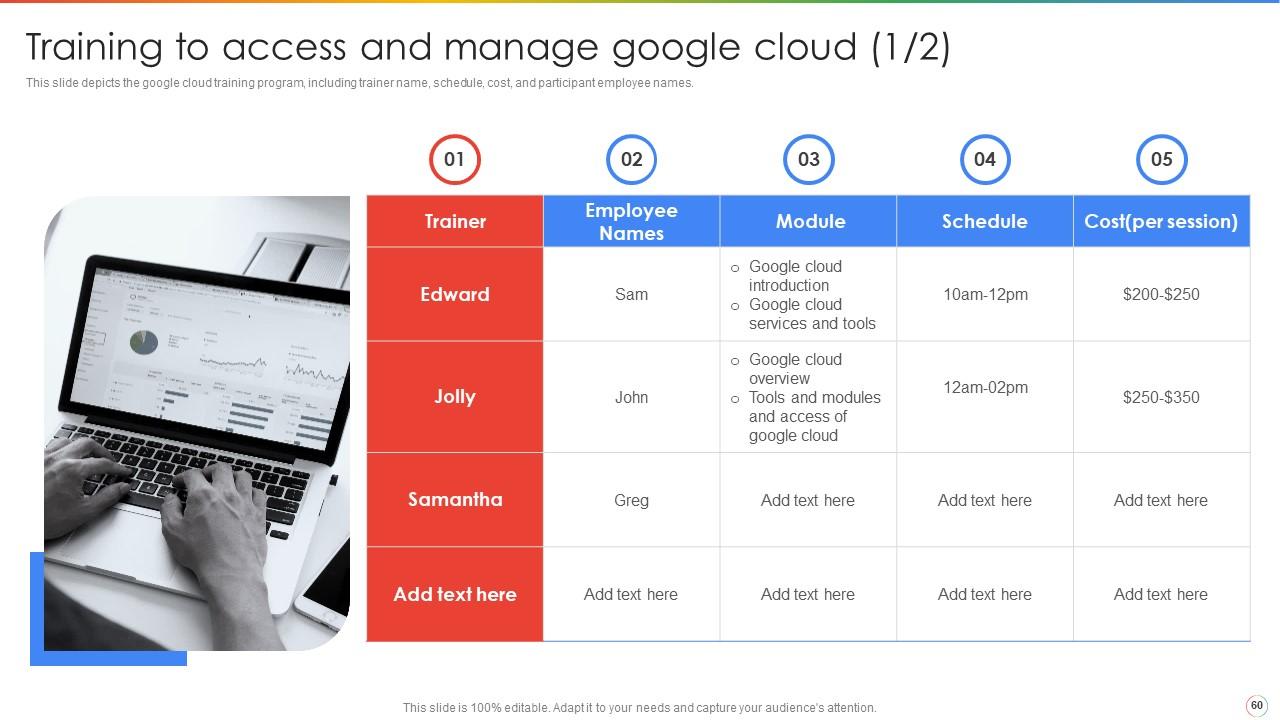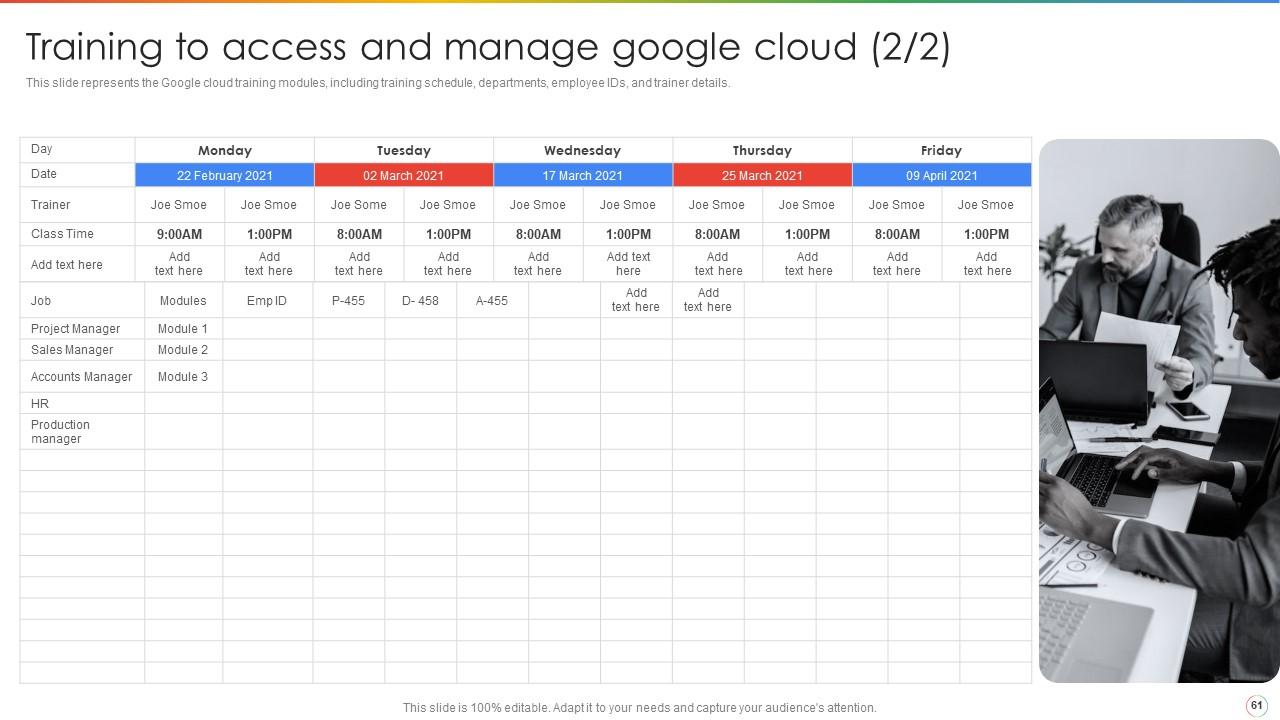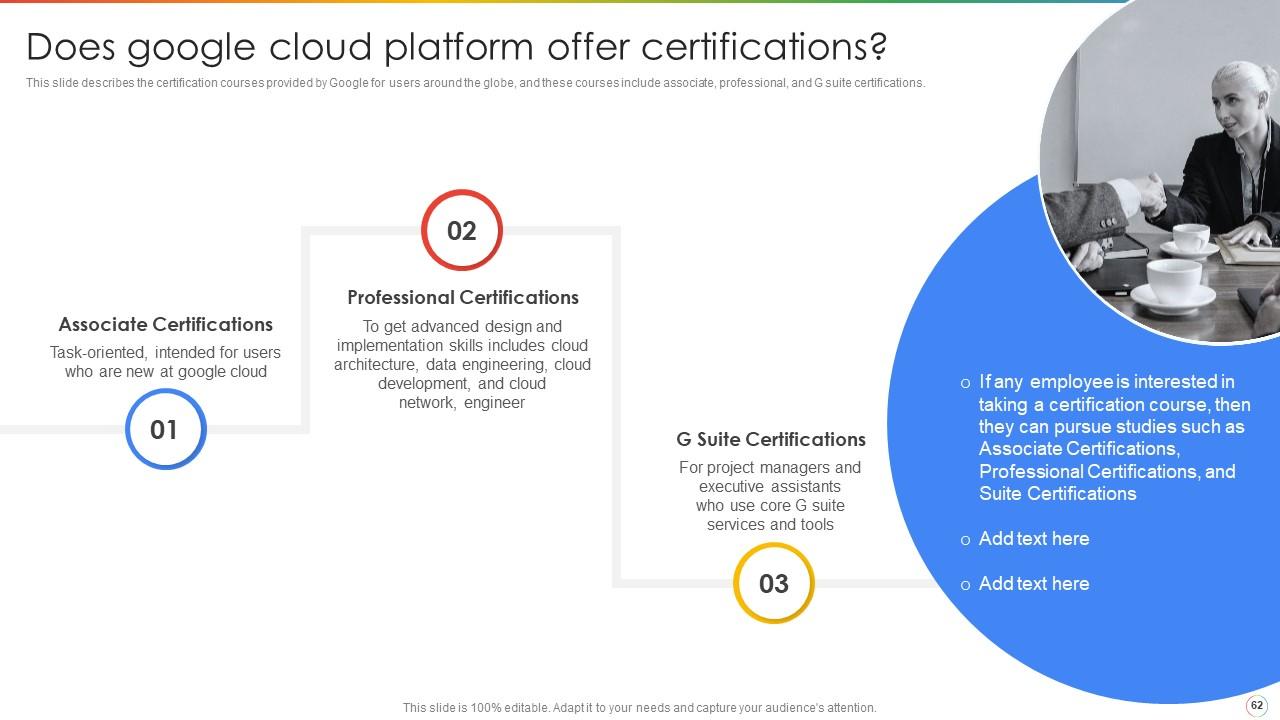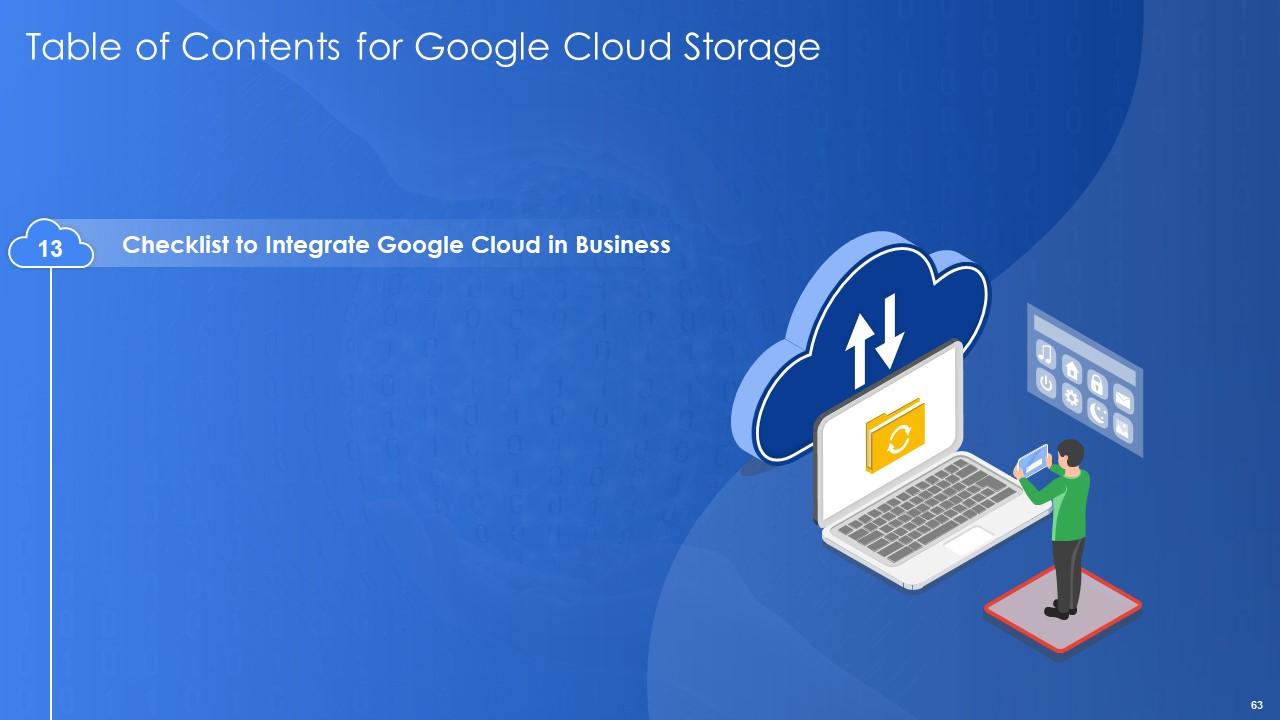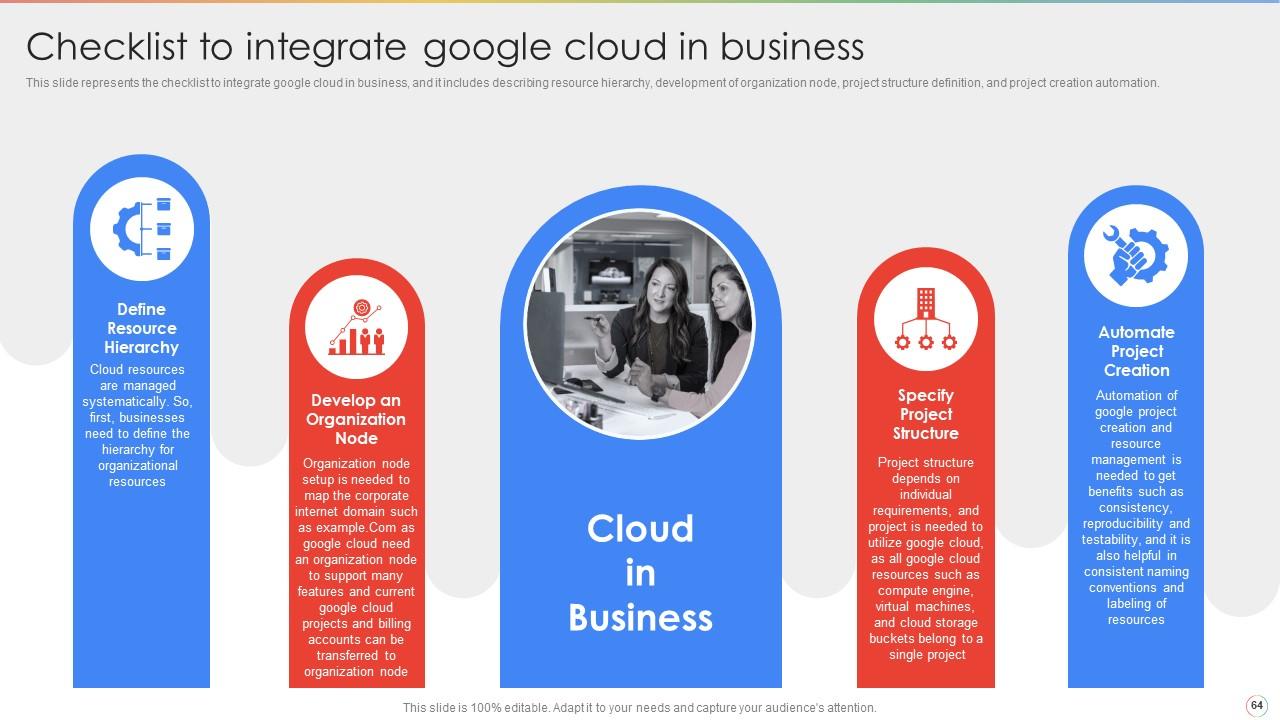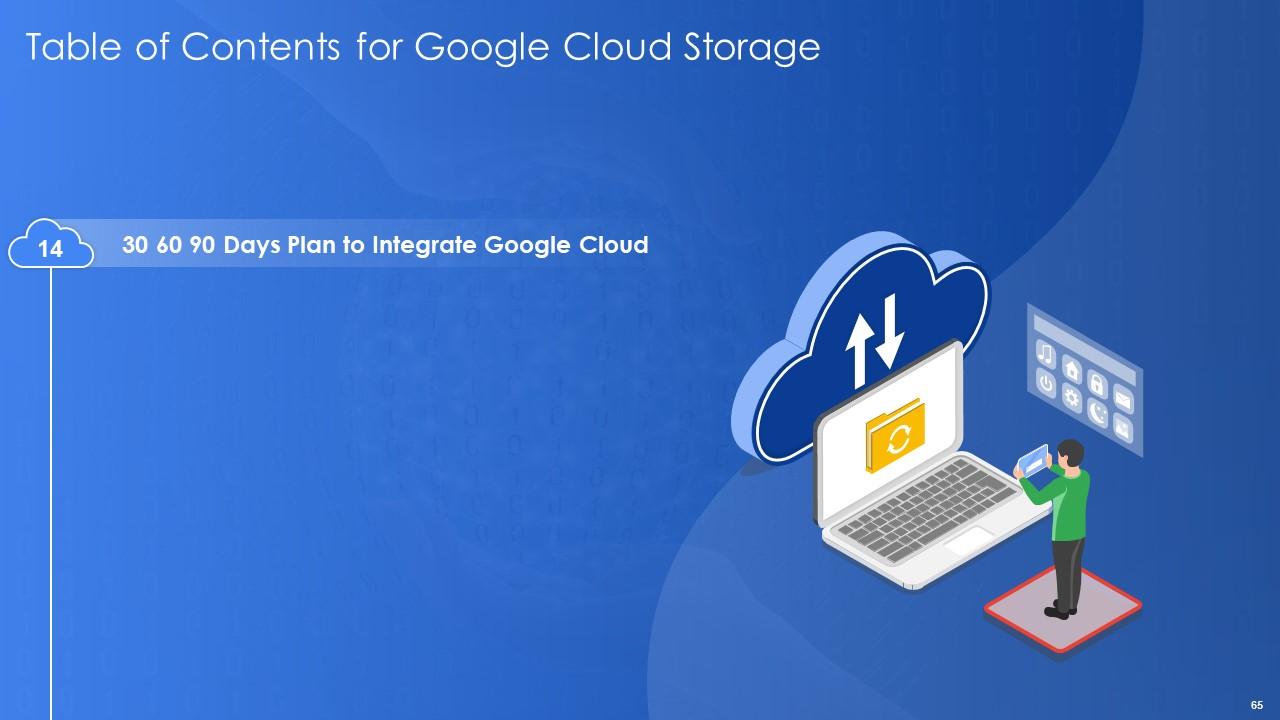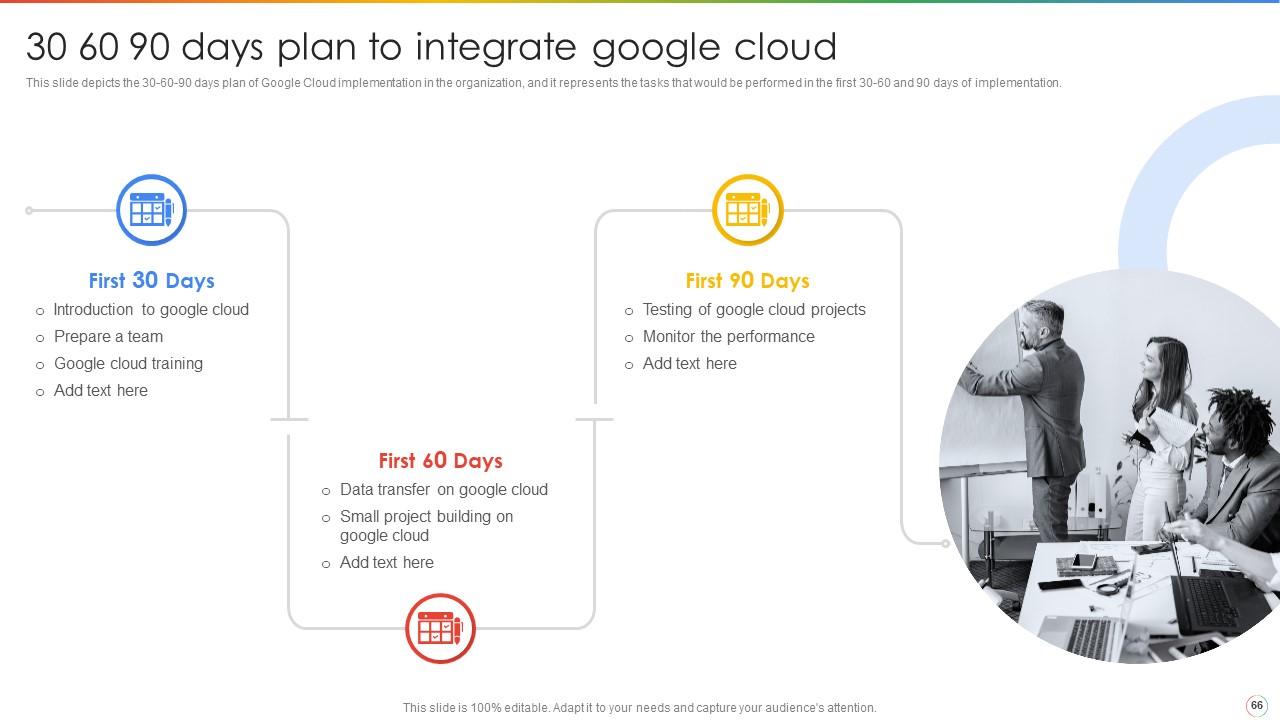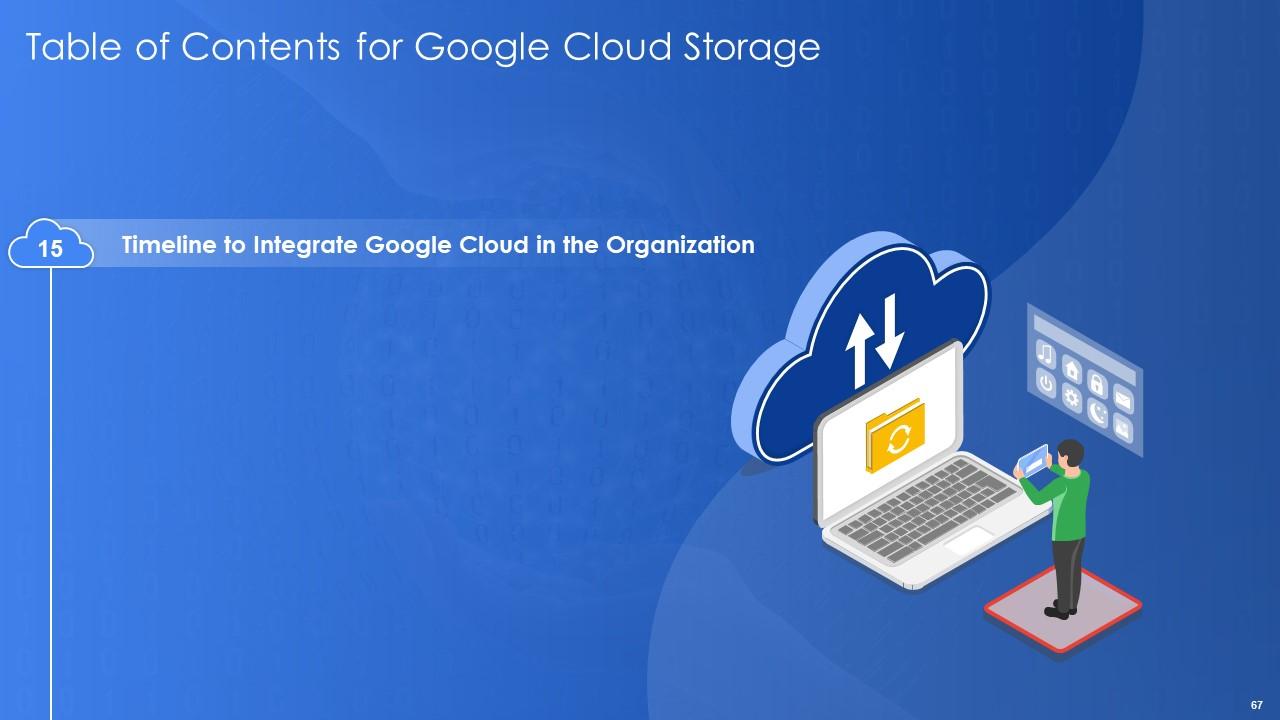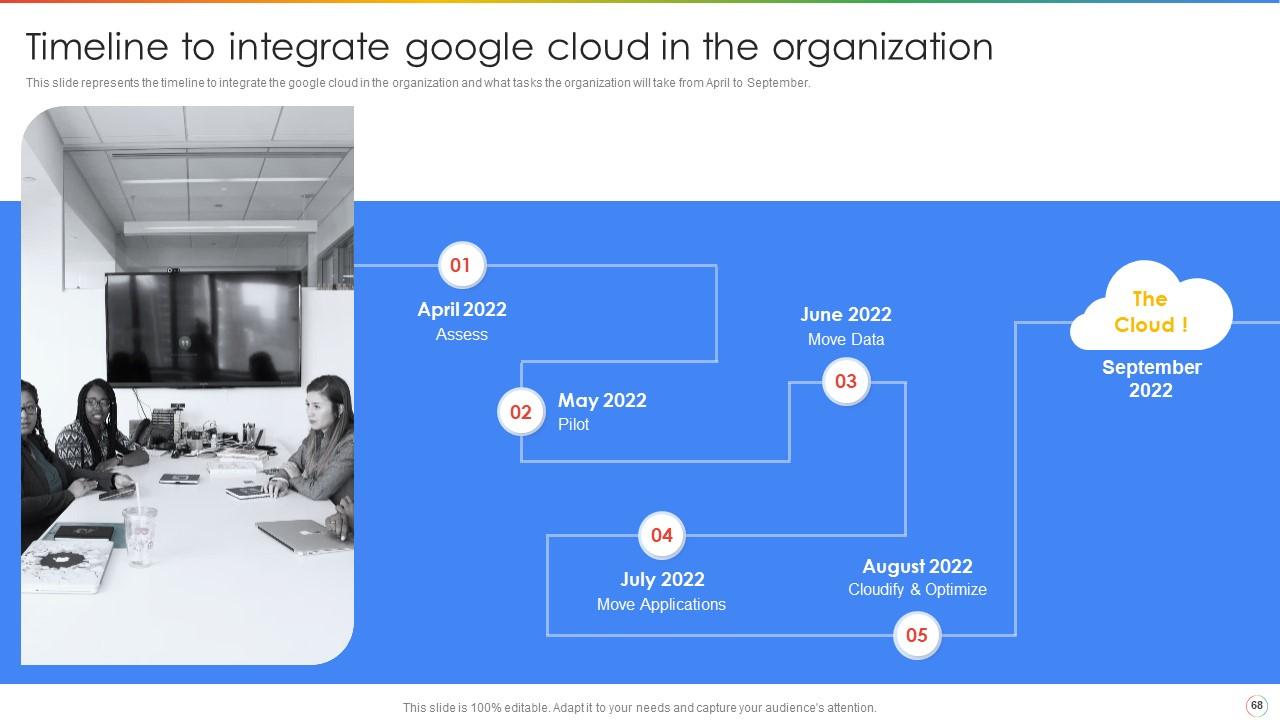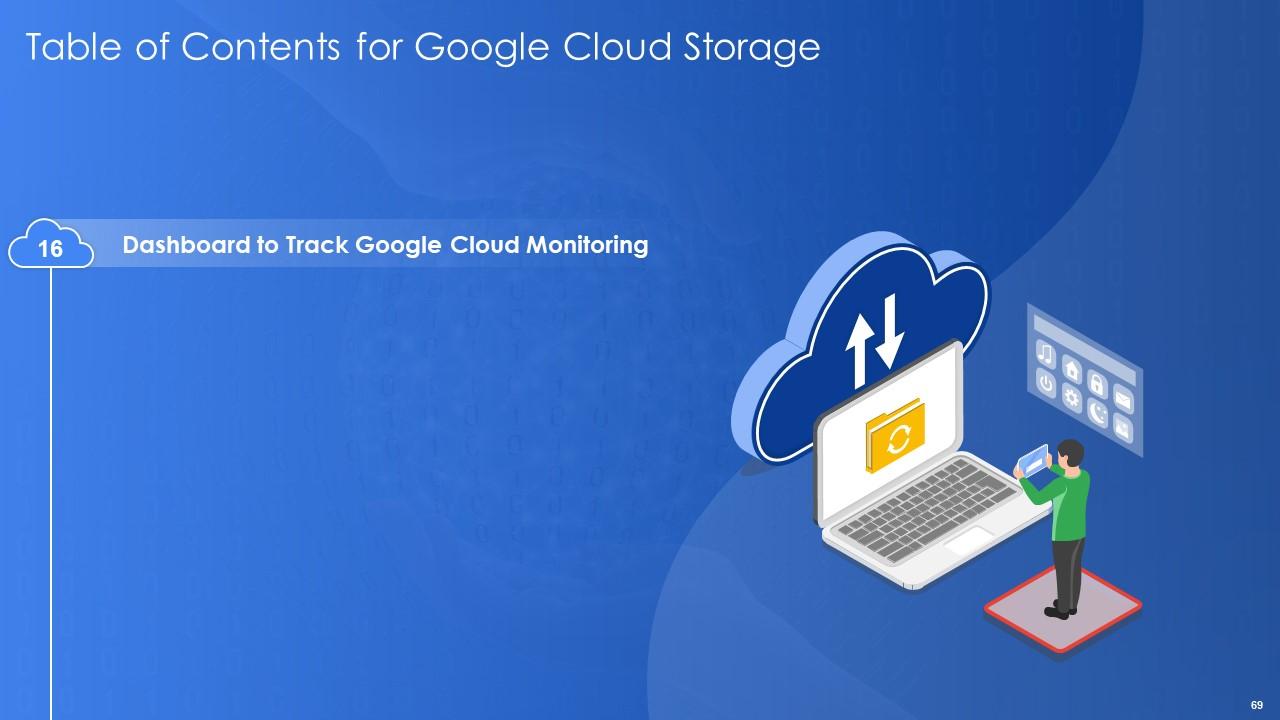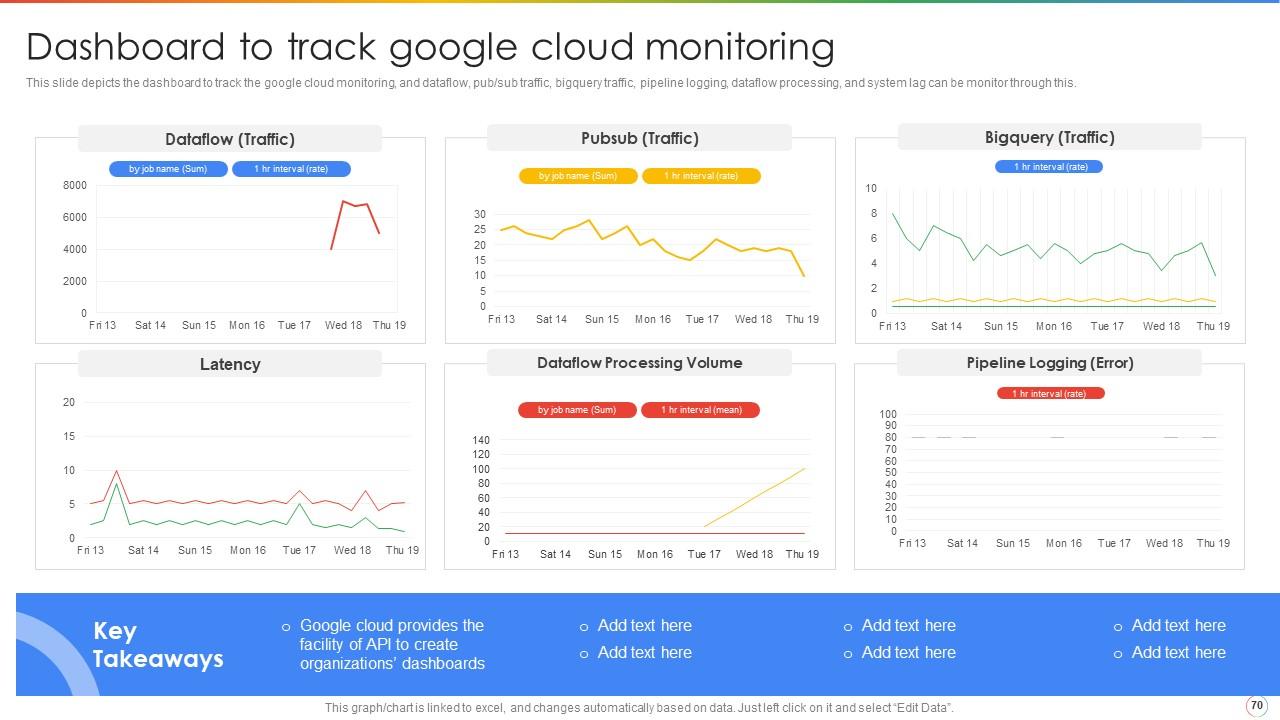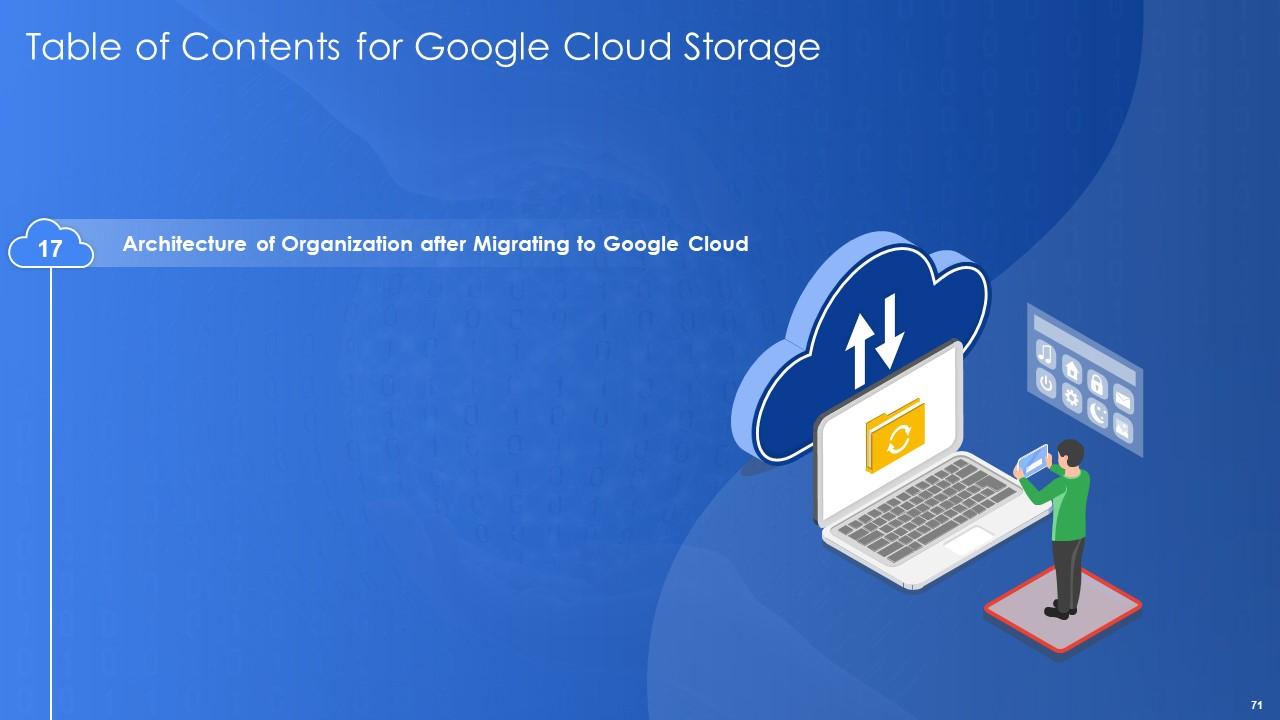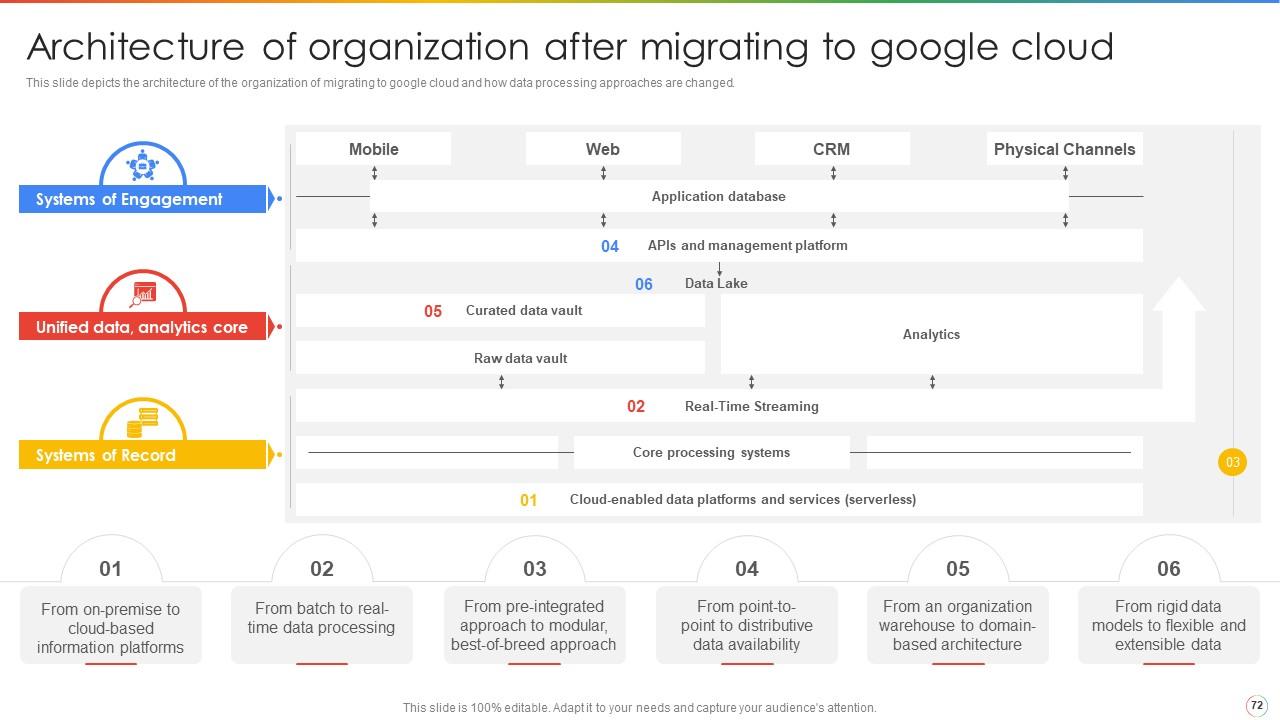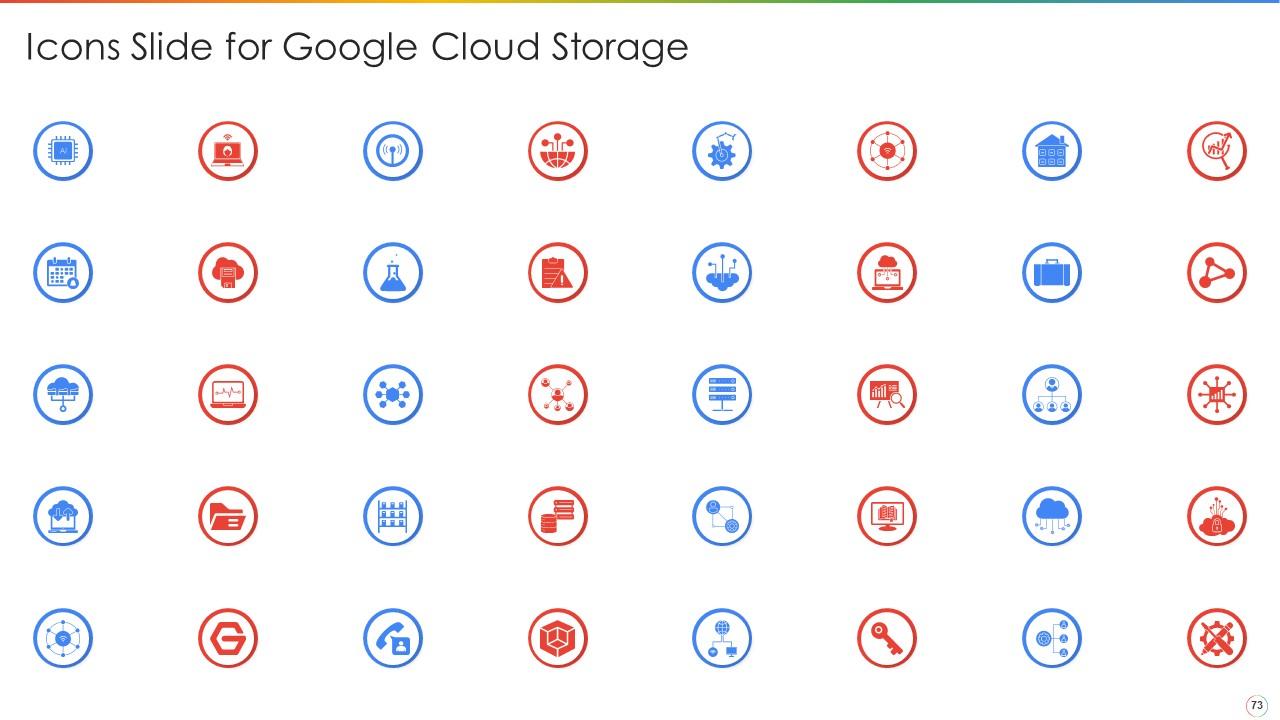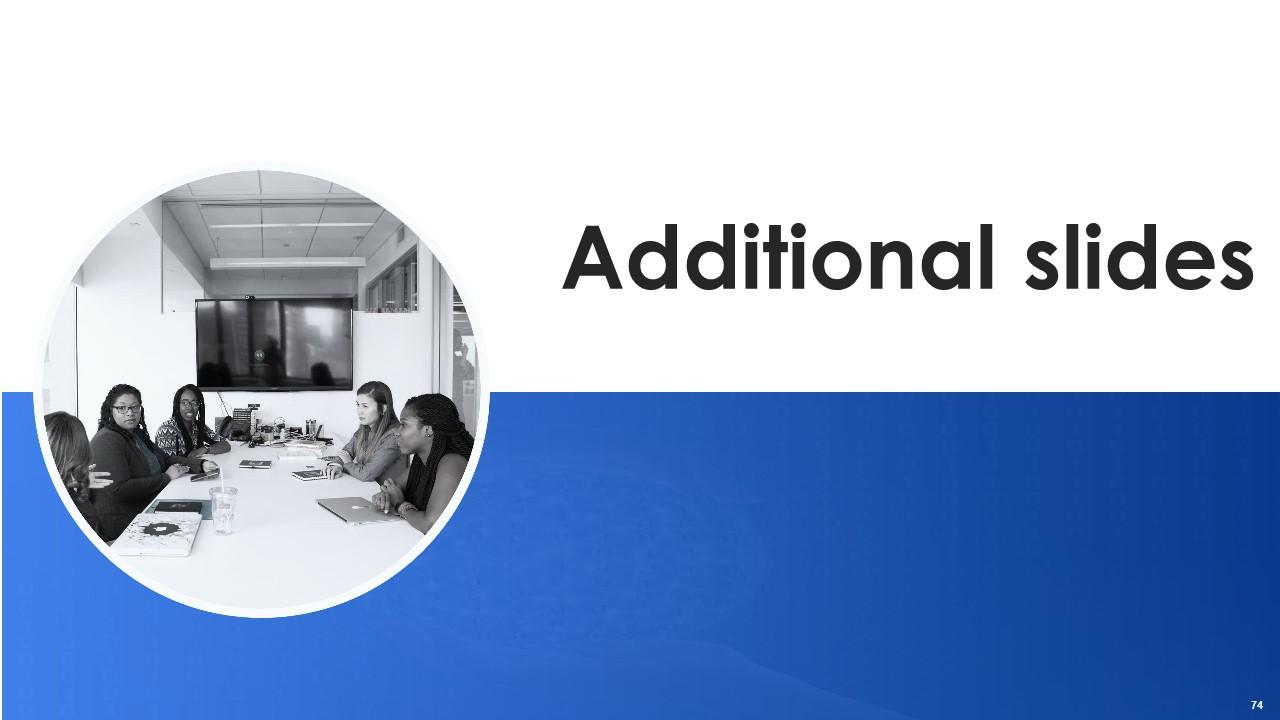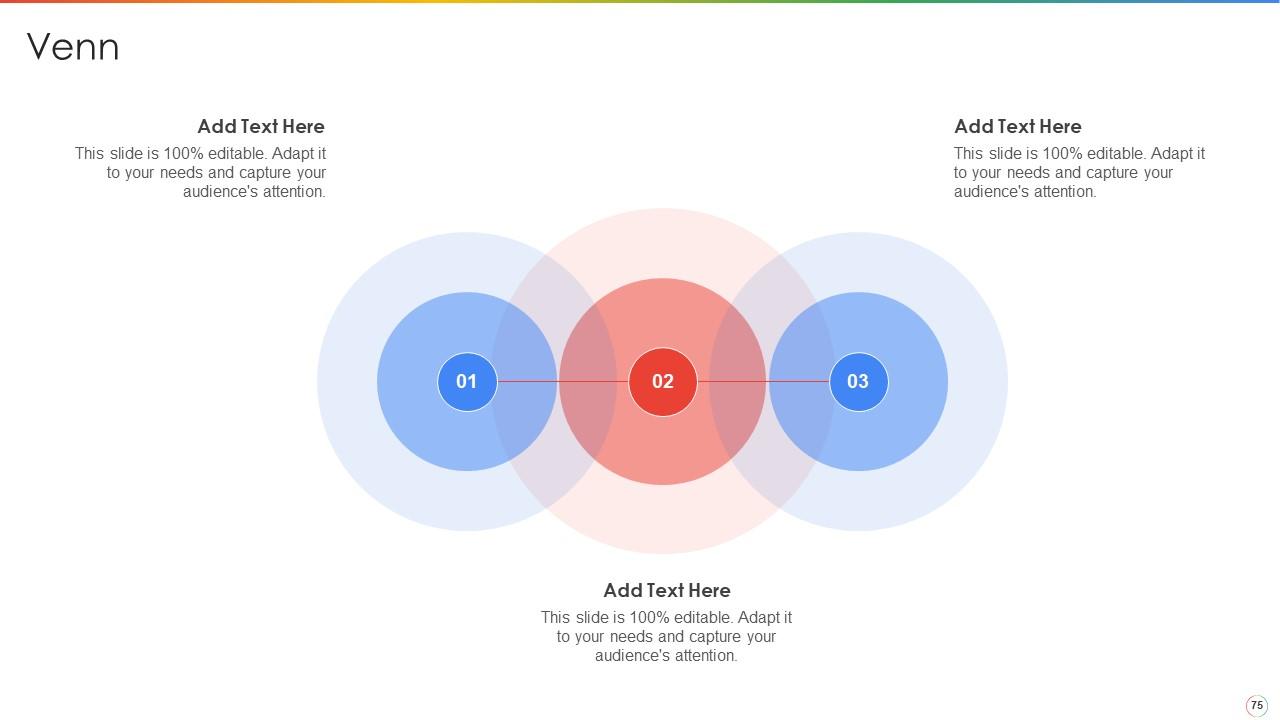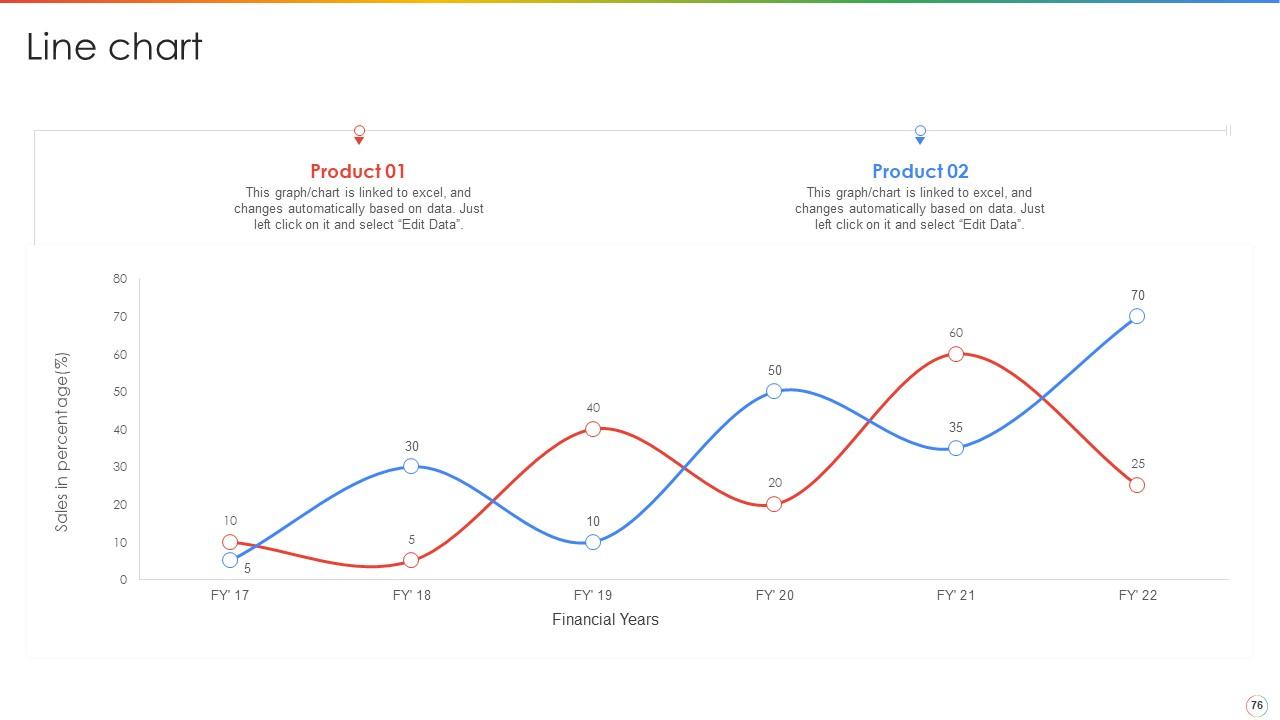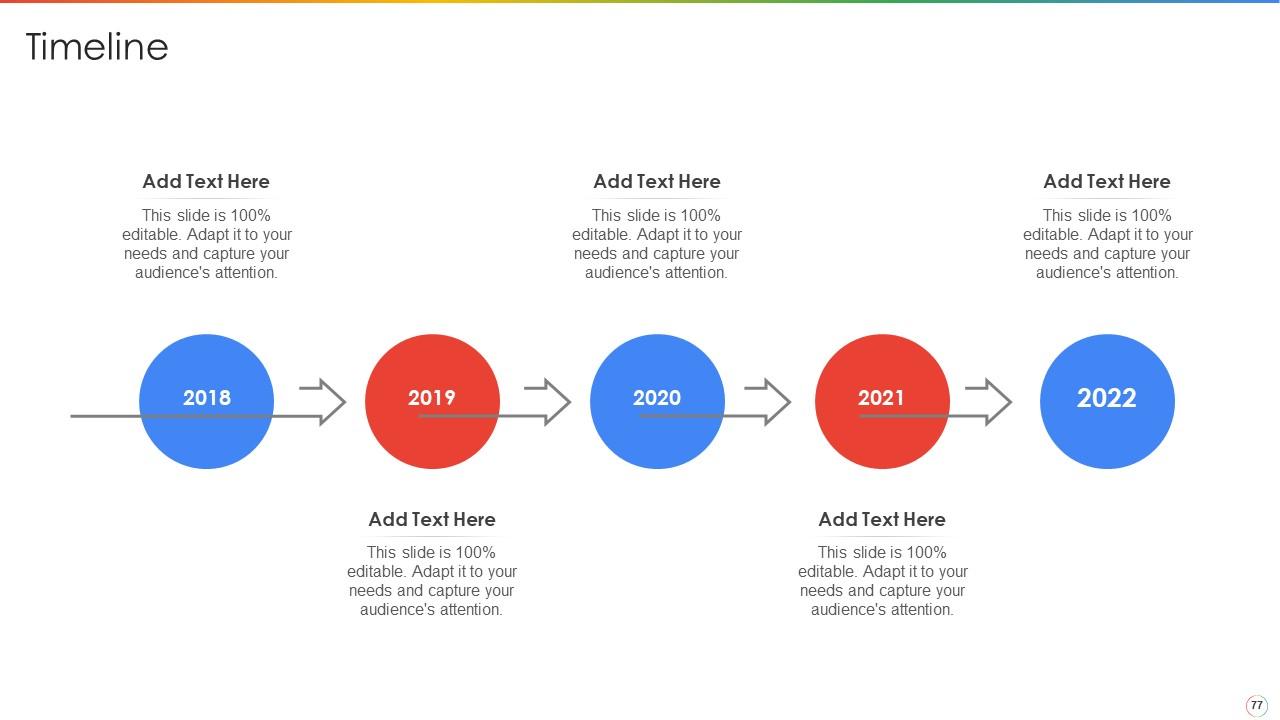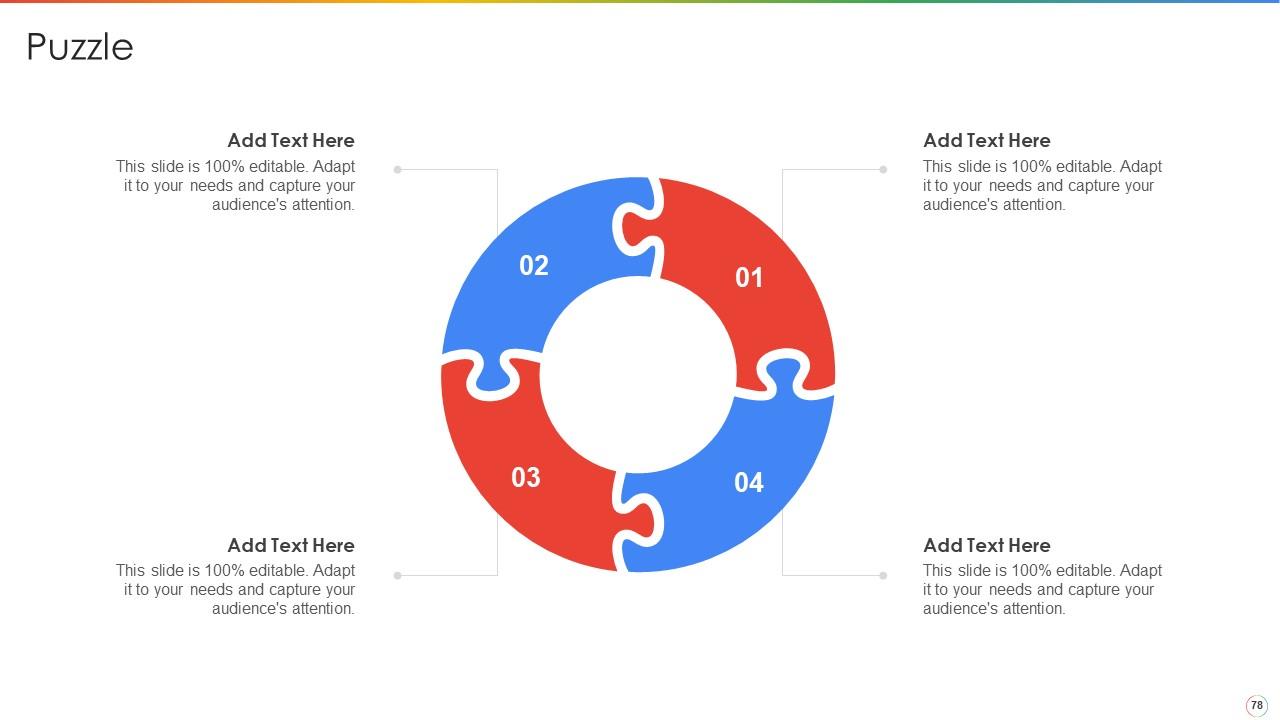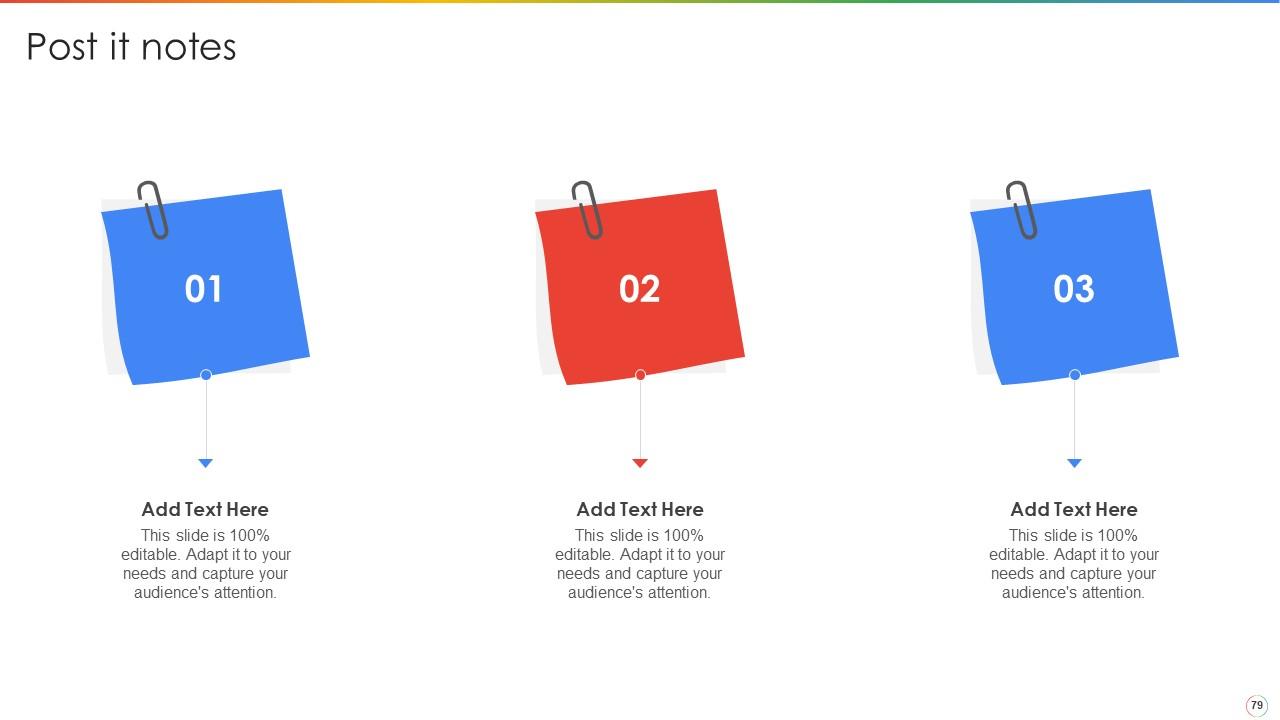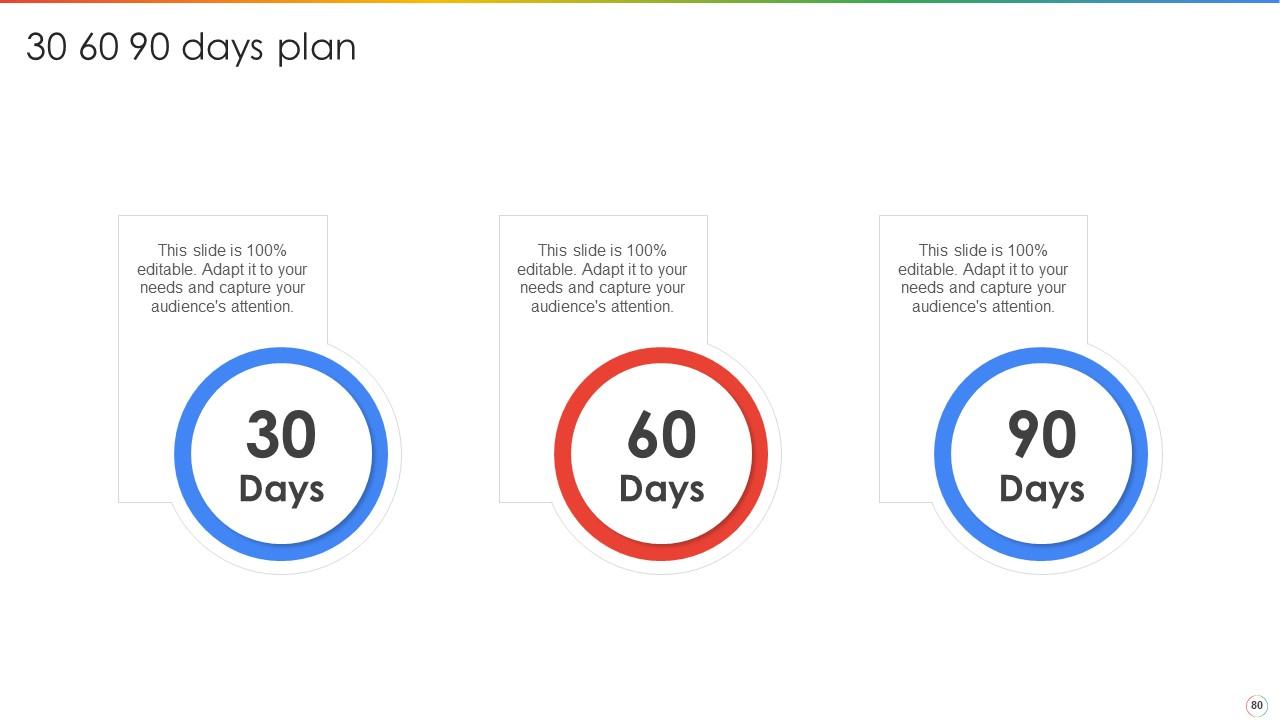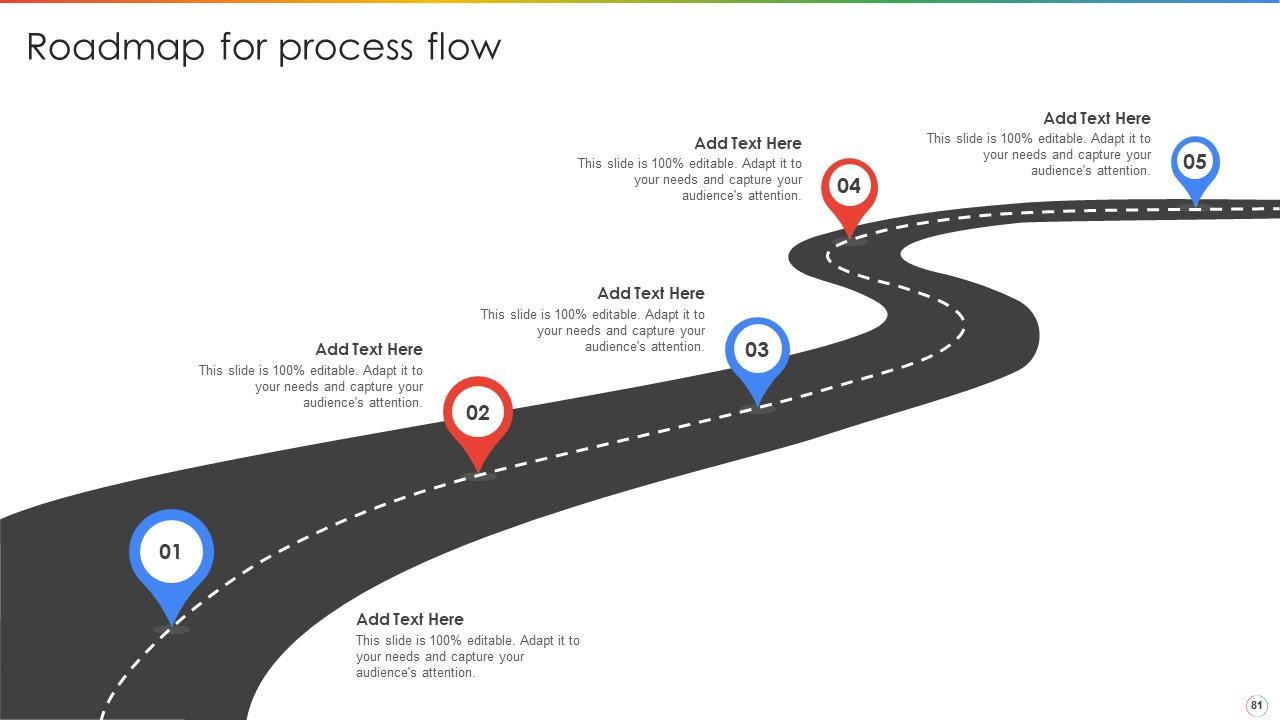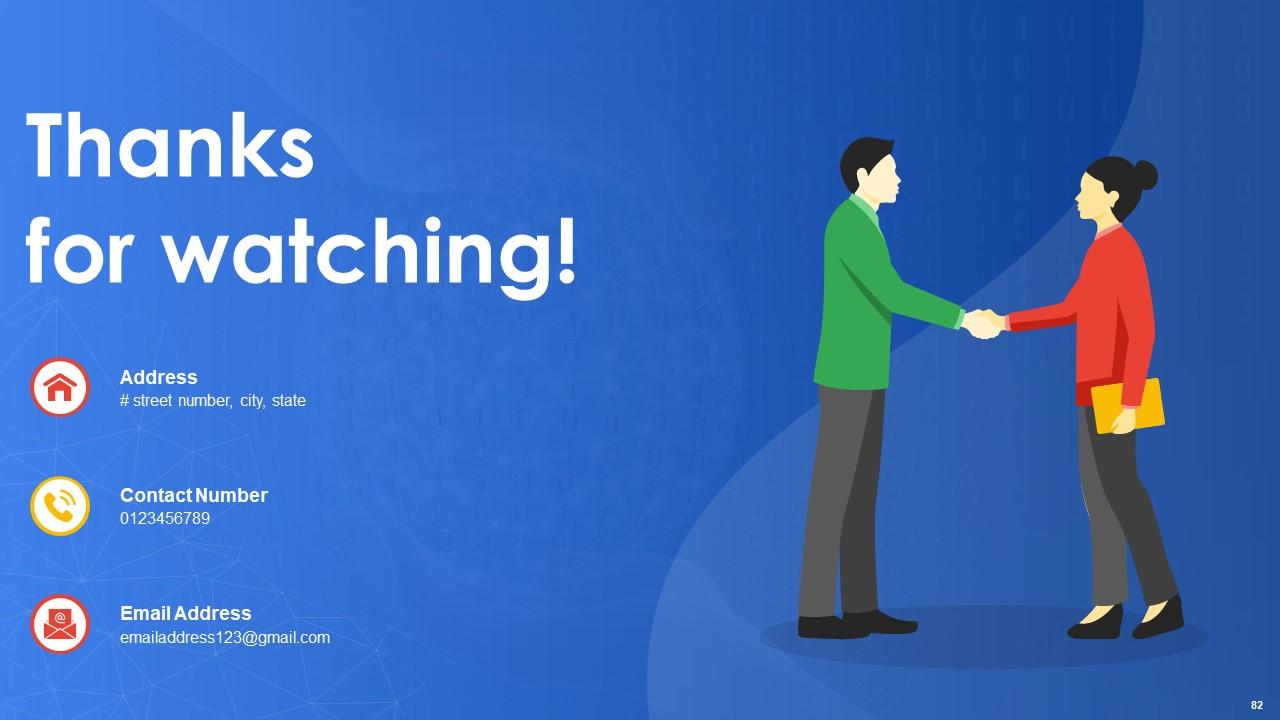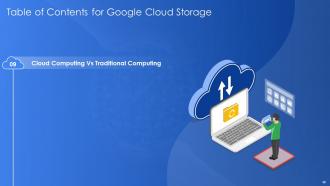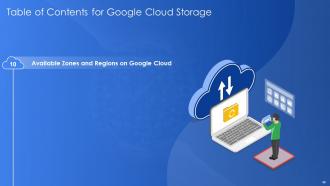Google Cloud Storage Powerpoint Presentation Slides
Google Cloud Storage comprises many physical resources such as computers, hard disk drives, and virtual assets, like virtual machines VMs, contained in Googles information centers throughout the planet. Here is an efficiently designed Google Cloud Storage template that offers an overview of Google Cloud Storage, its need, storage classes, models, platform, and services. Furthermore, this Google Cloud Storage presentation showcases various ways to implement the Google Cloud Storage services, its resources, and the uptime availability of Google Cloud Storage. These Google Cloud Storage platform slides also show the difference between three cloud service providers Google Cloud Storage Platform, Microsoft Azure, and Amazon AWS, on factors such as period, availability, networking, and compute services. In addition, Google Cloud Storage PPT throws light on cloud computing vs. traditional computing. This presentation also represents the available zones and regions on Google cloud Storage with information about how users can store or use the services from any zone or region they want. Further, this deck showcases the application of Google Cloud Storage in healthcare, banking services, and IT sectors. Get access now.
Google Cloud Storage comprises many physical resources such as computers, hard disk drives, and virtual assets, like virtua..
- Google Slides is a new FREE Presentation software from Google.
- All our content is 100% compatible with Google Slides.
- Just download our designs, and upload them to Google Slides and they will work automatically.
- Amaze your audience with SlideTeam and Google Slides.
-
Want Changes to This PPT Slide? Check out our Presentation Design Services
- WideScreen Aspect ratio is becoming a very popular format. When you download this product, the downloaded ZIP will contain this product in both standard and widescreen format.
-

- Some older products that we have may only be in standard format, but they can easily be converted to widescreen.
- To do this, please open the SlideTeam product in Powerpoint, and go to
- Design ( On the top bar) -> Page Setup -> and select "On-screen Show (16:9)” in the drop down for "Slides Sized for".
- The slide or theme will change to widescreen, and all graphics will adjust automatically. You can similarly convert our content to any other desired screen aspect ratio.
Compatible With Google Slides

Get This In WideScreen
You must be logged in to download this presentation.
PowerPoint presentation slides
Enthrall your audience with this Google Cloud Storage Powerpoint Presentation Slides. Increase your presentation threshold by deploying this well-crafted template. It acts as a great communication tool due to its well-researched content. It also contains stylized icons, graphics, visuals etc, which make it an immediate attention-grabber. Comprising eighty two slides, this complete deck is all you need to get noticed. All the slides and their content can be altered to suit your unique business setting. Not only that, other components and graphics can also be modified to add personal touches to this prefabricated set.
People who downloaded this PowerPoint presentation also viewed the following :
Content of this Powerpoint Presentation
Slide 1: This slide displays title i.e. 'Google Cloud Storage' and your Company Name.
Slide 2: This slide presents agenda.
Slide 3: This slide exhibits table of contents.
Slide 4: This slide also shows table of contents.
Slide 5: This slide depicts title for three topics that are to be covered next in the template.
Slide 6: This slide depicts what is google cloud, its structure, functions and how it protects the data stored on cloud.
Slide 7: This slide represents the Google Cloud platform's features that include flexibility, point-to-point development and diagnosability, etc.
Slide 8: This slide describes the architecture of the google cloud, how data is stored, and covers regions, zones, and load balancers that help store data.
Slide 9: This slide depicts title for two topics that are to be covered next in the template.
Slide 10: This slide depicts the various reasons we need to invest in Google cloud and how it will be helpful in cost reduction and data availability.
Slide 11: This slide describes the main benefits of the Google Cloud based on cost, performance, data migration, network type, and control and security.
Slide 12: This slide depicts title for four topics that are to be covered next in the template.
Slide 13: This slide represents the different types of storage classes such as multi-regional, regional, storage nearline, and storage coldline of the google cloud.
Slide 14: This slide depicts the google cloud models such as on-premise, IaaS, PaaS, and SaaS. It also shows the list of operations managed by Google and customer.
Slide 15: This slide represents the google cloud platform, its various functions, and how it is beneficial for users to develop projects or applications they want.
Slide 16: This slide represents the pricing models for the Google cloud platform and how users can use the Google Cloud pricing calculator to anticipate costs.
Slide 17: This slide depicts title for nineteen topics that are to be covered next in the template.
Slide 18: This slide describes the google cloud's primary services, including compute, storage and database, big data, developer tools, identity and security, etc.
Slide 19: This slide shows the computing and hosting service provided by google cloud, and the number of tasks users can choose from.
Slide 20: This slide describes the use case of computing and hosting service in VM migration to compute engine and how users can transfer data efficiently.
Slide 21: This slide represents the storage and database service of the Google Cloud and how stored information is managed over the cloud.
Slide 22: This slide defines the storage hierarchy of the google cloud from top to down, and the top storage unit is called organization, then project, bucket and object.
Slide 23: This slide represents the standard tools used in google cloud storage such as console, gsutil, client libraries, and REST APIs.
Slide 24: This slide represents what measures are taken to secure the data stored on the Google Cloud, including IAM, data encryption, authentication, and bucket lock.
Slide 25: This slide describes the use cases of google storage through media content storage and delivery and how media files get stored on the cloud.
Slide 26: This slide represents the networking service provided by google cloud and network service include cloud virtual network, cloud load balancing, etc.
Slide 27: This slide defines the networking service of Google cloud, and it covers cloud armor, cloud CDN, cloud domains, cloud DNS, cloud NAT, and hybrid connectivity.
Slide 28: This slide shows the big data service provided by google cloud, including bigquery, dataproc, pub/sub, dataflow, datalab, and genomics.
Slide 29: This slide represents the working of big data service, and it also shows the stages in which extensive information is processed, such as ingest, etc.
Slide 30: This slide represents the developer tools service provided by google cloud. It includes tools such as cloud SDK, deployment manager, etc.
Slide 31: This slide describes the identity and security service of google cloud, and it includes cloud resource manager, cloud IAM, cloud security scanner, etc.
Slide 32: This slide represents the internet of things service provided by google cloud and its benefits for businesses and regular users.
Slide 33: This slide depicts the architecture of the internet of things service, and it covers constrained devices, standard devices, ingest, pipelines, etc.
Slide 34: This slide shows the artificial intelligence service of the google cloud and how AI and machine learning are helping to manage and develop apps on the cloud.
Slide 35: This slide represents the management tools service provided by google cloud, and it includes tools such as stackdrive, monitoring, logging, etc.
Slide 36: This slide describes the data transfer service of the google cloud and how it has been done from on-premise devices to google cloud.
Slide 37: This slide depicts title for three topics that are to be covered next in the template.
Slide 38: This slide represents the google cloud console architecture and how it keeps track of the activities performed on services and resources.
Slide 39: This slide depicts a command-line interface to interact with google cloud services.
Slide 40: This slide shows the client libraries' interaction with google cloud services and how it provides manually written code to develop applications.
Slide 41: This slide depicts title for three topics that are to be covered next in the template.
Slide 42: This slide represents the hierarchy of the Google Cloud resources, which tells that organization is the parent node, folders, etc.
Slide 43: This slide describes how resources can be accessed on the google cloud platform, and they can be accessed through services and across regions and zones.
Slide 44: This slide defines the Google cloud manager resource manager and its tasks, including project management, tracking of projects, IAM management, etc.
Slide 45: This slide depicts title for one topic that is to be covered next in the template.
Slide 46: This slide represents that how information stored on the google cloud is available through various networks throughout.
Slide 47: This slide depicts title for two topics that are to be covered next in the template.
Slide 48: This slide shows the difference between three cloud service providers: google cloud platform, microsoft azure, and amazon AWS, based on period, etc.
Slide 49: This slide represents the Google cloud's competitive strengths that include creative cost control, automating the deployment of modern applications, etc.
Slide 50: This slide depicts title for one topic that is to be covered next in the template.
Slide 51: This slide describes the difference between cloud computing and traditional computing based on factors such as position, expenses, etc.
Slide 52: This slide depicts title for one topic that is to be covered next in the template.
Slide 53: This slide represents the available zones and regions on google cloud and how users can store the information.
Slide 54: This slide depicts title for four topics that are to be covered next in the template.
Slide 55: This slide defines the Google cloud in the healthcare department and how cloud healthcare API will help to transfer medical data.
Slide 56: This slide represents the role of google cloud in the banking sector and how it will transform the banking services.
Slide 57: This slide describes the Google cloud’s role and benefits in the information and technology industry, etc.
Slide 58: This slide represents the Google cloud features of the disaster recovery plan, and it includes global network, redundancy, scalability, etc.
Slide 59: This slide depicts title for three topics that are to be covered next in the template.
Slide 60: This slide depicts the google cloud training program, including trainer name, schedule, cost, and participant employee names.
Slide 61: This slide represents the Google cloud training modules, including training schedule, departments, employee IDs, and trainer details.
Slide 62: This slide describes the certification courses provided by Google for users around the globe, and these courses include associate, professional, etc.
Slide 63: This slide depicts title for one topic that is to be covered next in the template.
Slide 64: This slide represents the checklist to integrate google cloud in business, and it includes describing resource hierarchy, etc.
Slide 65: This slide depicts title for one topic that is to be covered next in the template.
Slide 66: This slide depicts the 30-60-90 days plan of Google Cloud implementation in the organization.
Slide 67: This slide depicts title for one topic that is to be covered next in the template.
Slide 68: This slide represents the timeline to integrate the google cloud in the organization and what tasks the organization will take from April to September.
Slide 69: This slide depicts title for one topic that is to be covered next in the template.
Slide 70: This slide depicts the dashboard to track the google cloud monitoring, and dataflow, pub/sub traffic, bigquery traffic, pipeline logging, etc.
Slide 71: This slide depicts title for one topic that is to be covered next in the template.
Slide 72: This slide depicts the architecture of the organization of migrating to google cloud and how data processing approaches are changed.
Slide 73: This is the icons slide.
Slide 74: This slide presents title for additional slides.
Slide 75: This slide displays Venn.
Slide 76: This slide exhibits yearly sales line charts for different products. The charts are linked to Excel.
Slide 77: This slide exhibits yearly timeline.
Slide 78: This slide displays puzzle.
Slide 79: This slide depicts posts for past experiences of clients.
Slide 80: This slide depicts 30-60-90 days plan for projects.
Slide 81: This slide shows roadmap.
Slide 82: This is thank you slide & contains contact details of company like office address, phone no., etc.
Google Cloud Storage Powerpoint Presentation Slides with all 87 slides:
Use our Google Cloud Storage Powerpoint Presentation Slides to effectively help you save your valuable time. They are readymade to fit into any presentation structure.
FAQs
Google Cloud is a cloud computing platform that provides various infrastructure services, such as computing, storage, networking, and machine learning, among others. Google Cloud offers a secure, scalable, and highly available infrastructure to develop and deploy applications, store and analyze data, and integrate with other systems.
Google Cloud provides several security measures to protect data stored on its platform, such as Identity and Access Management (IAM), data encryption, and bucket lock. IAM helps to control user access and permissions, data encryption helps to protect data at rest and in transit, and bucket lock helps to prevent accidental or malicious deletion of data.
Investing in Google Cloud provides several benefits, such as cost reduction, increased data availability, and improved security. Google Cloud also offers flexibility, scalability, and reliability in its infrastructure services, which can help businesses to innovate and grow.
Google Cloud offers several primary services, including compute, storage and database, big data, developer tools, identity and security, and networking. These services provide infrastructure and tools to develop and deploy applications, store and analyze data, and secure and manage cloud resources.
Users can interact with Google Cloud services through various interfaces, such as the Google Cloud Console, command-line interface, and client libraries. These interfaces provide different levels of abstraction and control for users to interact with Google Cloud services and resources.
-
Use of different colors is good. It's simple and attractive.
-
I was never satisfied with my own presentation design but SlideTeam has solved that problem for me. Thank you SlideTeam!


